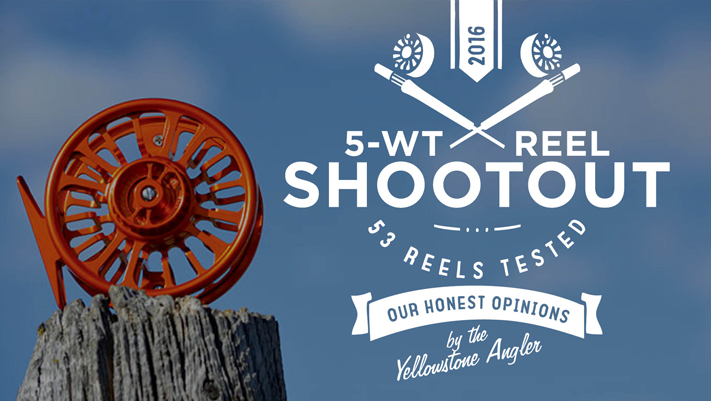
by: James and George Anderson
We learned a lot doing our 8-weight reel comparison back in 2014, but in considering and comparing 5/6 reels, however, there are some categories that are not as important in smaller reels – like ease of drag adjustment, ease of spool removal, and drag detents. Typically, when fishing a 5/6 weight outfit the angler will set the drag at one level and rarely change it. And for 5/6 reels, often using 5X and 6X tippets, this means setting your drag at only a half pound or less. The idea is to set your drag lightly enough so that if you hook a hot fish that burns out on 6X, you don’t get broken off on that first run. Moreover, we are using a floating line most of the time and not changing spools.
As in our other Shootouts and tackle comparisons, we felt that to get honest answers, we needed to be the ones taking the measurements, weights, determining backing capacity etc. We were not willing to take the manufacturer’s word or specs as gospel.
We also felt that when possible we needed to come up with real world tests that you can duplicate. Every manufacturer believes that they have come up with the best reel in the world. Ultimately what you believe is what really matters.
It’s our job to sort through the claims and advertising hype, and to give you our honest and un-biased views, so that you can make your own determination of what reel is best, and best for your fishing style.
Why Trust Our Opinion?
We fish a lot. Before work, lunch breaks, after work, and weekends. Its safe to say someone from the shop is fishing every day: only the worst winter weather days keep us indoors. Surprisingly we’ve had some pretty good fishing on days blowing 45+ mph, torturing ourselves with frozen fingers and toes for no good reason other than we are being stupid and like beating our head against a wall repeatedly. As such we are always facing equipment problems, the same kind every angler eventually encounters if they are stupid enough to fish year round.
Take a look at the charts, not just to learn our rankings, but to understand the pros and cons of each reel. Once you know what the chink in the armor is on a reel you like, (e.g. the drag range is relatively weak), does the rest of the reel impress you so much you don’t care?
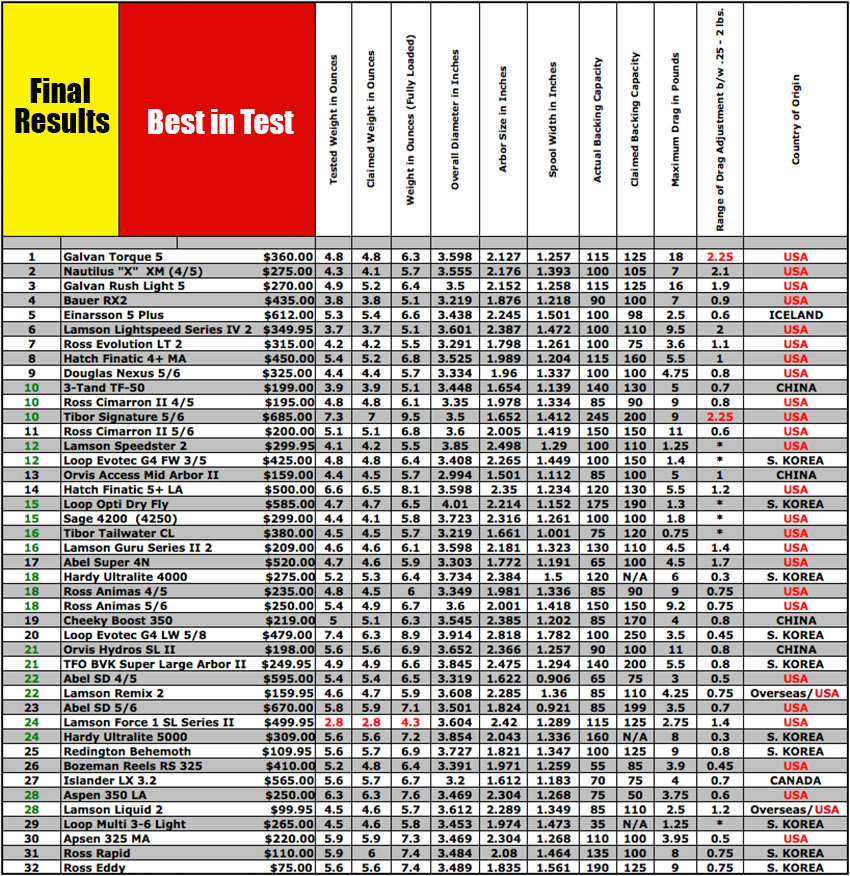
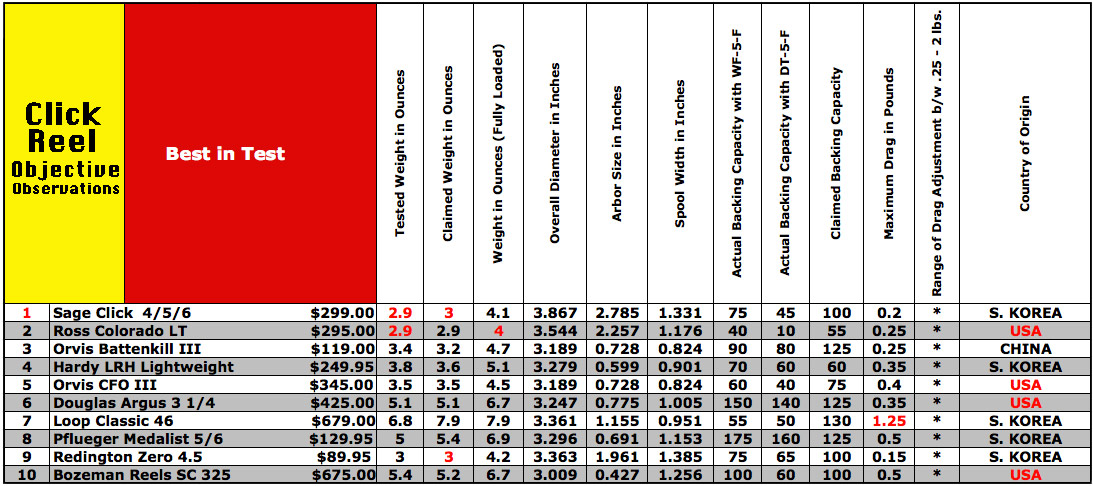
Categories Explained – Objective Observations
Weight in Ounces
Using our a digital scale that reads to .001 oz. We weighed each reel several times and then rounded up to .1 of an ounce to make it easier to read on our charts. In our chart on Objective Observations, you will see that we list our tested weight, the manufacturer’s claimed weight, and also the weight of the reel fully loaded with backing, line, and a leader.
Claimed Weight in Ounces
This is the weight in ounces that we got from the manufacturer, either from their website or on the phone with the company itself. You will see that in most instances their weight is the same as ours or within a tenth of an ounce. Sometimes you will notice the manufacturer’s claimed weight is well under our measurement, which is the reason we weigh the reels ourselves.
Weight in Ounces (Fully Loaded)
This year we wanted to give you some true drag range figures, as well as true backing capacities. So we loaded each reel with the optimum amount of backing and fly line and then weighed each reel fully loaded. Then we peeled off the line and got figures on the range of drag adjustment, smoothness, start up inertia, and max. drag. In the process we would rip some line off the reel and judge the drag sound.
We used 20 lb. Cortland Micron (Dacron) backing, a Scientific Angler’s MPX WF-5-F line, and a 12-foot 4X hand tied leader. Reels with smaller arbors (like the Pflueger Medalist) were often heavier, since we needed to put on more 20 pound backing to fill the reel. Reels with larger arbors, on the other hand, took less backing and consequently weighed less. How much backing do you need on a 5/6-weight trout reel? We feel that a minimum of 65 yards is OK but the standard is 100 yards of 20 pound backing. If you are comfortable with having only 20-30 yards of backing on your reel, then you can often go down one reel size. But the ones we tested are the reels we recommend with 65-100 yards of backing. You will see that in some instances, we did have two of the same reels in our comparison but in slightly different sizes to cover this range of 5 and 6 weight lines. You can decide for yourself if a smaller (and lighter) reel is better for your needs, or if a larger reel with more backing capacity is best for the style of fishing you enjoy.
In our performance chart we used the fully loaded reel weight rather than the naked weight since that’s how they are going to be fished. We found that in general, reels that weighed between 5-6 oz. fully loaded were a good match for balancing most of today’s lightweight 9 foot 5 weight rods.
Balance is a matter of personal preference, but we like the balance point high up on the grip, about where your thumb would rest. In testing our winning reel, the Galvan T-5, loaded with a WF-5-F line and backing, we mounted it on our top 9 foot #5-weight rod, the Loomis NRX LP. The balance point or fulcrum was 1 1/8 inches below the top of the cork grip, which is about where the center of my thumbnail rests when I grip the rod in the middle of the handle, putting my palm in the middle of the cork handle swell. So in general, the balance point should be well forward of the lengthwise center of the grip to give you the best feel.
For today’s modern lightweight trout rods, we feel that the lightest reels feel the best.
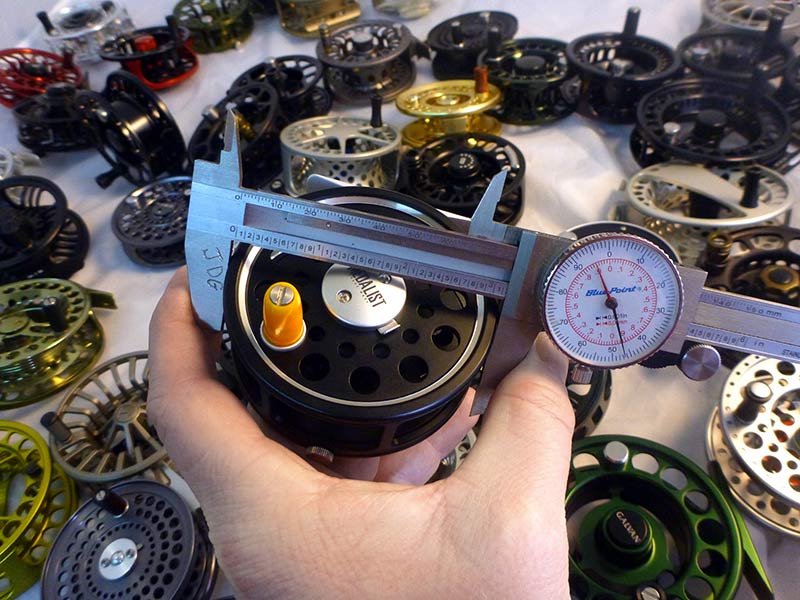
Overall Diameter in Inches
This measurement reflects how wide the reel is from one side of the frame to the other. In essence, it refers to the size of the reel’s diameter. The largest reel we tested was the Loop Evotec G4 LW 5/8 at 3.914 inches, followed by the Sage Click 4/5/6 at 3.867 inches. The smallest reel in the shootout was the Orvis Access Mid-Arbor II at 2.994 inches, followed by the Bozeman Reel SC325 at 3.009. We didn’t rate this category for points, but in general the larger diameter reels work better since they retrieve line more quickly (provided they also have a large arbor).
Arbor Size in Inches
This measurement refers to the size of the arbor (where the end of your backing attaches to the reel). Note this is a different measurement than overall diameter as it reflects the size of the arbor itself, not the outside of the reel. In general, wider arbor reels will retrieve line more quickly. Today most of the reels on the market have much larger arbors than the older classic reels like the Hardy LRH or the Pflueger Medalist. Keep in mind that a reel with a small arbor may have the same retrieval rate as a large arbor reel when loaded with the correct amount of backing. However once 30-50 yards of backing has been run off, the smaller diameter arbor reel is going to take much longer to reel in the backing. Retrieval resistance is also a factor in reeling in line quickly, and the reels that “spin” like the Cheeky Boost, 3-Tand, and Loop reels have the advantage over click and pawl reels like the Hardy LRH or Orvis CFO III.
Spool Width in Inches
Here we measure how wide the spool is (not including the frame). In general we like spools that are between 1-1.5 inches. Wider spools are usually better than narrow spools, since with the narrow spool reels you must pay attention to winding the line on evenly or it will tend to jam up eventually, causing you lots of problems, especially when you are trying to land a fish.
Actual Backing Capacity
Here’s another place where manufacturers often fudge figures in order to beat their competitors. From our experience, the optimal amount of backing is a good 25-50 yards less than what the manufacturers recommend. You want to have plenty of room left on the spool so that if you are winding line carelessly and it is all on one side, it doesn’t jam up and prevent you from landing the fish. There is nothing more infuriating than having a reel loaded with too much backing and line.
In our shop we keep a record of the precise backing capacities we have used for loading reels of different sizes and manufacturers. In order to judge the perfect backing capacity, we load the fly line onto the reel first, (starting with the leader end), and then add the exact amount of backing we feel is correct. Once this is done, we run it all off with our line winder, and wind it all back on ready to cast and fish. It takes a lot longer to do it this way, but then we know it is perfect. Then we mark these figures in our reference charts for loading each specific make and model reel. As always when reeling in at the end of the fishing day, be sure to reel up your line under the pressure of your pinky to ensure the line isn’t loose on your reel – without proper pressure your reel may become overcrowded.
Claimed Backing Capacity
These are the specs we get from each manufacturer. Sometimes they are correct. Most of the time they are not. We found a couple of reels that were more than 100 yards off!
Maximum Drag in Pounds
This is easy- we just crank the drag adjustment all the way down and get a measurement off our Bouz Drag Checker.
Note however, that maximum drag is almost meaningless on these 5/6 weight trout reels. No one in their right mind is going to use more than 2 pounds of straight pull drag, even using very heavy tippets, as we do when streamer fishing. Keep in mind that if you set your reel to give you one pound of straight pull drag, once you put a big bend in the rod, this increases the drag substantially while you are playing fish. When I’m fishing, using 5X tippet, I am only using .25 lb. of straight pull drag. If I need to apply more drag, I’ll palm the reel carefully to increase the drag load, rather than re-adjust the drag.
Range of Drag Adjustment
This is something we feel reel companies should get right – so we gave this category 20 points in our scoring. We used a range of .25 lb. to 2 lbs (since that’s what we felt you should use 95% of the time for a 5-weight trout reel). First we set the drag at .25 lb. and then we marked the drag knob, and noted how much of a revolution (or more) we could make on the drag knob until we got the 2 lbs. of drag. The best reels will give you 360 degrees (one full spool revolution) or more of drag adjustment in this range. The best reel in our comparison, the Galvan Torque, gave us a range of 2.25 revolutions! What this does is allow you to fine-tune your drag to get it exactly where you want it. The worst reels in this category, the Hardy Ultralites, gave only .3 (or 1/3 of a revolution) in adjustment – which was often only a couple of clicks on their detents, making it tough to get the drag set the way we liked it. Still, having some adjustment was better than nothing as on the Redington Zero and Bozeman SC.
Smoothness of Drag at 1 lb.
Most of the reels that rated a 9 or 10 had extremely smooth drags. A few however, were not smooth at all, and you could easily see this with the needle of the drag checker bouncing up and down as it hovered around 1 pound. You could also feel it in your hand, pulling backing off the reel. We tested this at 1 lb. of drag since variation in drag smoothness tends to show up as you increase the pressure. At the lower drag pressures for normal fishing, differences in smoothness are going to be negligible.
Start Up Inertia
Start up inertia is the initial drag resistance you feel when you start to pull line off the reel. For almost all of the reels in our test, there was no start up inertia. We did note a small amount in reels like the Tibor Signature and the Abel Super 4N, both of which use older style cork disc drags. But the amount of start up inertia on these reels was nothing to worry about (unless you have your drag cranked down over 3 pounds or more). Only the inexpensive Lamson Liquid 2 showed a dramatic increase that could cause a problem for light tippets at a normal drag setting.
Explanation of the Points Categories
Price- 10 points available
This is pretty simple. The least expensive reels get the highest points. Price is certainly an important factor in deciding which reel to purchase, but higher priced reels are usually worth it in the long run; even if you have to save the money to buy the reel you really want. Buy the best reel you can afford and you will never regret it. Hopefully after you’ve used it for 10 years, or even 20, you’ll pass it on to your children, or someone who will really appreciate it.
Craftsmanship – 10 points available
We are pleased to tell you that craftsmanship has improved dramatically over the past few years. Many of these 5/6 weight reels we tested are machined from a solid block of high-grade aircraft aluminum and then anodized with very hard finishes. Even the relatively inexpensive reels made in Korea or China offer high quality machining, anodization, and good attention to detail. Still, craftsmanship varies and is very observable. As you’ll see, nearly all the manufacturers rated a 9 or 10. We gave out a lot of perfect 10’s here and we felt they were justified since the quality of machining and anodization was superb. If we had to single out a few reels as the best of the best, Galvan, Nautilus, Einarsson, Orvis, Bauer, Ross, Hatch, Hardy, Tibor, Abel, Loop and Sage come to mind.
But there is some junk out there too, so beware of the reels that score 7.5 or less. Most of these reels are cast rather than machined. Which means instead of machining the reel out of a single puck of aluminum, the metal is melted and then poured into a mold. Many of these molds are pressure molds, which make the reels stronger but the integrity of the metal (or plastic) can’t compare with the overall strength and integrity of machined reels.
Durability – 10 points available
We’ve all bought inexpensive products, only to have the cheap stuff fail, and to realize we’d have been happier with something better. With fly reels, durability can be a big factor. Durability is definitely somewhat subjective, but it isn’t rocket science either. Machined reels are going to be far tougher than cast reels. Remember how easily those old Hardy spools and frames would bend? That was because they were cast aluminum, not machined, (the new Hardys are machined). We found in general that durability in the new reels very good but it is still a compromise. The heavier reels will generally take more abuse when it comes to slamming them into riprap or dropping them in a paved parking lot. The lightest reels will require more caution for sure, but they are usually delightful to fish – especially when fished in combination with a very light rod. The new Sage Click is perhaps the best example. But accidents happen.
Usually a good fly shop will be able to true up a bent spool (in the same way a good mountain bike shop might true up your wheel). That being said, if you are traveling half way around the world on a trip and to a destination where there is no fly shop, it’s a good idea to take along a reel that is going to be tough, durable, and reliable, or at least, bring two of the light weight reels.
Warranty – 10 points available
Just like rods, if you fish hard and long enough you may eventually run into problems with your reel. Accidentally dropping your reel when it is not on the rod can bend the foot. On the reels that do not have totally sealed drags, water can get into the sealed ball bearings. You can trip on the rocks and bend something beyond repair or even break your handle clean off. Luckily all of the manufacturers offer a Lifetime Warranty (for the original owner only)against all defects or problems that might arise, like water entering the bearings. We examine how much it will cost you (at minimum) to send your reel in and have the manufacturer repair and return it. In all cases you are responsible to pay for the shipping to the manufacturer, usually about $15.00. The actual repair and return shipping charges are generally going to be between $0 to $45 for minor repairs or replacements. In the best cases all you have to do is get your reel to the factory and the rest is on them (including parts, labor, and return shipping).
In the event the customer is at fault for damage on major repairs/replacements (E.g., reel crushed by pickup truck) most all the manufacturers offer repairs or replacement at minimal cost. These major repairs however require case-by-case evaluation. However, in our shop experience with repairs most all the manufacturers are generally more than fair with their fees as they want to keep loyal customers.
Reel Warranty Summaries
We are unaware of any manufacturer that does not honor a one year replacement or repair warranty for manufacturer’s defects. Turnaround times and extended warranties are based on our experience in the shop.
3 Tand – $0 (including repair costs and return shipping). Turnaround time is usually 5-6 days including shipping.
Abel – Generally $20 (including shipping). If major parts need replacement, cost may increase. Turnaround time is usually 10 days, to two weeks.
Aspen Reels – $0 (including repair costs and return shipping). Turnaround time is typically 5-8 days including shipping.
Bauer – Generally $18, (including shipping). On older models there is a service rebuild, ($50 plus $18 shipping). Turnaround time for current models is typically 3-10 days including shipping. http://www.bauerflyreel.com//wp-content/uploads/Service-and-Repair-Form-v3.pdf
Bozeman Reels – $0 for cleaning and relubrication, (does not include shipping and handling charges). Lifetime warranty covers parts and labor for the original owner only. Warranty doesn’t cover loss, misuse, or improper maintenance of the reel.
Cheeky – Generally $0 unless a major part requires replacement, (including shipping). Turnaround time is 4-6 days including shipping).
Douglas – Generally $25, (including shipping). Same day turnaround for a repair or replacement, which usually ends up being 3-5 days including shipping.
Einarsson – Sliding scale on repair costs, depending on which parts need repair or replacement. Turnaround time is typically less than two weeks.
Galvan – $0 For original owner, (including shipping). Turnaround time is about 2 weeks including shipping.
Hardy – Generally $35, (including labor, processing, and shipping). Material defects and workmanship are under warranty for a period of 5 years from the date of purchase, replacement/repair at no charge including shipping. Turnaround time is less than two weeks.
Hatch – Generally $0 unless a major part requires replacement, (including shipping). Turnaround time is about 2 weeks including shipping.
Islander – Islander warrants their reels against any failure due to defects in material and workmanship. The warranty applies only to the original owner and is valid only if the reel has been cleaned and maintained according to the maintenance instructions. If deemed under warranty, return shipping costs are paid by Islander. Turnaround time is generally 2 weeks, and up to 3-4 weeks during the fishing season.
Lamson – Generally $20, (including shipping). If a dealer sends the reel in then the repair cost is $10. Turnaround time is up to 2 weeks max (including shipping).
Nautilus – Generally $45, (including shipping). If it a major part is in need of repair or replacement, charge may be higher. Turnaround time is 10-15 business days including shipping.
Loop USA – Generally $30 + freight. Major repairs may incur higher charges, usually about $60. Turnaround time is typically 3-6 days including shipping.
Orvis – Generally $30, (includes reel service, lubrication, and return shipping). For reels repaired due to material defects or workmanship there is no charge. Turnaround time is typically 2 -3 weeks, (including shipping).
Pflueger Medalist – $0, (includes shipping). Warranty for the original owner only, for a period of 1 year after the purchase date. Turnaround time is less than two weeks.
Redington – Generally $15, (including shipping). Turnaround time is typically 2-3 weeks including shipping.
Ross Reels – Generally $30, (includes shipping) Reels are inspected individually to determine repair fee. After the first $30, every additional reel is $5. Turnaround time is up to 2 weeks max, (including shipping).
Sage – Generally $25, (includes shipping). Turnaround time is typically 2-4 weeks including shipping.
Temple Fork Outfitters – Generally $30 for major repairs, or $0 for minor repairs. Shipping is included on major repairs, for minor repairs shipping is charged. Turnaround time is typically between 4 and 7 days including shipping.
Tibor – Generally $35, (including minor parts, servicing, lubrication, and shipping). Turnaround time is about 2 weeks including shipping.
Maintenance Free – 10 points available
Most of the reels we tested have well sealed drags and require very little care to function perfectly. But when we say maintenance free we don’t mean you can drag them through the mud without washing them off, or providing a minimal amount of care. And if you are fishing with any of these reels in saltwater it is important to spray them off or give them a quick flushing in fresh water at the end of the day. Over time you should remove the spool and clean out all the junk inside. An old toothbrush works well for this. Windex also works well for squeaky spindle shafts.
Reels that utilize cork drag systems like Tibor, the Abel Super series, and the Islander require a little more TLC. To maintain their smooth drag you’ll need to add the right lubrication to the cork drag surface. This will not have to be done often, but at least after each weeklong fishing trip. Also, if your reel gets submerged it doesn’t hurt to take it apart, clean it and re-lube. Those clicker pawls in both the Tibor and Abel reels need lube occasionally, and the little ball bearing detents need oil. Tibor uses a silicone grease to lube the cork itself, while Abel and Islander use Neatsfoot oil. Many of the trout reels we tested have bronze bushings that need to be oiled now and then to keep them performing perfectly. But be careful not to over-oil these reels. Ross tells us that 90% of their reel repairs are due to over lubrication! Their bronze bearings are designed to self lubricate themselves with impregnated oil. Never use something like WD-40 as a reel lube. If your reel does not have a totally sealed drag, you’ll want to use a minimal amount of oil, like 3 and 1 oil, to lubricate the arbor. For click reels like the Hardy, Orvis, and Tibor, you should also lubricate the clickers and gear with good grease. Tibor makes their own silicone grease for their clickers and cork drag surfaces, which most good fly shops stock or can special order for you.
Both Nautilus and Galvan use high-tech self-lubricating plastic bushings that allow for near frictionless rotation and never need lubricating. The bottom-line, if you like to play with your gear (and you’re mechanical by nature) you may enjoy a reel that requires more upkeep. Otherwise, maintenance free is the easiest way to go…
Spool to Frame Tolerances – 10 points available
Here we are looking at gap (tolerance) between the spool and frame. Reels with larger tolerances often have a large enough gap to risk having the running line, shooting line or backing getting caught between the spool and frame, or worse, getting behind the spool or in the case of half frame reels, getting outside the frame. When any of this happens you are forced to stop fishing, remove the spool and straighten things out. Otherwise you will break off the next fish, ruin your line, or both.
In general, closer tolerances are best, but if they prove to be too close, any little fall on the rocks can bend the rim of your spool enough to cause it to lock up or rub badly on the frame. This is never easy to fix, even in the shop, much less on the stream.
Our assessment here was based on simply observing the gap between spool and frame. This was a subjective observation. I guess we could have used a feeler gauge, but eyeballing it seemed to work fine.
Start up Inertia – 10 points available
Start up inertia refers to the initial amount of drag experienced when pulling line off the reel. Ideally a reel will have zero start up inertia: Line peels off the reel smoothly, without any tendency to release quickly and perhaps cause a backlash. A drag with close to zero start up inertia allows you to gain perfect control of the fish immediately once you have allowed the fish to run out any slack line that you have stripped off of the reel. Once the fish is on the reel, you want to try to continue to play the fish from the reel – especially larger fish. If the fish runs back at you very quickly and you cannot keep up by reeling, then you have to start stripping and repeat the process of getting the fish on the reel again. Drags with zero start up inertia result in a smoother, more controlled fight.
In trout fishing with these 5/6 weight reels, often you are stripping in small trout and releasing them without ever getting them “on the reel”. That’s why good drag systems and low start up inertia are more important on saltwater reels than they are on trout reels, and as a result this category only carries a 10 point reward.
Drag Detents – 10 points available
Drag detents are small divots machined into the drag system into which fit tiny spring-loaded ball bearings or plastic clickers. In other designs some other sort of friction device is used that will help your drag knob retain its set position. Once the drag is set, you don’t want it to get accidentally knocked off its setting by rubbing against your clothing, or that log you crawled over to get to the stream. If your drag gets knocked off its setting bad things happen. Your drag can back off to zero, causing your reel to freespool or backlash, or worse add more drag pressure and break off a nice fish.
Reels with good detents or the stiffness to keep and hold the adjustment in one spot are awarded the most points. In general, good detents are a lot better than none at all.
Drag Sound – 10 points available
Reels like the Hardy LRH, the Orvis Battenkill, Orvis CFO, the Douglas Argus, Pflueger Medalist and Loop Classic 46 all use metal clicker pawls that make a pleasing sound when the fish are running, or when you are retrieving line. Most reels make a softer click sound when you are retrieving line, and a louder sound when the fish are running, although some are the exact opposite. Today, almost all of the new reels have tiny plastic clickers or sound making devices that emit very little noise. If you are hard of hearing like George after years of dirt bikes and guns, they make no noise. Ha-ha.
Some reels definitely sound better than others but as you’ll see, we gave most reels in the standard reel category a score of 7 or 8. The click reels generally rated a 9 or 10. The Sage Click reel uses plastic clickers that sound good and can easily be replaced. To my way of thinking, most of these new reels need to produce more click sound than they do. And the sound when retrieving needs to be different than the sound when fish are running to help the guide understand what the fish is doing so he can position the boat correctly.
Retrieval Resistance – 10 points available
Retrieval resistance refers to the tension one feels when reeling in. The best reels have little or no resistance. Resistance when reeling in is annoying, and at higher levels results in unnecessary fatigue. The spey guys love to have a freewheeling design so that they can whack the handle or spool and spin up a bunch of running line quickly. This is impossible with a reel that just does not turn easily. More and more trout and saltwater anglers are using techniques like this. The reels with very little retrieval resistance were more pleasant to use, and presented few problems that we could identify.
Ease of Spool Removal – 10 points available
The ease of spool removal is important. We’ve found if something can go wrong in the field it will. Should your line, and especially the tippet on your leader, accidentally slip behind your spool, or through one of the spool to frame tolerance spaces, (or if you get junk or sand stuck in your reel), you are going to need to remove your spool, fix the problem, and replace the spool. Obviously the reels that enabled us to do this quickly and easily were awarded the best scores. Reels like the Abel Super 4N that require a penny, or screwdriver, lost a lot of points here. Reels like the Loop Classic 46 or Bozeman Reel SC that require the removal of several tiny screws lost even more points.
If the cap you unscrew comes completely off you must be careful not to lose it. Reels with caps that come off lost points too. Losing the cap or other washers etc., can render your reel unusable, and turn your trip into a disaster. The Lamson reels are designed so that you have to pull hard to take the spool off – too hard in many instances. We have also seen Lamson reels that have seen a lot of use become even more difficult to remove the spool, and this can be frustrating.
Reel Case Design – 10 points available
Reel case design is perhaps the least important category in which we awarded points. Having a good reel case will help protect and preserve your reel when you are finished fishing. Rarely do people use reel cases when fishing, even in drift boats. Most reel cases today are neoprene and are very effective at protecting reels. The Hatch reel cases had some of the coolest color combinations, but sadly they don’t cover your reel completely. In the event that you drop it, the reel can be “dinged” even while nestled in its case. We love the Abel reel cases, which are easy to slip on and leave on your reel, even while attached to your “rigged and ready” rod.
Ease of Drag Adjustment – 10 points available
For most trout reels,you are going to set the drag in one position and not change it. But if you do want to change it, how easily can you adjust your drag while playing a fish? It’s one thing to set your drag to a preferred resistance level before you start fishing, but an entirely different situation arises during the heat of battle. Sometimes you need to make a quick and precise drag adjustment. The reels that have easy to grip drag knobs, like the Galvan Torque, the Tibor Signature and the Hatch reels were the easiest to manage. Smaller drag knobs were more difficult to adjust, as were drags knobs that were more difficult to turn (e.g., Lamson Guru).
Performance Categories – Double Points
For the 5/6 weight reels, these categories are the ones that we felt are the most important; so we are giving them double points.
Range of Drag Adjustment – 20 points available
In order to determine the range of adjustment, we decided that the usable range to measure would be .25 lb. to 2 lb. of straight-pull drag pressure. .25 lbs. of drag pressure is about what you want to set your reel using 6X tippets. 2 lbs. is suitable for 15-pound tippets, fishing streamers, mindful that drag pressure increases somewhat when you put a big hoop bend in your rod.
For example using a NRX LP 9 foot #5 rod and a Galvan T-5 reel. We set the drag pressure to .25 pounds on our Bouz Drag Checker. With a big hoop bend in the rod the drag pressure increased to .6 lb. Set at .5 lb. (4x pressure) it increased to 1.25 lb. Set to 1 lb., it increased to 1.75 lb. Finally, set at 2 lbs., it increased to 3.0 lbs. once you had a big bend in the rod.
Playing fish, it is always best to set a drag light rather than change the drag pressure. If you get the fish on the reel, palm the rim to increase drag pressure. If line is running through your fingers, simply tighten your fingers or grip on the line. When applying more pressure to the line, be sure to do this smoothly, as big fish hate jerky sensations on their end of the line.
To obtain the figures for the range of drag adjustment using our drag checker we set the drag coming straight off the reel at .25 lb. We marked the drag knob with white tape positioned straight up, towards the reel foot. We then rotated the drag adjustment knob until we got a constant drag pressure of 2 lb. on the Drag Checker. We then noted the total rotation in increments of .1 revolution. The best reels in our Shootout were the Galvan Torque 5 and the Tibor Signature 5/6 at 2.25 revolutions. This wide range of adjustment allows precise tuning of the drag to the desired pressure. When fishing fine tippets like 6-7X, this becomes critical. The best reels in our Shootout had a range of adjustment of at least one full revolution of the drag knob. The worst, the Hardy Ultralites had only .3 of one revolution. We converted our measurements to points. The Galvan got a 20, while the Hardy Ultralites got only a 10.
Smoothness of Drag – 20 points available
When you get a big fish on the reel, you want the drag to be as smooth as possible. A smooth fight is a good fight. The angler needs to be in complete control, not worrying about massaging a crappy drag. Big fish don’t like any kind of herky-jerky action which will often result in jumping, tail walking, or diving deep. While the visual effects of these harsh moves can be stunning, the result is often a lost fish.
A smooth drag gives the angler confidence, and establishes control much like having a set of good Brembo brakes on your motorcycle or sports car.
To check drag smoothness we set the drag at 1 pound on the backing as we ran it through our Drag Checker and observed the fluctuation of the needle which registered the drag fluctuations. The smoothest drags didn’t move the needle at all. The rough drags made it stutter like crazy. And on the rougher drags it could easily be felt in hand as line peeled off the reel.
When we cranked the drag upwards towards 2 pounds of drag, a lack of smoothness became much more apparent. So if you are using heavy tippets, you are going to want a reel with a smooth drag.
Handle Design – 20 points available
As we fished a variety of reels, we realized how important this category is. Reels with larger, easy to grab handles like the Galvan Torque, Bauer RX2, Einarsson 5 Plus, the Nautilus X, and the Hatch were a godsend, while shorter, smaller handles like those on the Hardy LRH or Orvis CFO III proved to be more difficult to grab and reel with. You want to have a handle that you can grab quickly, and one that you can crank on hard without your fingers slipping off or getting fatigued. Longer, larger handles that were concave or with an outward taper felt and performed the best.
Fun to Fish / Got to Have – 20 points available
As with our rod shootouts, we got this category from the original Car and Driver automobile shootouts. We found that some reels are just a lot more fun to fish than others. And some reels are better looking than others. Any reel that we rated an 18 or better is a real pleasure to fish. If the reel looks like a million bucks and performs like it too, any “normal” fly fishermen is going to want it. For many, the most expensive reels are perhaps a status symbol even if they aren’t the best in performance. For others, they see how the reel performs in their guide’s hands, and think that it is going to make them great anglers too, or at least take them to the next level. Surprisingly enough, they are often right. Don’t let the price slow you down. Too many people get an inexpensive reel and then find that they made a mistake and go right back out to buy the best. Don’t waste your money on an inferior reel. A good reel will last a lifetime, so don’t skimp. Get a good reel the first time and you won’t regret it
Custom Paint Jobs
The #1 reason to pay more for a 5 weight reel? Because you like the custom paint job. Nothing pimps out your reel like some colorful design shine.
If we had made this a 20 point category the scores would have looks as follows: Abel – 20 everything else, 10 or less. No one in the reel industry comes close to Abel’s ability to customize a fly reel. We know it, their competition knows it, and they know it, (as seen by their steep upgrade fees). Pick an artistic or fish graphic and plan on as much as $500 for a custom, hand painted upgrade – on top of a reel that already costs over $500.
Choosing a Reel
When I go trout fishing, rarely do I hook a fish that is “worthy” of playing on the reel. More often than not I catch a fish, realize its not the “one” and proceed to “strip” the fish in quickly in order to release it.
There isn’t a single reel in the shootout that can come close to reeling in line as fast as I can strip line in. For 75% of my trout fishing I don’t need a drag, I just need something to store my line and allow me to pull line from it to cast further or mend more line to keep up a dead drift. Every single reel in the shootout was satisfactory for me in this light; simply as a line storage device.
For the remaining 25% of my fishing, when I’m lucky enough to hook a larger trout I want to get the fish on the reel, and if the fish runs, it will then pull line out controlled by the amount of straight pull drag I set. I’ll set it light, knowing that I can easily over-ride the drag by palming the reel. The main reason for getting a big fish “on the reel” is so that my line doesn’t get tangled around something and break me off. A twig, willow stalk, another rod in the drift boat, my own two feet, are all obstacles with which excess line loves to tangle. Sometimes I’m lucky enough to see the tangle happening, and manage to somehow get the line free while the fish is running. Most of the time I know I’m screwed and the stressful moment ends in a snap of tippet. Depending on the size of the fish I choose an appropriate expletive.
I believe there are a few reels in the shootout that enable me to get excess line on the reel more quickly than others. Once the line is on the reel the fish is directly linked to the pressure of the drag, which is more reliable and smoother than letting the line slip through my fingers, especially if a tangle occurs. I like smooth drags that will apply up to around 3 pounds of pressure for larger trout. Obviously the number one factor here is the tippet size and what you can get away with. If I’m fishing heavier tippet (3X or thicker) and I’m fishing with a reel that doesn’t have a strong maximum drag, then I simply override the drag by “palming” the reel, or even by adding more pressure to the line coming off the reel, using my fingers. Palming a reel as a fish blasts away at a high rate of speed is actually a lot of fun. It requires practice and skill, but in the end you are actually more involved and connected to the fish than when the reel does all the work.
So for me, having a reel that can bring in excess line quickly is more important than owning a reel with a strong drag. But I also want a reel that is durable and is not likely to get mushed should I take a fall while walk-wading a rip-rap bank.
Helping you find a reel with the most positives is the goal of this shootout. Hopefully it will help you decide what appeals to and what works best for you.
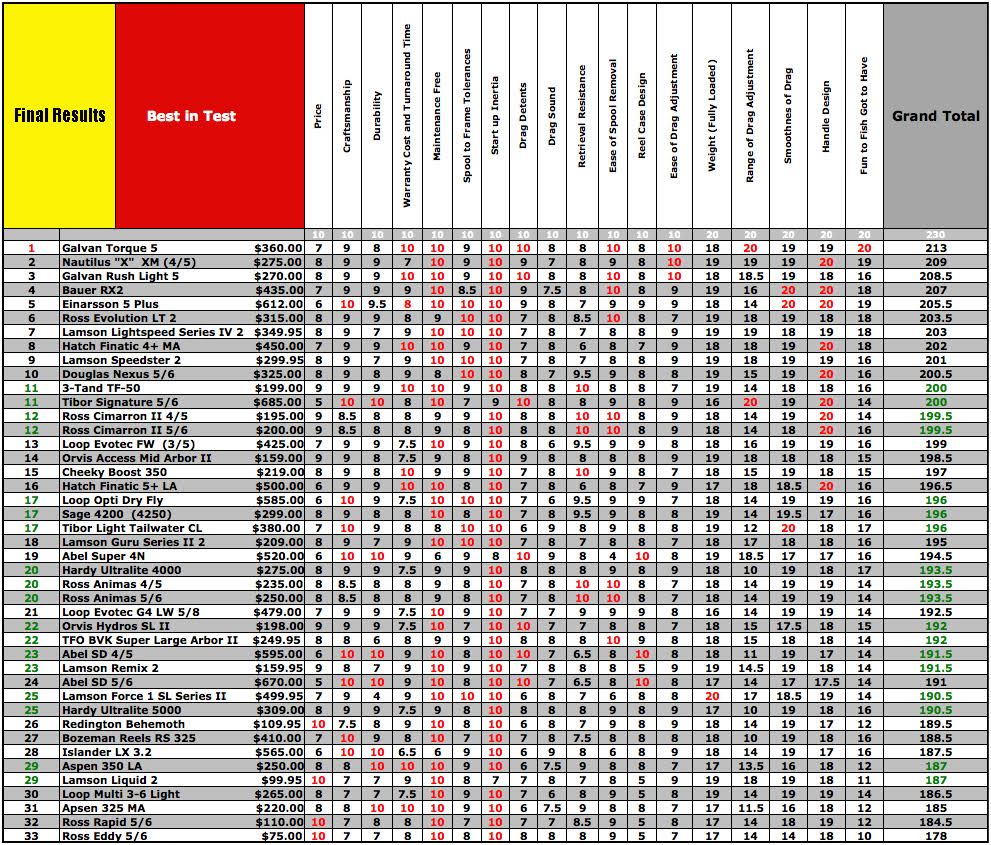
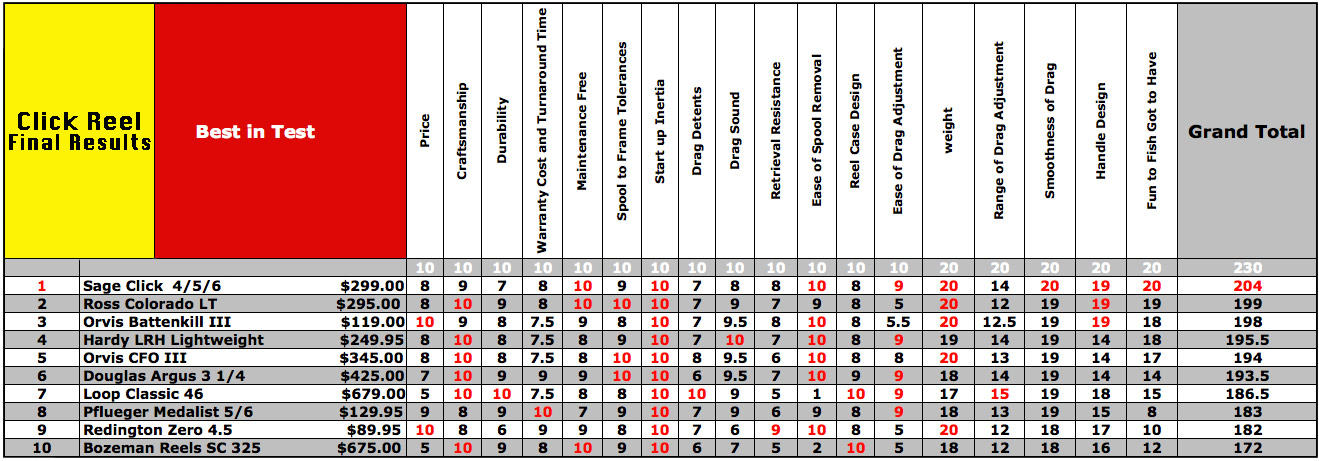
Below you’ll find our finishing order as well as my comments. Be sure to check back later as we hope to add some videos, so you can hear for yourself what the drag and retrieval sound like as well as see how the spool is removed, how well the reel spins, etc.
We have laid out all the objective measurements in the shootout that follows, and our own views of what we prefer. We hope this will help you select a reel ideal for your purposes, and encourage you to buy one from your favorite fly shop – or if you like what we’ve done here, buy a reel or an outfit from us. We’ll be glad to offer you our suggestion for which rod best suits the reel you select. There’s a link to purchase from us at the end of the shootout, or you can click on each reel’s name or individual photo. Either way, tight lines!
#1 Galvan Torque (T-5) $360.00 – reel, $170 x/spool
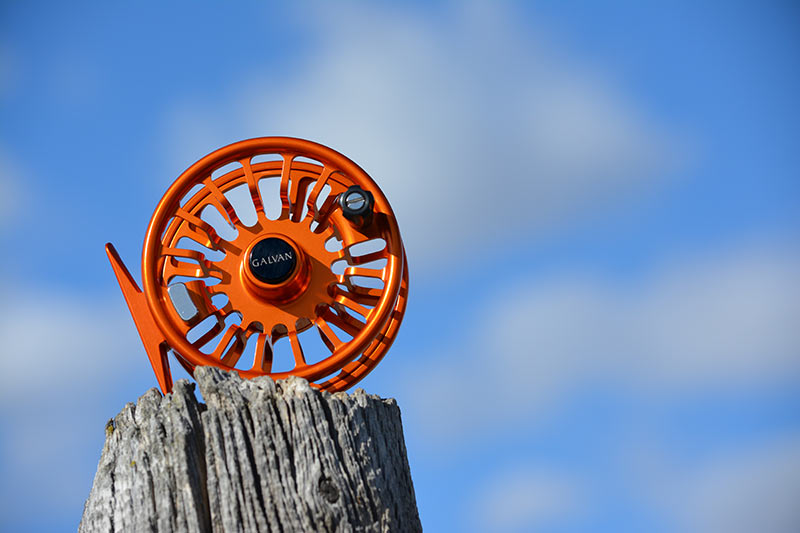
We know how great the Galvan Torque reels are after seeing how well the Galvan T-8 did in our 8-weight reel shootout. The T-8 scored well in nearly every category, and was an easy choice for our “best buy” 8-weight saltwater reel. We knew the Galvan T-5 was going to bring some serious competition, and I don’t think any of us was surprised when we added up the figures and saw that it cleaned everyone!
Other than price, ($360 – which is still reasonable for what you are getting), Galvan excelled in every category. As such it is a very well rounded reel with very little that can go wrong with it.
Galvan is using polymer/Rulon bushings that require no maintenance and no lubrication. This bushing system is very light, strong, and reliable – which means the reel remains light yet durable. All Torque reels are machined from T6 solid bar stock aircraft grade aluminum that is tempered to significantly increase its strength. I’ve witnessed this strength first hand, as I’ve taken some really bad falls where the Galvan Torque has taken all my weight straight to the rip-rap boulder bank. Although I’ve put some good “dings” in the edge of the reel, I’ve never once had the spool bend out or get crushed like other reels in similar falls. Galvan has done a great job at finding the perfect strength-weight ratio.
The max drag on the Galvan T-5 is absolutely insane (and unnecessary) but what is even more impressive is the T-5’s head scratching range of drag adjustment. Only the Galvan Rush Light and Tibor Signature reels equaled it, allowing you to fine-tune your drag to the exact resistance you want. The drag is also one of the smoothest drags in the shootout, even at heavier settings that you would never fish trout with. The EZ grab handle works perfectly and is easy to grip (even without looking) and the spool release button is one of the quickest and easiest to use.
In short, we love everything about the Galvan T-5 and think you will too. There’s no extra charge for different colors, so if you want to bring a little more “bling” to your setup you can do so at no additional cost.
NOTES:
Retrieval Sound: Nice loud metallic / plastic retrieval sound
Outgoing drag sound: Muted, more quiet outgoing sound
Spin: Some (1.5 -2 rev)?
Counter balance: Excellent
Spool release button: depress style like Evolution LT – can never lose
Drag knob: easy to adjust
Drag Detents: Drag knob could possible get knocked off on lowest drag settings, Detents are great from 1 pound up.
Max Drag: AMAZINGLY STRONG!!! – 15+ pounds!??
Range of drag: HUGE!!!
Handle – A tiny bit short, but wide at the end where you need it and still very easy to grab
#2. Nautilus “X” (XM 4/5) $275.00 – reel, $145 x/spool
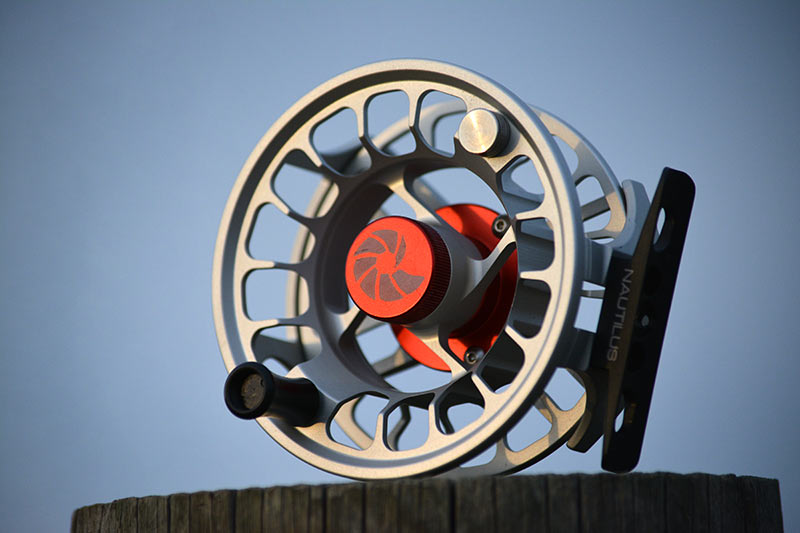
Nautilus has been on a real hot streak lately, with the NV G 8/9 winning our 8-weight reel shootout and the X reel winning best of show in both fresh and saltwater categories at the 2015 ICAST. We all were thinking that their new X reel was going to take top honors as the next best 5-weight reel – and it was close! The X reel is light yet burly, with an impressively wide range of drag adjustment. It feels great in your hands with a very easy-to-grab handle shape. The drag knob is much easier to turn than the old FWX models and despite the X reel’s drastic cutouts, it is feels more durable.
The X Series reels are fully machined in Miami, Florida from the highest grade aircraft aluminum available. The X reels come in two standard colors, Clear or Black. For an extra $100 you may choose from several custom colors; Blue, Green, Orange, Pink, Red, Purple, or Violet. Extra XM spools retail for $145.
NOTES:
Retrieval Sound: Plasticky sound reeling in (slightly louder than outgoing)
Outgoing drag sound: Same basic outgoing sound (slightly softer)
Spin: Decent, (1.5-2 revs)?
Counterbalance: Great
Spool cap: One of the best – easy to turn, comes off quickly, can’t get lost. (Much easier to turn than the NVG spool caps).
Drag Knob: Easy to turn
Drag Detents: Solid
Range of Drag: Excellent
Max Drag: Very Strong – 7 pounds
Handle: Excellent size, outwardly tapered handle shape
#3 Galvan Rush Light (R5 – LT) $270 – reel, $130 x/spool
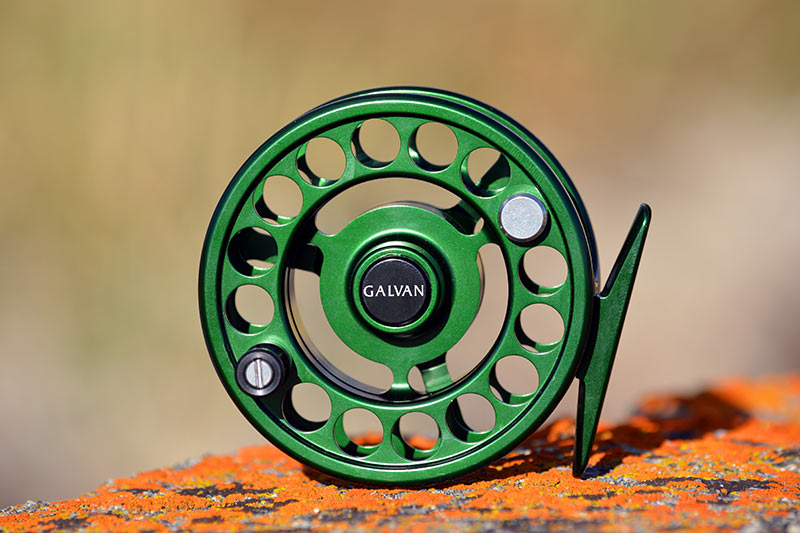
Here lies the true sleeper of the test. The Galvan Torque is such an impressive reel that its shadow causes people to overlook Galvan’s more affordable offerings. What is amazing about the Rush Light is that it encompasses nearly everything the Torque has and is arguably more durable but is less expensive. In fact, it tied the Galvan Torque series in 14 out of 18 point categories! Like the Torque, the Rush Light has a terrific range of drag adjustment with a similarly insane amount of maximum drag. It’s the perfect blend between light enough and extremely durable.
Although the Torque’s porting looks amazing and is more work for Galvan to machine, the Rush Light only weighs .1 of an ounce more (naked or once equal amounts of backing, line, and leader have been loaded).
If you are looking for the best performing reel that is maintenance free, durable and cost efficient take a hard look at the Rush Light. The main reasons to upgrade to the Torque are its good looks, a slightly easier to grab handle, a ported arbor (which helps air dry your backing faster), and the overall attractiveness of the Torque’s ported “spokes.” As with purchasing a car, only you can decide if the “sunroof and upgraded rims” are worth the extra coin.
The Rush Light reels are precision machined and assembled in Sonora, California by the Galvan family. Choose among three standard colors: black, clear, and green.
NOTES:
Retrieval Sound: Slightly more muted, (more quiet) sound then the Torque
Outgoing drag sound: Sounds even more muted going out
Spin: Some (1.5 -2 rev)?
Counterbalance: Excellent
Spool release button: Depress style like Evolution LT – can never lose
Drag knob: Easy to adjust but not cut out like the Torque
Drag knob could possibly get knocked off on lowest drag settings, can’t on higher
Max Drag: Amazing Strong – 12 pounds
Rang of drag: Huge!
Handle: Nice shape, concave in middle, easy to grab
#4 Bauer RX2 $435 – reel, $205 x/spool
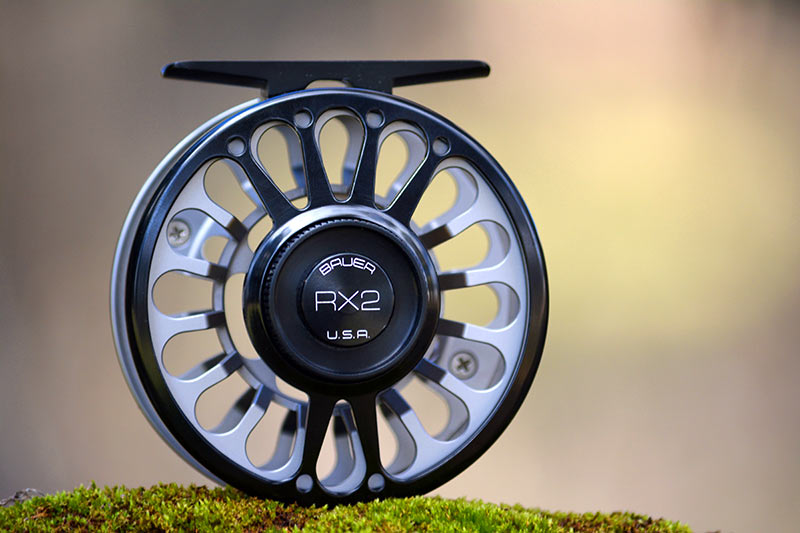
Here’s another great reel and surprise finish. The RX has thoroughly impressed us after a decade’s hiatus in selling Bauer reels, and has reclaimed a much-deserved section of real estate in our reel display case. There are many things about the RX reels that exhibit perfection, but at the top of the list is the incredible smoothness of its sealed drag. A smooth fight allows the angler to reel a fish in more quickly, which gets the fish back to the stream unharmed – something Bauer cares about deeply. Although the RX reels are more expensive than others, for each reel sold, Bauer donates 10% to conservation and fish restoration. Our hats go off to Bauer for making a difference and giving back to the resource we all enjoy.
Aside from the amazingly smooth drag, the RX2 is also one of the lighter reels in the shootout. Fully loaded it weighs only 5.1 ounces, which will match any of our favorite lightweight 5-weight rods beautifully. The arbor is well ported, which will allow air to dry your backing quickly. While the range of drag adjustment might not match a Galvan or Tibor, I believe it’s more than sufficient for trout fishing. I love the large drag knob on the back, which is easy to find and adjust. Spool removal is a piece of cake thanks to the quick release button (which can never get lost unlike a “star drag” knob). The attractive rosewood handle is agreeable and easy to grab without looking. All and all the RX is a very well thought out reel with purpose and elegance; lightweight, durable, and ready to perform.
Precision machined in Ashland, Oregon, the RX reels are made from aerospace bar stock aluminum and stainless steel for maximum strength and corrosion resistance. You can upgrade you spool color to Havana Gold, Coral Red, Copper Orange, Agate Green, or Cobalt Blue for an extra $35, or change the color of your sealed drag hub to gold, red or blue for an additional $25. Extra RX2 spools, (in the 3 standard colors: black, pearl grey, and titanium) retail for $205.
NOTES:
Retrieval Sound: Silent
Outgoing drag sound: Pleasant but muted metal on metal out going drag sound
Spin: Some (1.5 -2 revs)?
Counterbalance: Excellent
Spool release: Easy to take off, can’t lose it
Drag knob: Easy to adjust, until the very highest settings
Range of Drag: Huge
Max Drag: Very strong – 7 pounds
Handle: Attractive rosewood, nice length and outward taper at the end
Classic look and feel – tons of room for backing or a DT line
#5 Einarsson 5 Plus $612 – reel, $233- x/spool
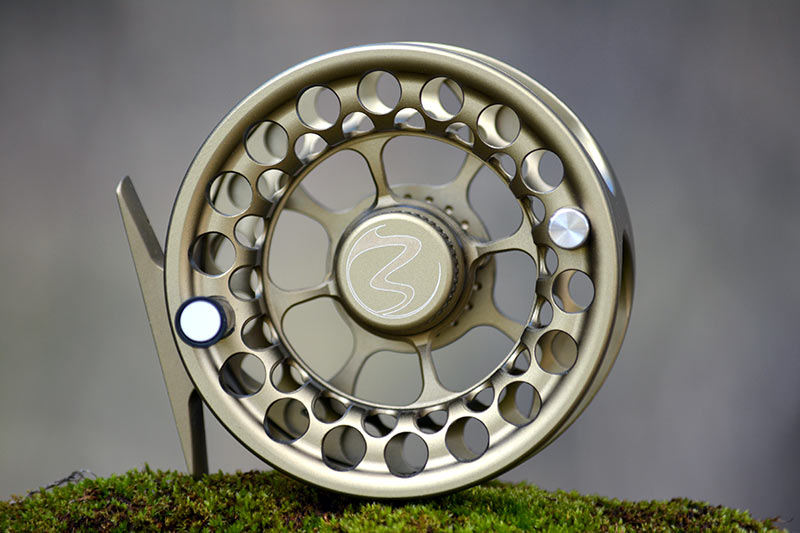
We discovered Einarsson reels via some of our European friends. Knowing how well the Einarsson Invictus and Plus reels did in our 8-weight reel shootout, we were excited to see how the 5 Plus stacked up against the competition. When we added up the scores we weren’t the least bit surprised at how well the 5 Plus placed. Had the 5 Plus been somewhat less expensive it could have easily made a podium finish.
Once you get this reel in your hand you know right away it is special. To begin with, the machining is absolutely striking. The elegant porting allows for a lot of air flow (which helps dry your backing) and gives the 5 Plus a very distinguished look. Everything about the reel implies top quality, from the smooth sealed drag to the easy to grab handle, to the added rigidity of the full frame, making the reel more durable should you take a fall with it.
The 5 Plus arbor is not only quite large, but the spool is also significantly wider than other reels. This helps with backing capacity but also makes it easy to reel up your line without micromanaging it (to make sure the line doesn’t all end up in the same spot, which could jam if not reeled on evenly).
Although the 5 Plus doesn’t have the strongest drag, it does utilize one of the smoothest drags out there. With plenty of stopping power for trout (not to mention the reel is easily palmed at the edge of the spool) the 2.5 pound max drag strength will not be an issue.
The only things I think could possibly be improved are a somewhat narrow range of drag adjustment and a spool removal cap that comes off and can get lost. There is actually a “drag stop” in the cap that prevents the drag from having a wider range – perhaps this could be re-worked. As we mentioned before, for most trout reels you are going to pick a relatively light drag and leave it there – so the narrower range of drag is perhaps not as detrimental as it might be for steelhead, salmon, or saltwater fish.
As for the spool release cap, you may have to get used to taking the cap off and immediately putting it in a safe pocket until you are ready to put it back on. As long as you always remove the spool in a safe place, (either on the shore or low to the bottom of the boat) you won’t lose the cap even if you drop it.
All of Einarsson’s reels are beautifully machined in Ísafjörður, Iceland from aircraft grade 6061 T6 aluminum. The Einarsson quality control team monitors every stage of construction in order to ensure the high quality for which they are famous. They are also environmentally conscious and support the North Atlantic Salmon Fund and donate 1% for the planet on each reel sold. Protecting the world’s fishing grounds is of the utmost importance to the founder, Steingrimur (Stenni) Einarsson and the rest of the Einarsson crew.
Plus reels come in four standard colors: black, champagne (bronze), clear, and red. In 2015 they added an 8 plus, for a total of 5 different sizes (3-9).
NOTES:
Retrieval Sound: A pleasant sound reeling in
Outgoing drag sound: Slightly muted going out
Spin: Not much (1 Rev?)
Counterbalance: Perfect
Spool Removal: Easy, but spool cap does come off (and can get lost)
Drag Knob: Easy to turn, good detents
Drag Detents: Not easily knocked off by accident
Range of Drag: OK but less than others
Max Drag: Sufficient – 2.5 pounds
Handle: A little thin, could swell towards the end for better grip
Feels light for its size
Excellent machining quality and feel
Full frame adds strength and durability
#6 Ross Evolution LT 2 $315 – reel, $189- x/spool
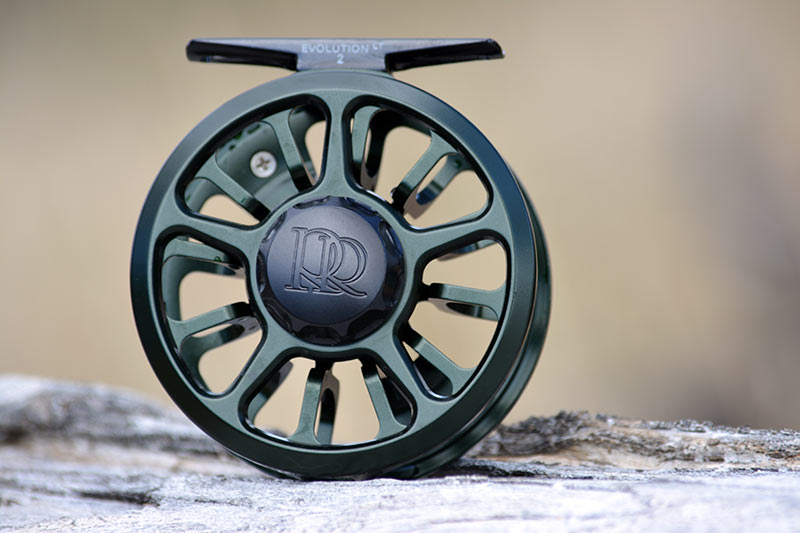
We’ve been a fan of the Ross Evolution LT ever since it was introduced in 2010. Since then we have sold hundreds of them either alone or in one of our favorite 4, 5 and 6 weight outfits. Over the years the Evolution has proven itself to be lightweight yet durable. The drag sounds great, and this is one of those reels that is a real pleasure to fish
Although the Evolution isn’t a true “spinner” type reel we love the fact that its low retrieval resistance allows you to spin the reel and pick up slack. The fact that it does this enables an angler to reel in quickly, despite the fact that the Evolution doesn’t have a significantly large arbor (like the new Sage Click or Loop Dryfly). Just to see if the Evolution could hang with the retrieval rates of these larger arbor reels we timed how quickly we could reel in a 100 foot line with a 12 foot leader. Here’s what we got:
Although the larger arbor reels should have reeled in faster, we found by slapping the face of the Evolution we could retrieve line even faster than reeling. With true “spinning” type reels like the Cheeky or 3-Tand, retrieval rates using this technique were even faster.
All that being said, the Evolution is probably due for an update. Things we would like to see include a larger arbor, more spin like the Cimarron and Animas, a larger handle with more swell towards the end, an easier to grip drag knob, a little more range of drag, and either better drag knob detents or more resistance to keep the drag from accidentally getting bumped off from the selected setting. There’s not much need to reduce the weight since the reel already feels light enough AND it’s durable. Now that Mayfly Outdoors owns both Ross and Abel. Can we expect to see tricked out new colors offered by Ross?
The Evolution reels are fully machined in Montrose Colorado, from the highest-grade aerospace aluminum available. The Evolution LT comes in three standard colors: black, mist gray, and green.
Like Bauer, Ross donates 10% of each reel sold to sport fish and wildlife restoration programs. They are also partnered with Trout Unlimited, the International Federation of Fly Fishers, the International Game Fish Association, and the Congressional Sportsmen’s Foundation. It’s nice to see a reel company that cares about our sport and gives back.
NOTES:
Retrieval Sound: Very pleasant “plastic purr” retrieval sound
Outgoing drag sound: Decent plastic purr going out
Spin: Good but not as much as a Cimarron or Animas (3-4 revs)?
Counterbalance: Perfect
Spool release: Great and easy to depress, can never lose
Drag knob: Slightly more difficult to turn than Cimarron
Drag Detents: Nice detents to keep drag in place
Max Drag: Strong enough but not overkill – 3.6 pounds
Range of drag: Good
Handle: Good size but no flare or swell
Feels nice and light
#7 Lamson Lightspeed Series IV size II $349.95 – reel, $150.95 x/spool
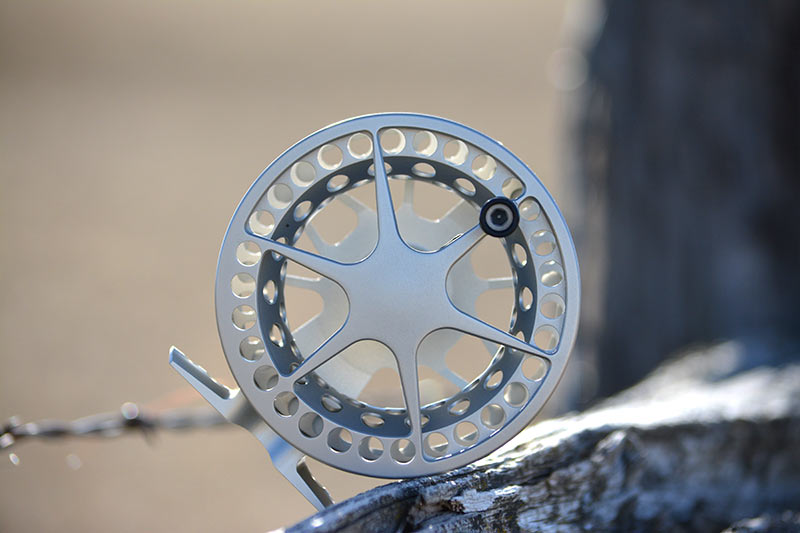
If you are looking for a lightweight reel, with a large arbor (and excellent retrieval rate), the Lamson Lightspeed Series IV size II is an excellent option. With updated ergonomics, more porting (and less mass) than previous Lightspeeds, the Series IV is a serious performance category contender. Although it did not score a perfect 20 in any specific performance category, the Lightspeed Series IV proved to be a very well rounded reel that is lightweight with a strong and smooth reliable drag.
Cosmetically the Lightspeed looks sharp – as it should, since it’s made by a design group.
The Lightspeed’s porting is elegant and everywhere – Even the reel foot is ported to make the reel lighter. The porting on the curved arbor will help your backing dry quickly. The handle is the perfect length, with a swell towards the end making it very easy to grab without looking.
A couple of things could possibly be improved with the Lightspeed. First and foremost is the durability. We know how easily these reels bend if dropped since we’ve owned a few ourselves and have also sent a few back for our customers. What ends up happening is the spool bends or “dents” and then hits the frame each time it goes around making a noise and getting “stuck” in the same spot. We can usually true the spool up, to eliminate the noise and bump, but this is difficult, and you won’t find many shops that can do it. If you are the type of person who is very careful and seldom falls or drops your reel, then the Lightspeed will work for you. But if you tend to fall into the clumsy category, or often fish rip rap banks or other risky spots where you are likely to fall, plan to spend more money to send your reel in for repair every now and then. The other thing that needs improvement is the problem of the drag setting getting knocked out of adjustment at low drag settings like 5X and 6X. Adding some drag detents or stiffening up the drag dial would help.
Machined in Boise, Idaho from high quality aluminum and stainless steel, Lamson also adds a “Hard Alox” finish to the Lightspeed, which has proven to reduce scratches. Lightspeed Series IV only come in silver, with a coral blue color sleeve around the drag system.
NOTES:
Retrieval Sound: Plasticky retrieval, sounds OK but not as nice as Ross Evolution
Outgoing drag sound: Slightly higher pitched (and louder) plastic but pleasant sound going out
Spin: Not much (1 -2 revs)?
Counterbalance: Good – (no weight just extra metal to balance it)
Spool Removal: Spool pushes out (good – can’t lose release cap since there isn’t one, although these can get tough to push out after several years of use).
Drag knob: Easy to turn
Drag Detents: Not as good as some
Max Drag: Very Strong – 9 pounds (much stronger than all other Lamsons)
Range of drag: Very Good
Handle: Much better than the Guru, longer with a nice flare
Awesome looks and super light feel
This reel feels and looks like it isn’t very durable – one hard spill and you’re done. We know these bend and dent, even from dropping them in the shop.
Cool – you can change shaft color
Is it just me or does this drag smell funky? “crank-stank”?
#8 Hatch 4+ MA $450 – reel, $190 x/spool
(the better size for 5 weights)
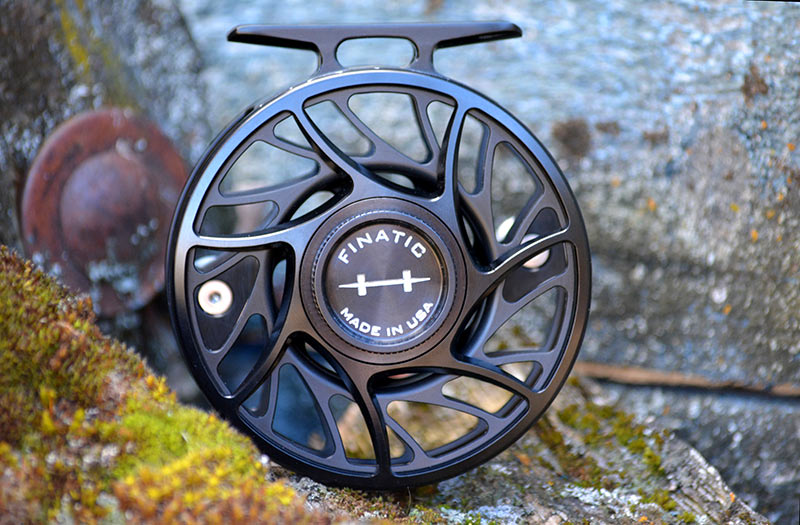
The Hatch Finatic series has been dominating the big screen of fly-fishing for years. Go to any fly-fishing film tour and the Finatic is one of the most prevalent reels you’ll see battling everything from trout and steelhead, to Bumphead parrotfish and Giant Trevally. The Film Tour has been an excellent marketing tool for Hatch, as many anglers who watch these amazing films conclude that they need to add a Hatch Finatic to their collection of fly reels. And when they do get a Hatch in their hands, their response is usually positive.
First off, we love how the handle is large and easy to grab without looking. Also, since it is metal it will never split or break like wood or plastic. We also love the look of this reel – the natural shell like cutouts make this reel stand out from other traditionally ported reels.
That being said, we feel a few things could be done to make the Finatic even better. Hatch doesn’t do any porting on their arbors (where the backing sits). A little extra porting would save weight and also allow the backing to dry more quickly, (like the Galvan Torque, the Bauer RX2, and the Lamson Lightspeed). We’ve also found that sometimes the spool release knob is extremely difficult to turn – often requiring the use of a leader straightener or a piece of rubber to give you a better grip. If you have to change your spool in the field and you don’t have something rubber like on you this can be a real challenge. An older 11 was so frozen that no one in our shop could remove the cap, so it was sent to Hatch for a fix. Retrieval resistance could be better, (especially for anglers who want to spin up their slack line quickly). A couple of times someone in the shop has dropped a spool and we’ve noticed the Fanatic spools bend more easily than others. We’re hoping that this is just a coincidence.
The main chink we’ve found in the Finatic’s armor is that water can get through the tiny allen key screw-hole, (the screw and hole designed so you can change the retrieve direction of the reel). If this happens, the stacked rulon and stainless steel disc plates won’t work properly and the reel will shudder when line is peeled off, especially at higher settings (3 pounds or more of drag pressure).
We have a couple of ideas for this. 1. try to avoid submerging your reel in water, especially saltwater. 2. Use some kind of 0-ring to stop water from getting through. 3. Use a sealant to keep water from getting through. 4. Make left hand or right hand specific hubs (like Nautilus) and eliminate the reel direction screw-hole altogether. Here at the shop we have been going with option 3: Permatex Medium Strength Threadlocker BLUE gel which seems to do a good job at sealing the hole while not locking it completely.
Hatch reels are made in San Diego, California from the highest-grade aluminum bar stock available. The spool and frames come in two standard colors, black or clear, and in two arbor sizes, large or mid arbor. Black reels come with a silver hub and silver writing however clear reels come with 4 color options at no extra cost: black, green, blue, or red.
One thing Hatch does have everyone beaten on is proprietary backing. If you need more backing capacity Hatch’s 68 pound premium PE braided backing is thinner than 20 pound Dacron. It won’t cut you like gel spun, but will get you the extra yards you are looking for…
NOTES:
Retrieval Sound: Louder sound reeling in but still somewhat muted
Outgoing drag sound: Outgoing sound is even more muted
Spin: Not much (1 rev)?
Counterbalance: Good
Spool Removal: Spool release sometimes extremely difficult to get off (need rubber cloth or leader straightener)
Drag knob: Easy enough to adjust
Drag Detents: not much for detents but the knob is stiff enough that it won’t get knocked off easily.
Max Drag: plenty strong! – 5.5 pounds
Range of drag: Good
Handle: Excellent large, easy to grab handle good size and shape but handle doesn’t feel as smooth as some (when it rotates).
Reel seat machined in – can’t lose or have it loosen up on you, however it could get dented if you drop it, which may require a frame replacement.
The 4+ reel feels significantly lighter than the 5+
“Sealed drag” works well, unless water gets in it.
#9 Lamson Speedster $299.95 – reel, $140.95 x/spool
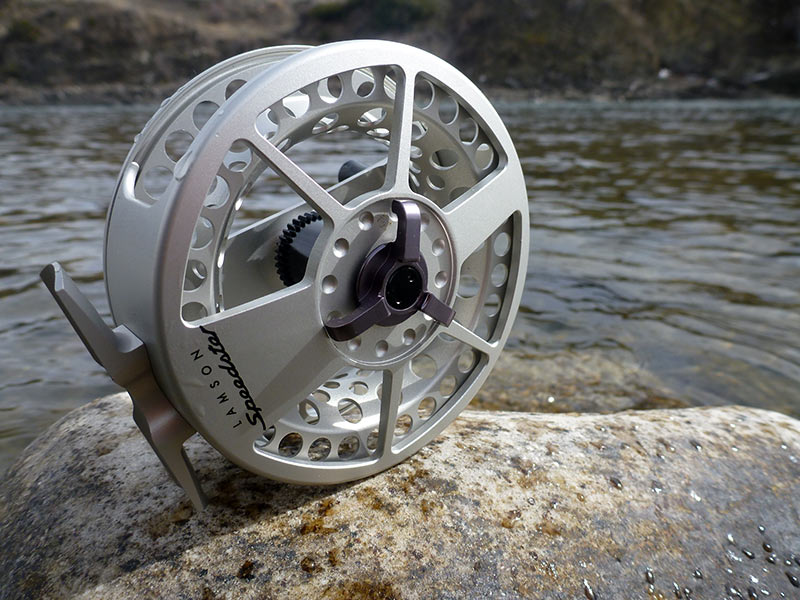
Although the Lamson Speedster scored lower than the Lightspeed overall, (mostly due to a superior drag), it far outperforms the Lightspeed in rate of line retrieval. Like the Lightspeed, the Speedster doesn’t spin very well, however it does have a huge arbor, which picks up line faster than its more expensive older brother.
Although Lamson may claim their reels all utilize the same drag, we found them to be different. While each model Lamson reel may have the same basic style of drag (a conical rather than disk-shaped drag) they differ, both in terms of range of drag and maximum drag. For example, the Lightspeed had a very wide range of drag, between .25 to 2 pounds (2 full turns), while the Speedster had a narrower range. Also, the Lightspeed’s drag is by far the strongest of all the Lamson trout reels at a maximum of 9.5 pounds while Speedster is the weakest, at 1.25 pounds maximum drag.
If Lamson put the Lightspeed’s drag into the framework of the Speedster they’d have the best of both worlds. While Lamson doesn’t offer an HD Speedster in a size 2 yet, we hope they will. While Lamson says the reason for the full-caged HD is to capture line without failure (especially thin diameter running lines), we feel the full frame version would help the Speedster’s strength and durability. With a full frame, the Speedster’s spool is much less likely to bend. The reason we scored the Speedster low in “fun to fish/got to have” is because it is so fragile and dents easily. With a full frame we could easily move this score up to an 18. Add the Lightspeed’s drag and we’d be looking at a 19/20 which would make it a fantastic all around reel.
Scoring exactly the same amount of points in 15 out of 18 categories, the Lamson Speedster and Lightspeed are very similar reels. If you want the better drag, go with the Lightspeed. If you want a fast rate of retrieval go with the Speedster. Keep in mind you can always “palm” the Speedster to create more drag pressure when needed.
Machined in Boise, Idaho from high quality aluminum and stainless steel, Lamson also adds a “Hard Alox” finish to the Speedster, which has proven to reduce scratches. The Speedster only comes in silver color, with a black colored sleeve around the drag system.
NOTES:
Retrieval Sound: Plasticky retrieval, sounds OK but not as nice as Ross reels
Outgoing drag sound: Slightly deeper plastic sound, louder going out
Spin: Not much (1 -2 revs)?
Counterbalance: Good – no counterbalance specific weight, just extra metal
Spool Removal: Spool pushes out (good can’t lose release cap since there isn’t one, although these can get tough to push out after several year’s use).
Drag knob: is easy to grab, but can get knocked off setting
Drag Detents: Not much, drag can get knocked off of setting if not careful
Max Drag: much weaker than Lightspeed, may have to palm – 1.25 pounds
Range of drag: Good
Handle: Much better than the Guru, long with a nice flare
Awesome looks and super light feel – HUGE arbor
Like the Litespeed, the Speedster doesn’t appear very durable – one bad drop or spill and you’re done. We know these bend and dent, even from dropping them in the shop
#10 Douglas Nexus 5/6 $325 – reel, $145 x/spool
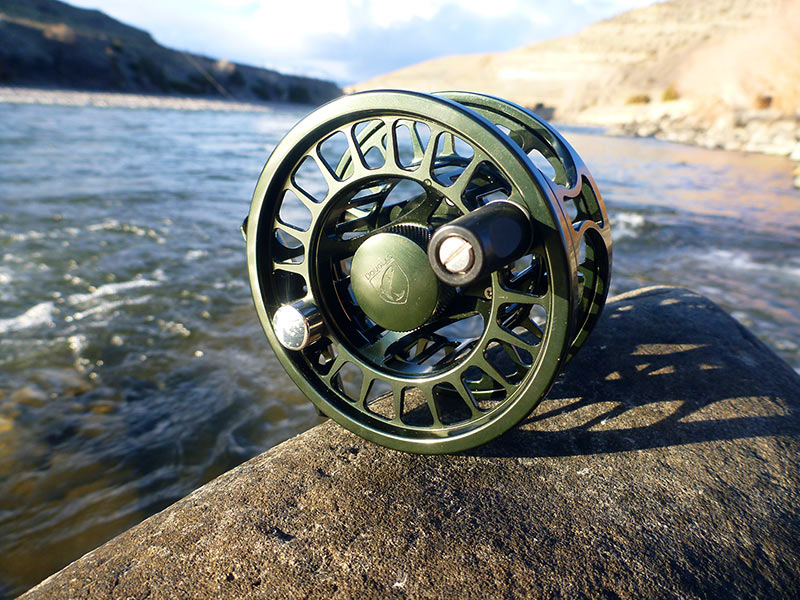
Overall we were impressed with the Douglas Nexus reels. With its full frame design it is both light and durable. It’s highly ported, both on the spool and on the arbor, helping it to dry faster. The sealed drag is maintenance free and very smooth. The handle is well designed, with a good size and a portion of it carved out for a more comfortable grip. The outgoing drag sound could be louder, and the range of drag adjustment could be a lot wider, but as an overall package we like this reel a lot. As a true “spinner” type reel, the Nexus’ lack of retrieval resistance allows the spool to spin smoothly and “coast” for a while with its quality ball-bearings. This enables you to pick up excess line rapidly, especially when you slap the face of the reel rather than using the handle.
The Douglas Nexus is machined in South Korea from 6061 aircraft aluminum and is proof that high quality reels can be made overseas. Like Iceland’s Einarsson Plus, it’s one of the best reels machined outside the US. The Douglas Nexus comes in two standard colors: silver and green.
NOTES:
Retrieval Sound: Silent Retrieve
Outgoing drag sound: plasticky and nothing like the Argus
Spin: Very Good (3-4 revs)?
Counterbalance: Good, solid and smooth feel
Spool Release: Cap easy to grab, can’t come off although not really fat finger friendly
Drag Knob: Good, but not easy to turn as some, (thin knob)
Drag Detents: Not easily knocked off by accident – good detents
Range of Drag: Not very good
Max Drag: Very Strong – 4.75 pounds
Handle: Better than Argus but still no flare or swell
Full frame adds rigidity and durability
Reel could be bigger, and for a spinner style reel it could spin more
#11 (tie) 3-Tand TF50 $199.00 – reel, $119.95 x/spool
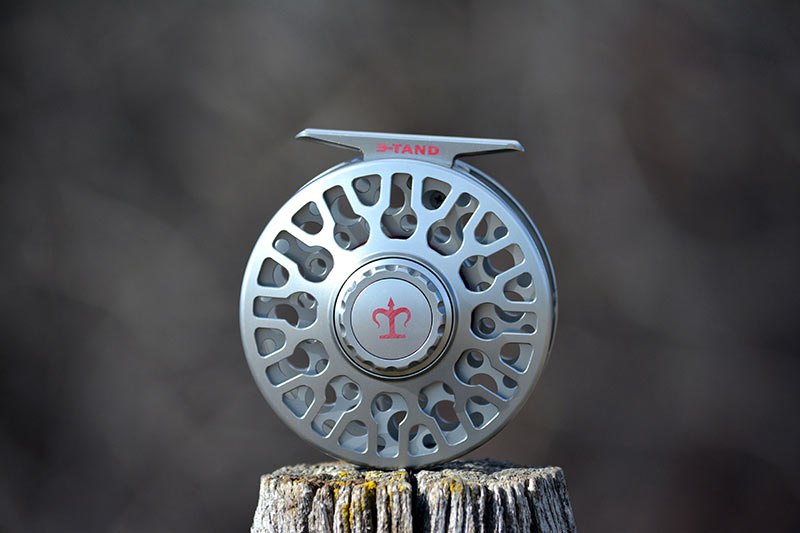
We first heard about 3-Tand reels from one of our saltwater friends, Captain Bill Blanton. He reported that the 3-Tand reels appeared to perform exceptionally well for the price and that they might be worth considering. About a year later our Hardy Reps picked up the line and told us how popular these reels were on the Bighorn. While our first impressions of these reels were very good, we didn’t have the time to explore them further, and no one came into the shop asking if we had one of those “Three Tand” reels. It wasn’t until we saw how well the 3-Tand TF50 did in the shootout that we decided to start stocking them.
Originally one of our samples reels had an issue with some of the bearings falling out. We were worried about this at first, but as it turns out it was a fluke accident (1/5000) an easily fixed. We’ve been testing the reels since and a lot of our guides have been using the TF50 with no problems what-so-ever. Everyone comments on how nicely these reels spin and how much line they can pick up quickly. We like this reel so much that it is now part of our “Best Buy” packages, including the 4-weight, 5-weight, 6-weight outfits, 7-weight, and 8-weight outfits. The reel looks and feels fantastic!
3-Tand reels are machined in China from high grade aircraft aluminim. There are two standard colors, Clear and Black. Extra TF50 spools retail for $119.95.
NOTES:
Retrieval Sound: Silent Retrieve
Outgoing drag sound: Muted outgoing sound
Spin: Excellent (6-7 Revs?)
Counterbalance: Slight wobble
Spool Release: Easy, but spool cap can come off (and can get lost)
Drag Knob: Not as easy to turn as some (thinner knob)
Drag Detents: Good – not easily knocked off by accident
Max Drag: Strong! – 5 pounds
Range of Drag: Not as good as some
Handle: A little thin, could swell towards the end
Feels light for its size
Reel seat has rivets instead of screws (shouldn’t loosen)?
Excellent machining, sweet unique cut outs and look – doesn’t appear to be made overseas, although it is
#11 (tie) Tibor Signature 5/6 $685 – reel, $350 x/spool
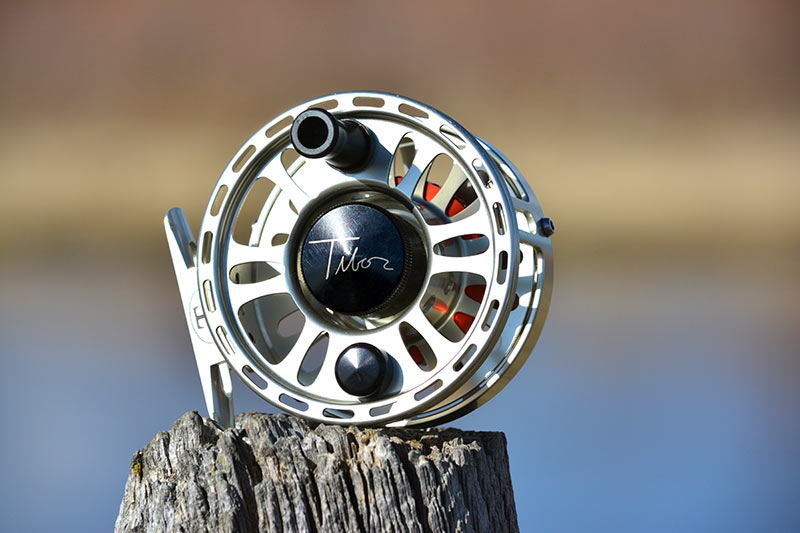
Tibor has always been one of our favorite fly reels. Pick one up and it exudes quality and wonderful craftsmanship. The performance is always top notch too.
The main issue with the Signature 5/6 is that it is too big and heavy to balance most 5 and even 6-weight rods. Fully loaded the reel weighs in at a brutal 9.5 ounces – the heaviest in our shootout. Aside from being heavy, it is wide and bulky and doesn’t look like it belongs on your 5-weight.
Even though Tibor calls this a 5/6 weight reel, we have found that it is much more of a 6/7 weight reel. George has even used one with an 8-weight line!
It will, however, fit 245 yards of 20 pound backing and is probably the best reel here with which to land a tarpon. Its bulk also translates to insanely tough. Of all the reels the Tibor Signature gets our “Diesel Truck” toughness award. I think you could drop this reel 100 times and never see the frame budge.
The Tibor Signature 5/6 also tied the Galvan for the most range of drag adjustment in our shootout. At 2.25 revolutions between .25 and 2 pounds, you have a lot of room to fine tune your drag to the exact setting you like. If you look at the range from .25 all the way up to 9 pounds, you can fine tune this reel for 7X all the way up to a smooth drag of 4 pounds or more. If an angler was out to get one reel to do it all – trout fishing, steelheading, and saltwater, this could be it – especially if they weren’t concerned about the extra weight when trout fishing. It will certainly last a lifetime…
We love the handle on the Signature 5/6, an easy 20 due to the ample size, swell, and ease of finding it without looking. Porting on the arbor helps to dry your backing and the special porting on the foot does what it can to lighten the reel.
On the first versions of the Tibor Signature, sand and grit could work their way into the back side of the reel and jam the sealed drag. (This happened to us numerous times at Jurassic Lake where 60 mph winds were constantly blowing sand into our reels). Tibor remedied this however, and now they have added a stopper which blocks any sand, grit, or river debris from entering the back side of the drag.
The Tibor Signature is a true quick change and the spool is easily removed. With its sealed drag it is also maintenance free, which is a big plus. Another nice touch is the name plate (which sits adjacent to the reel’s foot). Simply send the plate to Tibor with whatever you want them to etch on it, (your name, a nick name, a phone number, etc.) and they will send it back to you duly customized free of charge in about a week’s time.
The Tibor Signature 5/6 is machined in Delray Beach, Florida. The Signature Series comes in three standard colors: Jet Black, Satin Gold or Royal Blue. For an extra 10% ($68.50) you can choose one of the three custom colors: Crimson, Moss Green, or Graphite Gray. There is no additional cost for their many hub colors which include: Sunset Orange, Royal Blue, Neon Pink, Aqua, Jet Black, Lime, Crimson, Graphite, and Violet 3D.
You can also add a further personal touch to your Tibor Signature by choosing one of Tibor’s exclusive engraved game fish designs or your own personal logo at an extra cost. Nothing quite says “Will you marry me?” like a Tibor Signature!
NOTES:
Retrieval Sound: Nice retrieval sound compared to other 5-weight reels, but nothing like the Everglades, Rip Tide, Gulfstream, or Tibor Spey.
Outgoing drag sound: More muted, quieter sound going out. (OK but not great).
Spin: Not much (1 – 1.5 revs)?
Counterbalance: Excellent
Spool Release: Nice grooves for removal but not exactly “Fat finger” friendly
Drag knob: nice groves for turning but on the slim side
Drag detents: Superb – (drag adjustment won’t get knocked off easily)
Max Drag: Very strong!!! – 9 pounds
Range of Drag: TIES FOR THE BEST! (along with the Galvan Torque)
Handle: Excellent, huge and easy to grab with a nice swell
Huge sealed drag is super overkill for a trout reel (and heavy)
Excellent machining and heirloom quality
Beefy and durable – The Diesel Truck of all the 5/6 reels
A lighter reel with slightly less drag would be better for a 5 weight
#12 (tie) Ross Cimarron II 4/5 $195 – reel, $117 x/spool
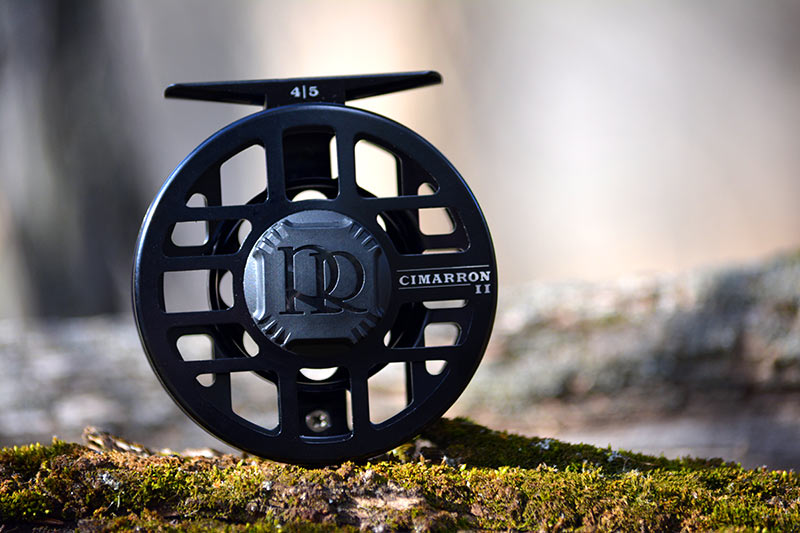
Here’s another heavy hitter reel that comes in under $200. There are some minor differences, but basically you’ll get the same exact performance from a Ross Cimarron II as a Ross Animas 4/5 for $40 less. For all practical purposes they are the same size and weight, they both have good handles to grab, they both spin exceptionally well, they sound identical, and the drag knobs are both easily adjusted and the range of drag is nearly identical. In fact, the main reason to get the Animas over the Cimarron is if you like the way it looks, (plus the Animas is ported where the backing sits), otherwise you might as well put the $40 towards some new flies, your next fishing trip, or a fly line.
The Cimarron II is a true “spinner” type reel that can pick up a ton of excess line quickly. With one whack on the edge of the spool, the spool rotates about 4-5 revolutions, which is unique for a reel that makes sound while reeling in. Most spinner style reels are silent when reeling in, so if you like more sound and slap reeling in your slack this will be a great reel for you.
The Cimarron II reels are proudly machined in Montrose, Colorado from the highest-grade aerospace aluminum available (6061 – T6). You can purchase the Cimarron II in any color, so long as it’s black. Size 4/5 extra spools retail for $117.
Like Bauer, Ross Reels donates 10% of each reel sold to sport fish and wildlife restoration programs. They are also partnered with Trout Unlimited, the International Federation of Fly Fishers, the International Game Fish Association, and the Congressional Sportsmen’s Foundation. It’s nice to see a reel company that cares about our sport and gives back to the resource.
NOTES:
Retrieval Sound: Pleasant “plastic purr” retrieval sound
Outgoing drag sound: Louder outgoing plastic purr
Spin: Great spin (4-5 revs)? (And with sound vs silent)
Counterbalance: Very good, however a tiny bit of wobble (looking at the center of the reel on the fastest spins)
Spool release: Great and easy to depress, can never lose
Drag knob: Square and easy to turn (better than Animas)
Drag Detents: No detents however drag knob is stiff (drag adjustment won’t get knocked off easily)
Max Drag: Wicked strong! – 9 pounds
Range of drag: Good
Handle: Excellent, perfect size and flare, easy to grab without looking
#12 (tie) Ross Cimarron II 5/6 $200 – reel, $120- x/spool
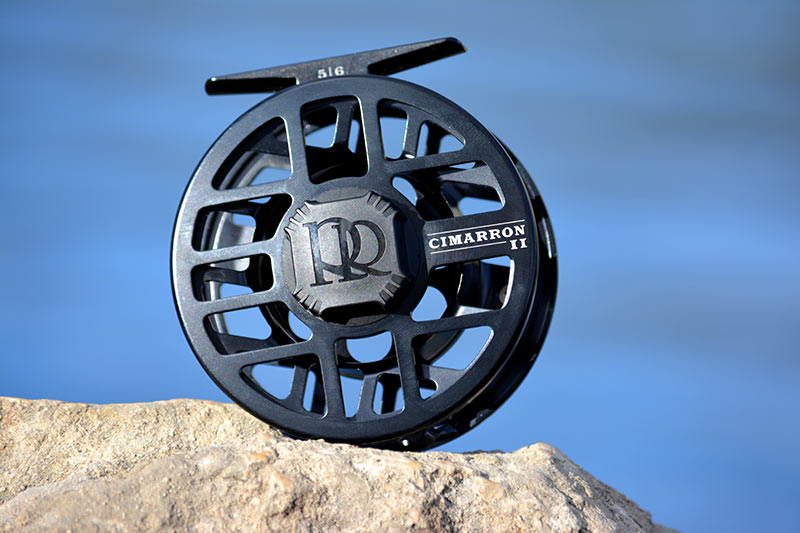
The Cimarron II 5/6 is exactly like the 4/5, just a little larger and stronger. The 5/6’s overall diameter and arbor size are larger than the 4/5’s – giving you 150 yards of 20 pound backing instead of 85 yards). We don’t think the extra 65 yards is going to make a huge difference, nor will the 5/6’s extra 2 pounds of max drag. We recommend getting the 4/5 for a 5-weight and a 5/6 for a 6-weight.
Just like the 4/5, the Cimarron II 5/6 is a lot of reel for the money. The Cimarron II is a true “spinner” type reel that can pick up a ton of excess line quickly. With one whack on the edge of the spool, the spool revolves about 4-5 rotations, which is unique for a reel that makes sound while reeling in. Most spinner style reels are silent when reeling in, so if you like more sound and slap reeling in your slack, this will be a great reel for you.
The Ross Cimarron II 5/6 is the same basic reel as the Ross Animas 5/6. There are some minor differences, but basically you’ll get the exact performance out of a Cimarron II 5/6 as an Animas 5/6, but for $50 less. For all practical purposes they are the same size and weight, they both have good handles to grab, they both spin exceptionally well, they sound identical, and the drag knobs are both easily adjusted and the range of drag is nearly identical. In fact, the main reason to get the Animas over the Cimarron is if you like the way it looks, (that and the Animas arbor, is ported where the backing sits which helps the backing dry). Otherwise you might as well put the extra $50 towards some new flies, your next fishing trip, or a fly line.
The Cimarron II reels are machined in Montrose, Colorado from the highest-grade aerospace aluminum available (6061 – T6). The Cimarron II comes only in black. Size 5/6 extra spools retail for $120.
Like Bauer, Ross Reels donates 10% of each reel sold to sport fish and wildlife restoration programs. They are also partnered with Trout Unlimited, the International Federation of Fly Fishers, the International Game Fish Association, and the Congressional Sportsmen’s Foundation. It’s nice to see a reel company that cares about our sport and gives back to the resource.
NOTES:
Retrieval Sound: Pleasant “plastic purr” retrieval sound
Outgoing drag sound: Louder outgoing plastic purr
Spin: Great spin (4-5 revs)? (And with sound vs silent)
Counterbalance: a little bit of wobble (looking at the center of the reel)
Spool release: Great and easy to depress, can never lose
Drag Knob: Square drag knob is easy to turn (better than Animas)
Drag Detents: Not detents per se, but drag knob is stiff enough that the drag adjustment won’t get knocked off easily.
Max Drag: Wicked strong! – 11 pounds!
Range of drag: Good
Handle: Excellent, perfect size and flare, easy to grab without looking
#13 Loop Evotec G4 FW 3/5 $425 – reel, $199 x/spool
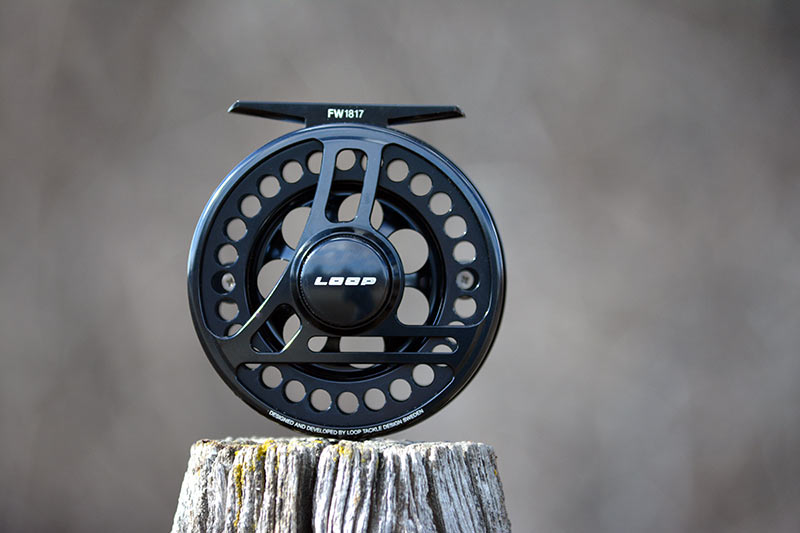
Loop has been making excellent reels for decades. They were manufactured in Sweden but due to the increase in high quality, lower cost machining in South Korea they have moved production overseas. We don’t blame them for it, we only wish the price reflected it. But the bottom line is that reel is machined just as well as it ever was.
While the Loop didn’t score a perfect score on smoothness of drag, (a close 19), the Loop G4 FW 3/5, Loop Opti Dryfly and Loop Evotec LW768 have three of the smoothest retrievals of the reels we tested. They are perfectly balanced and buttery smooth, bringing a high quality feel that is synonymous with luxury cars, fine wine, and expensive shotguns. Nearly everyone we show these reels to at the reel display case is impressed with the evident quality of these reels.
The Loop G4 FW 3/5 is a bit on the heavy side but not bad. The maximum drag is also on the lighter side, so be prepared to palm this reel for added drag pressure. The handle is terrific, with a wide rubberized O-ring for added grip when wet. Although the handle doesn’t have any swell or flare it is long and easy to grab without looking. The spool removal cap can get lost, so be sure you are mindful of this when removing the spool in the field. I guess Loop thinks we can’t figure out which way to turn the cap in order to get the spool off so they have given us a tacky “change spool” inscription on the cap, (the cap looks much better plain as on the Opti reels).
If there is any downside to the Loop Evotec FW1817 (3/5) it’s that it doesn’t have a very wide range of drag adjustment. Also, for some reason the arbor is ported on the sides, but not all the way across, which would have been better for allowing backing to dry quickly like the Opti Dryfly or Evotec LW768.
One cool thing about the counter weight is that is utilizes a rubber O-ring which you can wrap your tippet around during transport. We also love the look of the “L” shape machined into the frame, which has become Loop’s signature look.
Loop reels are machined in South Korea from the finest aircraft aluminum available. Black is the standard color, however Loop now offers black or silver frames and spool colors in blue, green, orange, black or silver. Extra FW 3/5 spools retail for $199.
NOTES:
Retrieval Sound: Silent sound reeling in
Outgoing drag sound: Silent sound going out (poacher’s special)
Spin: Very Good (3-4 revs)?
Counterbalance: Very good
Spool Release: Cap easy to grab, good grooves however cap can come off and get lost
Drag knob: not as easy to turn as some due to thin knob
Drag Detents: Good
Range of Drag: Not great
Max Drag: Palming required – 1.4 pounds
Handle: Very good, with built in rubber for better grip
Full frame adds extra rigidity, no apparent line gap
Feels light for size
Might as well port whole spool instead of part of it
#14 Orvis Access Mid -Arbor II $159 – reel, $85 x/spool
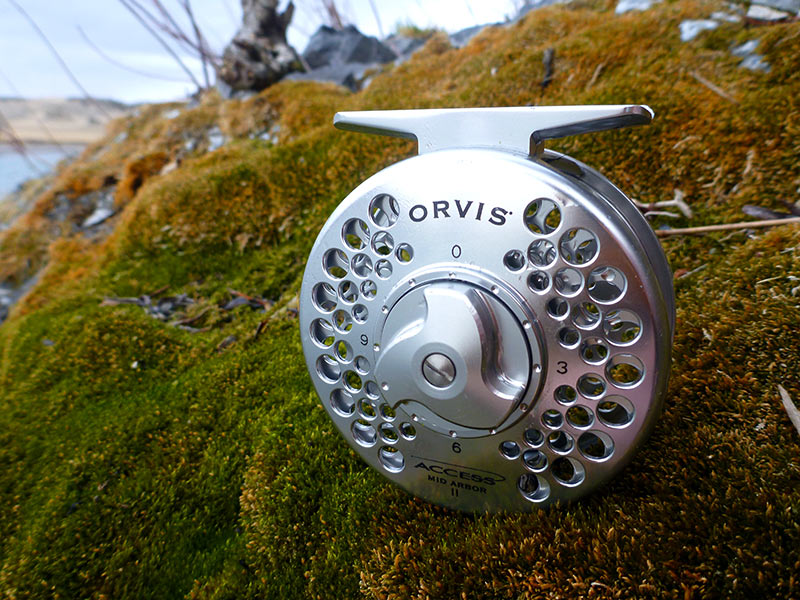
We have always liked Orvis reels, but we were surprised that the older Access Mid-Arbor was able to outscore the brand new Orvis Hydros II SL. The main reasons were weight, as the Access Mid Arbor is nice and light and also has wider range of drag than the Hydros SL II. The Access Mid Arbor has better sound (louder and more pleasant) than the new Hydros.
For anglers looking for the most rapid retrieval in the game, the Access Mid-Arbor isn’t the best choice. Although Orvis calls this a “mid” arbor reel, compared to many of the click style reels it is relatively small in diameter. The Access doesn’t spin much and the arbor isn’t ported so your backing won’t dry nearly as quickly as with the Hydros. Still the Access Mid Arbor looks sharp and at $159 the price is right. The handle shape is excellent and spool removal is easy enough, (though seemingly designed to be removed left handed). With its sealed drag the Access Mid-Arbor is virtually maintenance free, though oiling the spindle from time to time will help.
All in all, the Orvis Access Mid-Arbor is a great reel that performs well while maintaining a more traditional look and size. For the money, it is certainly one of the best, and is a great match for any of the best inexpensive 5-weight rods.
The Orvis Access Mid-Arbor is machined from top quality aircraft aluminum (6061 bar stock) in China. Standard colors are black, gold, or titanium.
NOTES:
Retrieval Sound: Plastic click sound in or out
Outgoing drag sound: Plastic sound in or out
Spin: Not much (1.5 -2rev)?
Counterbalance: Good
Spool Release: Easy to come off however,spool release button is somewhat sticky to pull off, and seems backwards from Hardy or other reels that we are used to.
Drag knob: Easy to adjust
Drag Detents: Good detents to keep it from getting knocked off
Max Drag: Plenty Strong – 5 pounds
Range of drag: Good
Handle: Nice size and appropriate swell
Small reel – not much for quick retrieval
#15 Cheeky Boost $219 – reel, $94 x/spool
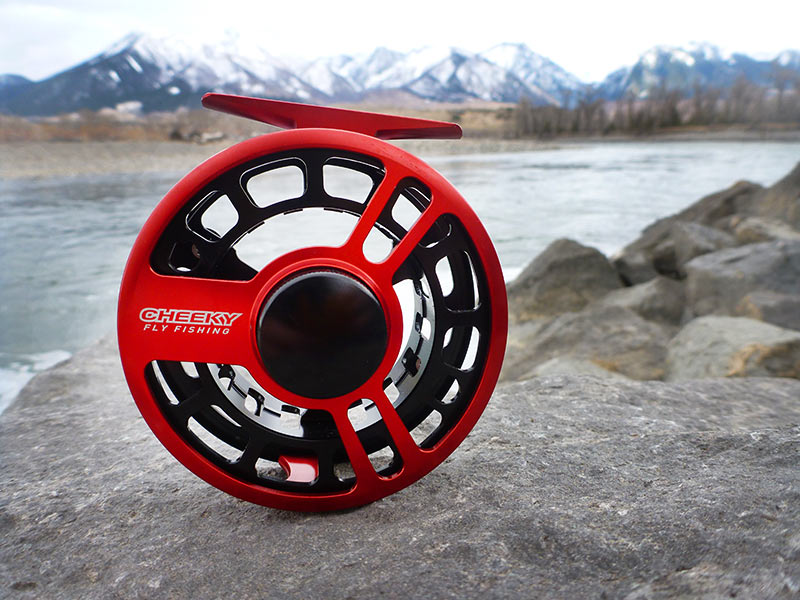
Here’s another reel I thought might make it to the podium. Of all the reels I tested it was fastest at reeling up slack line – not because it had the largest arbor, but due to its unique ability to spin exceptionally well. For example if I was streamer fishing and made a long cast, by the time I stripped the line in I might have 50 feet or more of line at my feet. If the fish happens to follow the fly all the way to the shore and eats it close to the bank the Cheeky Boost would be my number one pick to spin up the 50 feet of line as quickly as possible. I could simply slap the rim of the spool and it would “reel” quicker than any other reel… no doubt a tribute to its amazingly smooth bearings. You can try this on your own – one flick of the handle and the Cheeky Boost’s spool will be sent into countless rotations.
The Cheeky’s range of drag adjustment held it back from the top, as it did in our “fun to fish/got to have” category. Really I think it is one of the most fun reels to fish with, and while it might be made overseas and doesn’t have a name like Hatch, Tibor, or Abel it really deserves a better score here.
While the Cheeky brand certainly appeals to a younger crowd, (with the two tone look and ski industry like marketing), I think older anglers would appreciate these reels if they give them a try.
The Cheeky Boost is machined in China from high-grade aircraft aluminum. The 350 size, (for 5/6 weights) only comes in one color combination: Black and Red. Extra spools retail for $94.
Cheeky is another generous company that gives 10% of each reel purchase to support wildlife & sport fish restoration programs. They are also partnered with Trout Unlimited, Casting for Recovery, and Stripers Forever. We applaud their efforts to give back!
NOTES:
Retrieval Sound: Silent retrieve
Outgoing drag sound: Plastic sound going out
Spin: (Fast) Great bearings – best in test? (10 revolutions)!?
Counterbalance: Ever so slight “wobble” although not an issue
Spool Release: Release cap stays on (rubber o-ring keeps it from coming off)
Drag Knob: Good but not quite as easy as others
Drag Detents: No major detents but drag knob is stiff enough to keep from getting knocked off easily
Max Drag: Sufficiently strong drag – 4 pounds
Range of drag: Weak range of drag held it back
Handle: Good but could be a little bigger
#16 Hatch 5+ $500 – reel, $205 x/spool
(Same as the Hatch 4+ but better for 6-weights)
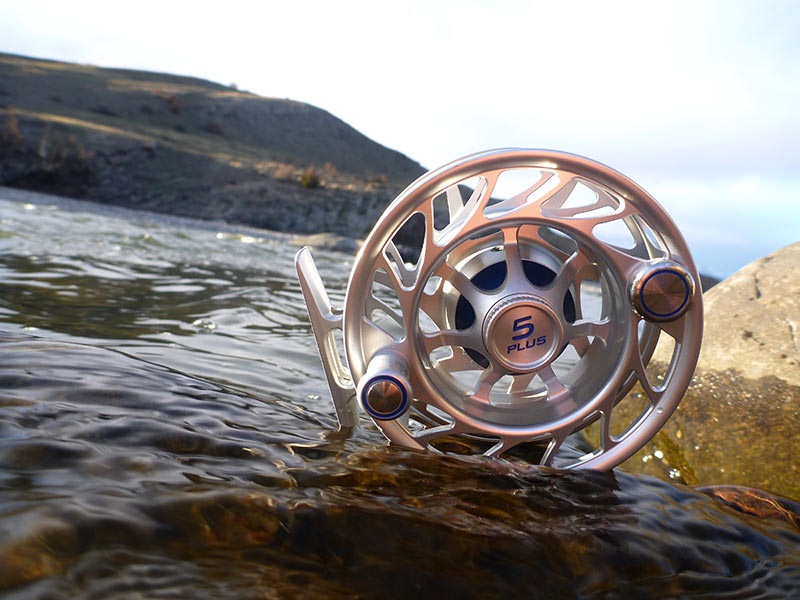
We all thought the Hatch 4+ Mid Arbor was a better size for 5 weight lines. It has ample backing capacity, and weighs a lot less than the 5+. Fully loaded the 4+ weighs 6.8 ounces, which is on the heavy side for sure, but still much lighter than the 5+ at 8.1 ounces. We feel the reels that best balance today’s lightweight 5-weight rods weigh between 5-6 ounces fully loaded, so the Hatch 5+ lost some points here.
Still, the 5+ has some good things going for it. First and foremost is how cool it looks. The machining style is unique and is one of the most attractive reels we have seen. Even the text Hatch uses looks sharp. The 5+ is better for 6 and even 7-weight lines. We like the design of the reel foot incorporated into the reel frame, since we’ve had other reel feet come off the reel due to loose screws over time. Sure, you’ll have to be careful not to drop the reel (since denting the foot may require replacing the entire frame) but once the reel is on your rod you are good to go. The metal handle is large and easy to grab with a pleasing shape, and is more fall-proof compared to wood handles that can crack and split if you fall directly on them.
I wish Hatch would port the arbor where the backing sits, as this would lighten the reel a touch and help dry your backing faster. I also wish the spool release cap was consistently easy to get off; sometimes it can be really tough to unscrew, especially if you’ve been fishing it hard and have any dirt or grit in it. Plan on buying a leader straightener for such occasions, as the rubber side will give you much better grip to unscrew the cap.
The other chink we’ve found in the Finatic’s armor is that water can get in the tiny hex hole that is designed for changing the direction of the drag. From our experience once water gets through it will make the drag shudder and the reel will become much less smooth. Even once the reel has completely dried we have found that the shudder remains. One thing we’ve found here at the shop that helps seal this hole is Permatex Medium Strength Threadlocker BLUE gel. This seems to help seal the hole and keeps the reel watertight.
Last but not least is the weight – the 5+ feels very heavy in hand naked much less when it is fully loaded with backing and line. If Hatch could get weight down by an ounce or two it would really help. Unfortunately I’m not sure how they could eliminate much weight unless they devise a significantly lighter drag system.
Hatch reels are made in San Diego, California from the highest-grade aluminum bar stock available. The spool and frames come in two standard colors, black or clear and in two arbor sizes, large or mid arbor. Black reels come with a silver hub and silver writing however clear reels come with 4 color options at no extra cost: black, green, blue, or red.
One thing Hatch does have everyone beaten on is their proprietary backing. If you need more backing capacity Hatch’s 68 pound premium PE braided backing is thinner the 20 pound Dacron! It won’t cut you like gel spun can, but will get you the extra yards you are looking for…
NOTES:
Retrieval Sound: Louder sound reeling in but still somewhat muted
Outgoing drag sound: Outgoing sound is even more muted
Spin: Almost none (1 rev)?
Counterbalance: Good
Spool Release: Spool release sometimes extremely difficult to get off (need rubber cloth or leader straightener)
Drag knob: Easy enough to adjust
Drag Detents: Not much for detents but drag knob is stiff enough it won’t get knocked off easily.
Max Drag: plenty strong – 5.5 pounds
Range of drag: Good
Reel seat machined in – can’t lose or loosen up on you, however dropping it may bend the reel seat, requiring more money to replace a frame
Handle: Excellent large, easy to grab handle good size and shape but handle doesn’t feel as smooth as some rotating
“Sealed drag” works well, unless water gets in it
Reel feels heavier in hand than others (but feels more durable should you take a spill)
#17 (tie) Loop Opti Dryfly $585 – reel, $265 x/spool
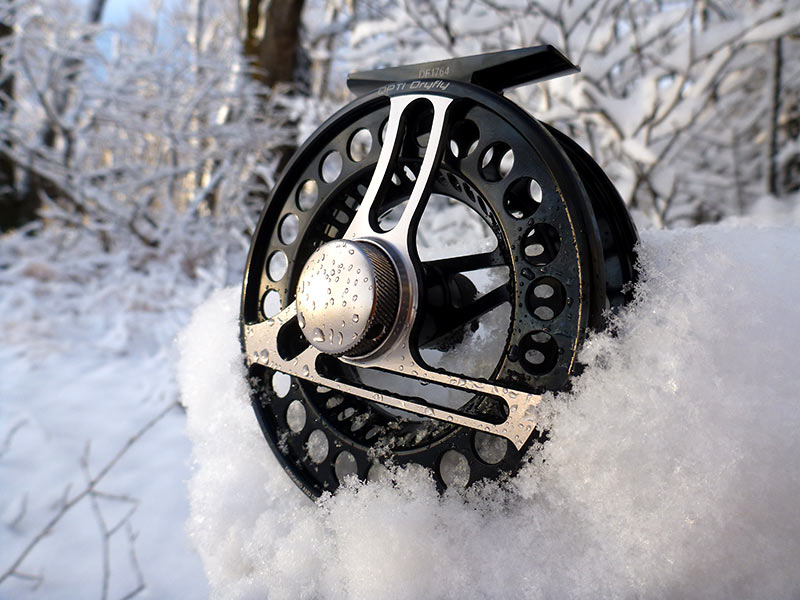
The Loop Opti series is perhaps Loop’s fanciest reel and also their top performer when it comes to rapid line retrieval. The Dryfly stands tall, and with its extra large arbor it reels in line significantly faster than its Evotec brethren. The Dryfly feels exceptionally smooth reeling in and its bright chrome “L” set against the jet black spool gives the Opti the Rolls Royce of reels look. It takes a while to get used how large this reel looks on a 5-weight rod, but it grows on you. The handle’s rubber overlay gives you excellent grip even when wet and we like the tippet storage O-ring featured on the counterbalance.
The spool release cap comes completely off, so be careful where you remove your spool. With larger fish you’ll likely want to palm the spool since the drag only goes to 1.3 pounds. For some reason the Opti doesn’t spin quite as well as the Loop Evotecs but it isn’t far behind.
Loop reels are machined in South Korea from the finest aircraft aluminum available. Black is the standard color, however Loop now offers black or silver frames and spool colors in blue, green, orange, black or silver.
NOTES:
Retrieval Sound: Silent sound reeling in
Outgoing drag sound: Silent sound going out – however you can still hear the metal hum a bit on higher drag settings
Spin: Good (3revs)?
Counterbalance: Excellent
Spool Release: Easy to get off but spool cap comes off and can get lost
Drag knob: Easy to adjust
Drag Detents: Pretty good, it would take a hard whack to knock the drag setting off by accident
Range of Drag: Weak
Max Drag: Weak – palming will be required for larger fish
Handle: Nice rubber grip but no swell or flare towards the end
Smooth feel and Rolls Royce quality build
Very large arbor – good for quick retrieval
Could spin more for a spinner?
#17 (tie) Sage 4250 $299.00 – reel, $150 x/spool
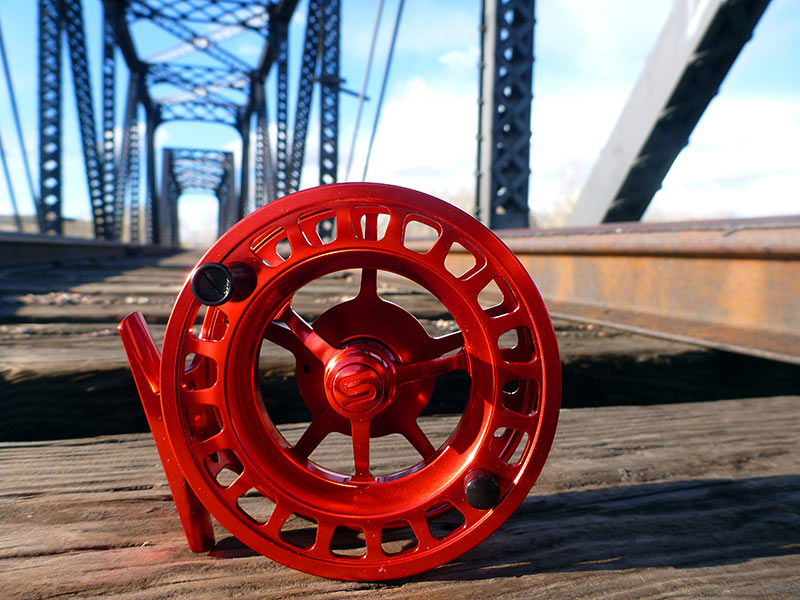
The Sage 4250 is a solid reel for the money. It has a very large arbor and the reel spins reasonably well, making it capable of rapid line retrieval. The reel feels light to boot, (5.8 ounces loaded) and the Ember (red) color we ordered really pops.
The Sage 4250 could use a little wider range of drag adjustment. Also at a max drag of 1.8 pounds you may want to palm larger fish on this reel. It would be nice to see a ported arbor to help backing dry better. The handle isn’t nearly large enough, nor does it have much swell towards the end.
The Sage 4250 is made of 6160 – T6 top grade aircraft aluminum in South Korea. It has been cold forged and tempered for superior strength, and has a concave arbor for added rigidity. The Sage 4200 series comes in 4 standard colors: Stealth (black), Ember (red), Platinum, and Bronze.
NOTES:
Retrieval Sound: Decent click sound reeling in
Outgoing drag sound: Louder click sound going out
Spin: Pretty Good (2 – 2.5 rev)?
Counterbalance: Good
Spool release: like Lamson or Aspen the spool pushes out, (can’t lose knob since there is no knob)
Drag knob: Easy to adjust,
Drag detents: Pretty solid but not as good as many
Range of Drag: Very Small
Max Drag: Pretty Light – have to palm bigger fish – 1.8 pounds
Handle: Nice swell and thickness, could be a bit longer
Feels a little heavy in hand but durable
Nice large arbor – reels in fast
Can push the spool into the frame easily – doesn’t seem like it would take a hard spill very well
#17 (tie) Tibor Light Tailwater CL $380 – reel, $185 x/spool
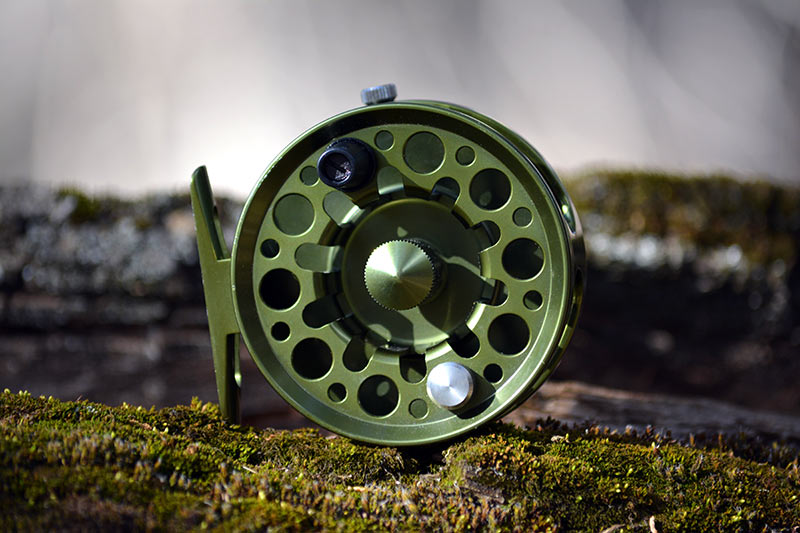
Here is a reel that I thought might have made a podium finish. It looks and sounds like a million bucks, (easily one of our favorites for a great retrieval “purr…”). We were tempted to give it a perfect 10 for such a sweet sound reeling in, but unfortunately the Tibor Light didn’t have much sound at all for the out going drag. Having ample sound on the out going drag is important because it allows you to hear the “feedback” from the reel. Still, the craftsmanship on this reel is absolutely amazing. Spool to frame tolerance is perfect. Like Abel, Tibor makes a reel that is very durable and definitely heirloom quality.
Maximum drag on the Tibor Tailwater was only .75 pounds, so you’ll definitely need to palm this reel when playing larger fish. The range of drag adjustment wasn’t very good either; it seemed there wasn’t much difference between no drag and full drag. While the handle is an excellent size it could use a bit of swell at the end instead of tapering as it does.
Another thing JG noticed fishing his Tibor in the middle of winter is that when the temperature is below freezing the cork drag can develop a thin layer of ice, causing the reel to free spool with no drag pressure (even though the drag dial should be engaging the drag). For anglers who fish a lot in the winter this might be something to consider, for everyone else it will be a non-issue.
The Tibor Light Tailwater CL is machined in Delray Beach, Florida from the best aircraft aluminum available. The Tibor Light Series comes in two standard colors: Jet Black and Satin Gold. There are four custom colors at additional cost – Crimson, Moss Green, Graphite Gray and Royal Blue.
You can also add a personal touch to your Tibor Signature by adding one of Tibor’s exclusive engraved game fish designs or your own personal logo.
NOTES:
Retrieval Sound: Excellent “purr” sound retrieve
Outgoing drag sound: Pleasing but more muted sound going out
Spin: Not a ton, (1.5- revs?)
Counterbalance: Perfect balance, excellent machining
Spool Release: Release cap stays on, machined grooves give it good grip, easy to turn
Drag Knob: Easy to adjust
Drag Detents: None – you can definitely knock off setting by accident
Range of Drag: Weak to medium drag – going to have to palm this one with larger fish
Max Drag: Too weak, you’ll have to palm this reel – .75 pounds
Handle: is nice size but could swell out more
Classy look and feel
Top notch sound, craftsmanship, quality machining
When fishing below 32 degrees, water turns to ice on the cork and allows the reel to free spool.
#18 Lamson Guru Series II size 2 $209.95 – reel, $95.95 x/spool
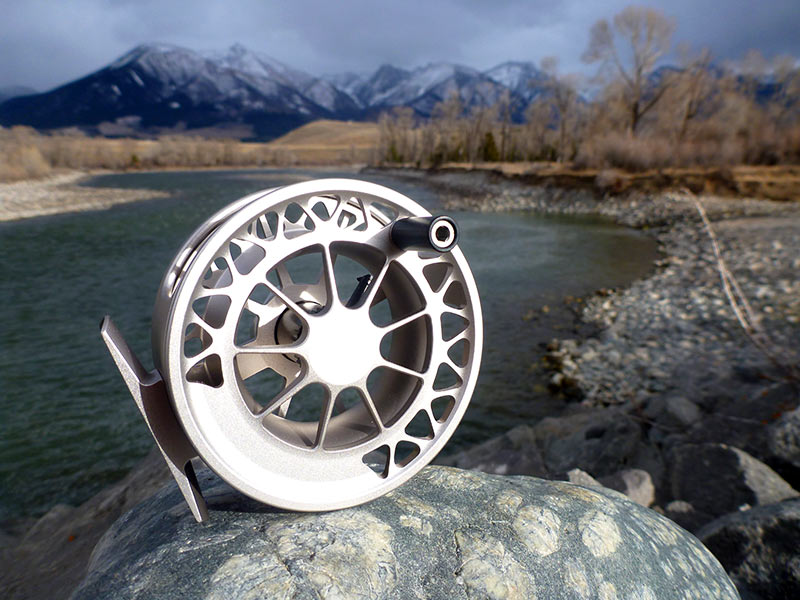
The Lamson Guru has become Lamson’s workhorse. Guides and price conscious anglers alike gravitate to the Guru since it is Lamson’s least expensive, fully machined reel, made in the USA. It has a reliable drag, utilizes a relatively large arbor and doesn’t break the bank. We suspect the Guru Series II is Lamson’s best selling reel, we know it has been for us anyway – and for good reason – it is a great value.
The Guru Series II reels don’t use porting on their arbors (which would help dry your backing) and the handles don’t have a nice swell as do the Speedster or Lightspeed. The reel’s foot isn’t ported either, if you want all these extras you’ll have to upgrade to one of Lamson’s more expensive models.
The only other nit-pick we have with the Guru is that it isn’t the most durable reel we’ve used. I’ve personally fallen with one on a rip-rap bank, smashing the reel into an irreparable state and had a fellow angler step on another, smushing it beyond repair. We’ve also seen these dent in the shop, so you’ll want to be extra careful using this reel.
Machined in Boise, Idaho the Guru comes in two standard colors: silver or black.
NOTES:
Retrieval Sound: Plasticky retrieval sound, OK but not as nice as Ross reels
Outgoing drag sound: Slightly deeper plastic sound going out
Spin: Not much (1.5 -2 revs)?
Counterbalance: Good – no counter weight, (just holes filled in with metal)
Spool Release: Spool pushes out (good can’t lose release cap since there isn’t one, although these can get tough to push out after several years of use).
Drag Knob: Design and tension make it more difficult to turn than other reels
Drag Detents: Not much for detents but drag knob is stiff enough so it won’t get knocked around easily
Range of drag: Good
Max Drag: Plenty strong – 4.5 pounds
Handle: Thin with no swell – Lightspeed, Force, and Speedster all better
Same strange odor as other Lamson drags
#19 Abel Super 4N $520 – reel, $285 x/spool
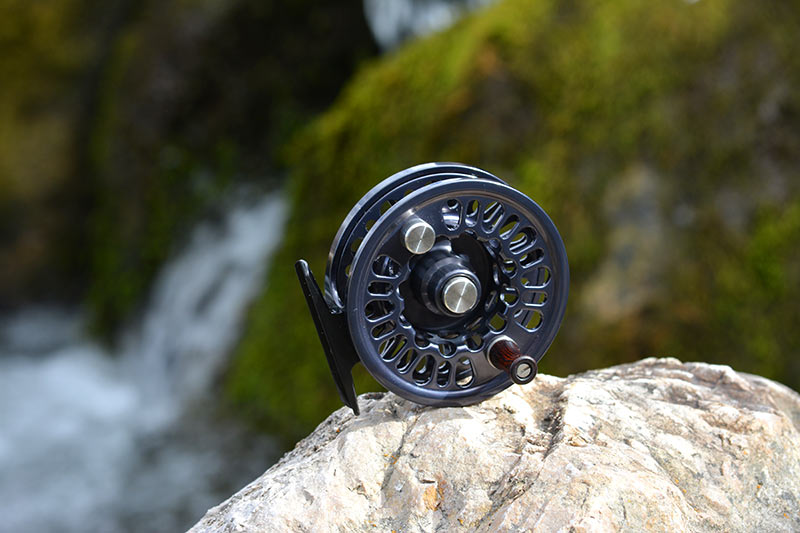
Here’s another reel that I thought would finish much higher. When buddies or clients of ours want to get the ultimate heirloom reel they frequently get a custom Super Series Abel reel. These reels are nearly bulletproof, sound great, and look fantastic. Nothing pimps out your rod better than a color Abel paintjob. If you pick a standard custom color you will be looking at a $75 upgrade. A fish graphic is going to run you an extra $200 and if you pick an artist series, plan on spending an extra $285-$500 extra just for the paintjob. Of course these are individually hand painted by an artist in house and look absolutely stunning.
Aside from the killer finishes that Abel has to offer, the Super 4N has a few other features that are worth noting. The drag knob is very easy to adjust and it has the best detents of any reel in the test. The reel sounds great reeling in or going out. The elegant rosewood handle has a great shape and swell, (although it could be slightly larger as on the Super 6N or 7/8N). We have even come to like the smell of an Abel (from Abel’s blue reel grease).
The main reason to shell out the extra dough for an Abel Super 4N is that it’s extremely durable. We’ve seen these reels take some amazing abuse and keep on clicking… If you often fish rip-rap banks or rock jetties this might be the perfect reel for taking fall after fall. We’ve even heard of Abel reels getting run over at high speed with a flats skiff and all the prop did was barely dent the frame and the reel’s foot. This is a high quality reel that is going to last for generations.
All that said, there are some disadvantages to the Super 4N. The main downside is that the Super 4N isn’t a quick-change reel. If you need to remove the spool for some reason (perhaps your tippet got tangled inside the reel, or some piece of rock or grit is stuck grinding between the spool and frame) you’re in trouble. You must use a coin, (or the bend of a hook in a pinch) to unscrew the drag knob nut, remove the screw and nut (both which can get lost) and pull out the spindle from the other side. This can be tricky in the shop, much less out on the boat or streamside, and that is the main reason this reel lost huge points in our “fun to fish/got to have” category.
The Abel Super 4N is also going to require more maintenance than other reels. If you ever hear your Abel cork drag “squeaking” it’s letting you know it needs some neatsfoot oil desperately. Also, you’ll want to oil the spindle and grease the clutches from time to time. Abel sells a reel lube kit for $35 that comes with an organized wallet to keep everything together.
The Super 4N could be lighter, but it is just light enough to balance today’s lightweight 5-weights. The range of drag adjustment is reasonable and the max drag is plenty strong. The arbor is well ported to allow your backing to dry quickly. The reel’s foot is ported as well to help lighten things.
Is the whole package deal worth the expensive price tag. “My sources say yes.” (Thank you magic 8-ball).
Abel reels are precision machined in Camarillo, California from the highest quality 6061-T651 cold finished aerospace grade aluminum. Standard colors are Black (Jet Black) or Satin Black (Matte Black). For an extra $75 custom solid finishes include: Blue III, Bronze, Deep Blue, Deep Green, Olive, Platinum, Red, Slate or “satin” (matte) Blue III, Olive, or Slate. Fish graphics and other general graphics retail for an extra $200; there are too many to list but you can check out many of these on Abel’s “Build your reel” website. Artist finishes range from $280-$500, like the ones from Borski, Prosek, DeYoung, Larko, or the Grateful Dead series.
NOTES:
Retrieval Sound: Excellent metallic on plastic sound reeling in
Outgoing drag sound: Totally different pleasant plastic sound going out
Spin: Decent (2 – 2.5 revs)?
Counterbalance: Perfect
Spool Release: Spool release – TOTAL PAIN – can lose nut, drag knob; inconvenient to remove the spool in the shop much less on stream.
Drag Knob: Easy to adjust,
Drag Detents: Huge detents so the drag can’t get knocked off, probably the best in the test
Range of Drag: Excellent
Max Drag: Very Strong – 4.5 pounds
Handle: Excellent rose wood handle with good flare – these can break over time if water gets in them and expands them or they are put away wet. Note – you can also opt for a plastic handle, which is also a great shape and more durable in the long run.
Smells like an Abel (gear grease)
Cork Drag – not the smoothest at higher settings, also requires maintenance
Heirloom quality machining – very solid and durable – with proper maintenance it will fish hard for 100 years
#20 (tie) Hardy Ultralite 4000 CA DD $275 – reel, $149 x/spool
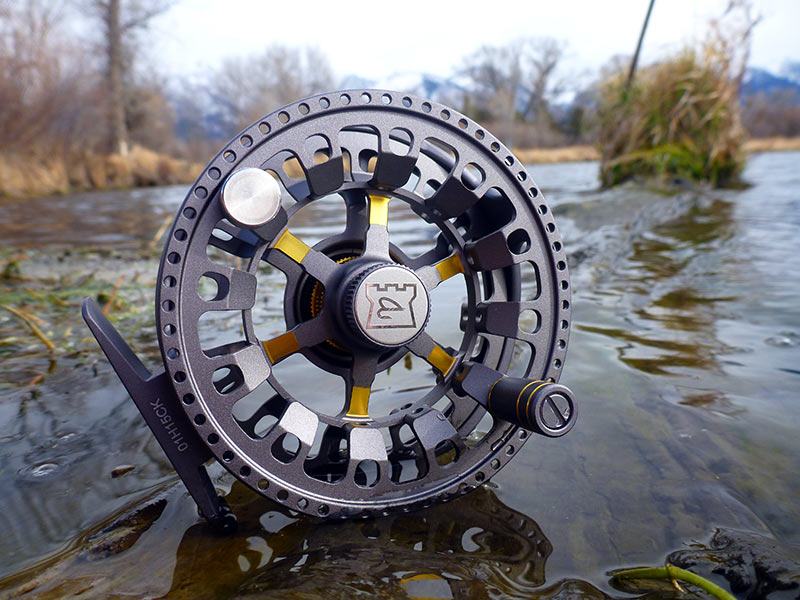
Despite the Hardy Ultralite’s 19th place finish, (mostly due to a narrow range of drag) we are still very excited about this reel. Had the drag range been better, the Ultralite would have easily been a top ten finisher. The new Ultralite 4000 CA DD features some excellent upgrades from last year’s model. Number one, it is much more durable. In essence, Hardy beefed up the Ultralite while still keeping weight down and simplifying the drag housing. The result is a more reliable reel, that can take a beating with the same large arbor and fast retrieval rate as before. We love the aesthetics of this reel – everyone we’ve shown it to has liked its rugged appearance.
Although the range of drag was limited compared to some of the top finishers, we love the drag detents and how easily the drag adjusts. At a glance the color coded range instantly lets you know where your drag is set. The reel sounds great (at least for two plastic clickers hitting metal) and the handle is easy to grab without looking. With a max drag of 6 pounds the Ultralite has more than enough power to land larger trout.
The Hardy Ultralite reels are machined in South Korea from high-grade aircraft 6061 aluminum. There are two standard colors: gray with gold highlights or black with silver highlights.
NOTES:
Retrieval Sound: Plasticky but pleasantly loud sound reeling in
Outgoing drag sound: Even louder out going plastic but pleasant sound
Spin: Not much (2-2.5 revs)?
Counterbalance: Good, however counterbalance weight is tall, which may feel like the handle if you weren’t looking down to grab it.
Spool Release: Awesome – easy to grab and can’t come off or get lost
Drag Knob: Easy to turn (and see where your drag is set)
Drag Detents: Good detents keep the drag from getting bumped off its setting
Range of Drag: Not good
Max Drag: Really strong! – 6 pounds
Handle: Could flare out more, be bigger with some swell at the end
Feels light for its size
Feel more durable than it’s predecessor
Reel seat has rivets instead of screws (shouldn’t loosen) like old reel seats?
Drastically ported and looks sharp!
#20 Ross Animas 4/5 $235 – reel, $141 x/spool
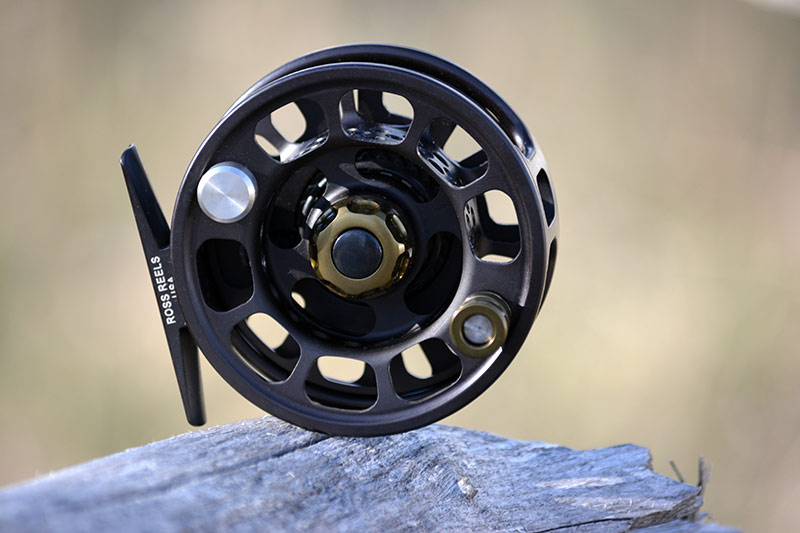
The Ross Animas is a great reel. We particularly love how well this reel spins. Like the Cimarron II reels, one flick of the wrist will send the Animas spinning (and retrieving line like crazy). Like the Cimarron II reels the Animas also sounds great, as most “spinner” style reels have a silent retrieval.
The main reason to spend the extra money on an Animas is that the arbor is ported which will allow the backing to dry faster than the Cimarron. That and the Animas’ spruced up looks. If you are OK with how the Cimarron looks, just stick with that since it’s the same basic reel, with an even better handle for $40 less.
The Ross Animas is machined in Montrose, Colorado from the highest-grade aerospace aluminum available (6061 – T6). The Animas comes in three standard colors: Stealth Black with Moss hardware, Stealth Black with Bronze hardware and Granite with Bronze hardware.
Like Bauer and Cheeky, Ross Reels donates 10% of each reel sold to the sport fish and wildlife restoration programs. They are also partnered with Trout Unlimited, the International Federation of Fly Fishers, the International Game Fish Association, and the Congressional Sportsmen’s Foundation. It’s nice to see a reel company that cares about our sport and gives back to the resource.
NOTES:
Retrieval Sound: Pleasant “plastic purr” retrieval sound (like the Cimarron)
Outgoing drag sound: Louder outgoing plastic purr (like the Cimarron)
Spin: Great spin (5-6 revs)? (And with sound vs silent)
Counterbalance: A little bit of wobble (looking at the center of the reel when spinning fast)
Spool release: Great, easy to depress, can never lose, quick
Drag Knob: More difficult to turn than Cimarron
Drag Detents: No detents per se but drag adjustment is stiff and won’t get knocked off easily
Max Drag: Wicked strong!!! – 9 pounds
Range of drag: Good but not as good as most in the .25-2 lb. range
Handle: Thicker than the Cimarron, good size but no flare
#20 Ross Animas 5/6 $250 – reel, $150 x/spool
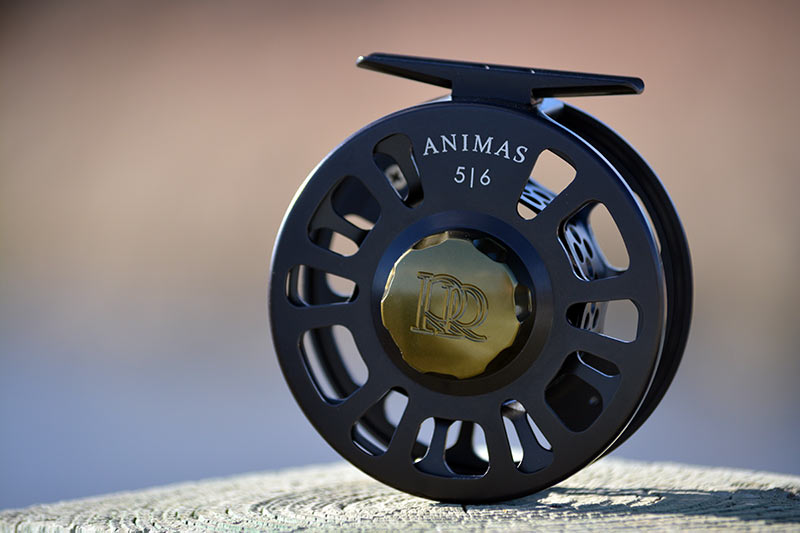
The Ross Animas 5/6 is identical to the Animas 4/5 but with a larger overall diameter, larger arbor, and wider spool. The main reason to purchase the 5/6 over the 4/5 is for greater backing capacity. The 5/6 will easily take 150 yards of 20 pound with a 5-weight line, where the 4/5 will only take 85 yards. Otherwise it makes more sense to fish the 4/5 which weighs .7 ounces less when fully loaded with the correct amount of backing, line, and a leader. If you are fishing with a 5-weight we recommend the 4/5. If you are fishing with a 6-weight then get the 5/6.
NOTES:
Retrieval Sound: Pleasant “plastic purr” retrieval sound (like the Cimarron)
Outgoing drag sound: Louder outgoing plastic purr (like the Cimarron)
Spin: Great spin (5-6 revs)? (And with sound vs silent)
Counterbalance: A little bit of wobble (looking at the center of the reel when spinning fast)
Spool release: Great, easy to depress, can never lose, quick
Drag Knob: More difficult to turn than Cimarron
Drag Detents: No detents per se but drag adjustment is stiff and won’t get knocked off easily
Max Drag: Wicked strong!!! – 9.2 pounds
Range of drag: Good but not as good as most in the .25-2 lb. range. It had a tiny bit more range of drag than the Animas 4/5
Handle: Thicker than the Cimarron, good size but no flare
Most anglers will want the Animas 4/5 since it is lighter and less expensive, unless you require more backing: The Animas 45 = 85 yards of backing. The Animas 5/6 = 150 yards of backing.
#21 Loop Evotec G4 LW 5/8 $479 – reel, $225 x/spool
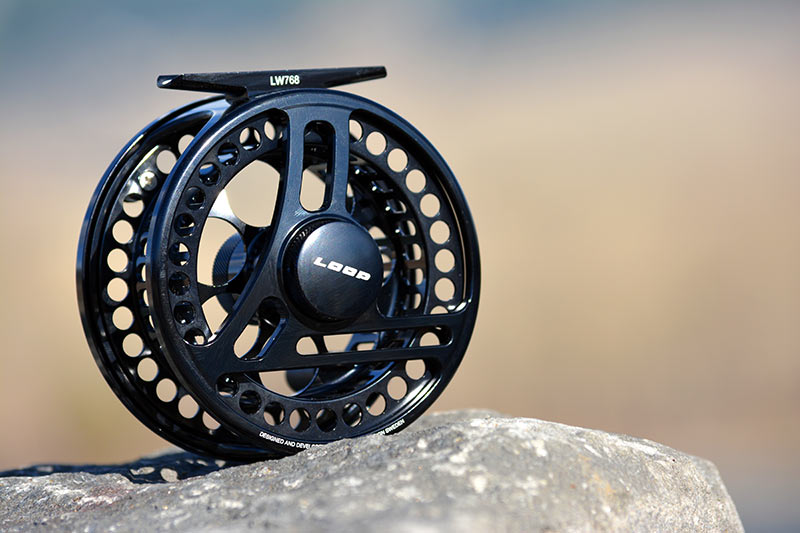
At first glance the Loop Evotec G4 LW 5/8 is too big for a 5-weight reel. Fully loaded it weighs 8.9 ounces; the second heaviest reel in the shootout after the Tibor Signature 5/6. We found that the 5/8 will only take 100 yards of 20 pound backing with a WF-5-F MPX line. Load this reel with an 8-weight line, for which it is rated, and you’d get very little backing because of the large arbor. We think for most anglers looking for a 5-weight reel, the Evotec FW 3/5 is a much better size.
One thing we can say about the Evotec G4 LW 5/8 is that is has the largest arbor in the shootout. At 2.818 inches tall and 1.782 inches wide, the Loop Evotec G4 LW 5/8 is a true line retrieval machine. Add the fact that this reel also spins well and you have a real weapon for picking up slack line in a hurry. We also like how the full frame adds rigidity and durability to the reel should you accidentally drop it.
Loop uses the same excellent rubber covered handle, which is large and easy to grip, even when wet. They also include an O-ring on the counterbalance, which can be utilized as a tippet holder when you are storing the reel. Unfortunately the spool release cap does come completely off, so you’ll want to be mindful not to lose it when you are removing the spool in the field.
The Loop Evotec G4 LW 5/8 is machined in South Korea from one piece of aircraft aluminum. All screws are secured with Loc-Tite. Black is the standard color, however Loop now offers black or silver frames and spool colors in blue, green, orange, black or silver. Extra spools (in black) retail for $225.
NOTES:
Retrieval Sound: Silent sound reeling in
Outgoing drag sound: Slight muted sound going out
Spin: Very good (2.5 -3 revs)?
Counterbalance: Perfect
Spool Release: Easy but Spool cap comes off and can get lost. A bigger 0-ring would help?
Drag Knob: Easy enough to adjust
Drag Detents: Not great, could be knocked off by accident.
Range of Drag: Not very good
Max Drag: Good – 3.5 pounds
Handle: Nice rubber grip but no swell
Too big and bulky for a 5-weight reel
#22 (tie) Orvis Hydros SL II $198 – reel, $98 x/spool
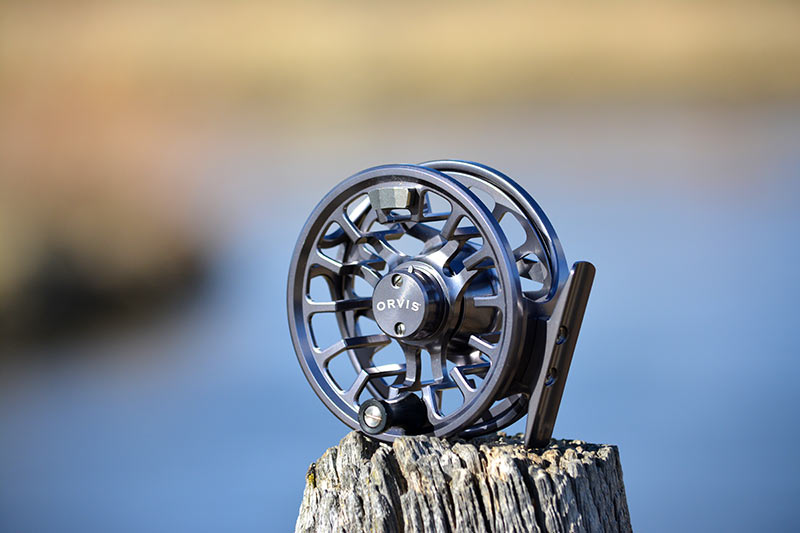
Seeing how much we like the Orvis Hydros SL II for saltwater, (it’s one of our favorite best buy 8-weight reels), we thought the 5-weight version was going to do equally well in fresh. The main thing that held it back from the podium was its weight. At nearly 7 ounces fully loaded, this reel is going to be a tad too heavy when balancing the best 5-weight outfits.
While the drag is amazingly strong, for a 5-weight it is overkill and unnecessarily heavy. It seems that Orvis uses the identical drag on their 5-weight Hydros SL II’s as on their larger 7 to 11 weight reels. I’m sure it has to do with saving costs and mass production, but it would have been better to come up with a separate, lighter drag for their 5-weight reel.
Still, the Hydros SL II offers some great features. It has a nice large arbor design, creating a 12% increase in line retrieval from the previous Hydros. We also like how well the arbor is ported, which will really help with drying backing more quickly. The Hydros SL II also comes with a maintenance free sealed drag. It has terrific drag detents that prohibit the drag knob from getting knocked off the desired setting. Although the drag knob is a strange shape the drag is easy enough to adjust. While we don’t have long term experience with this reel, it does appear to be quite durable.
We wish the Hydros SL II had a wider range of drag between .25 and 2 pounds. (At least the range will be better for saltwater use with the larger reels). The handle is a little shorter than others but it has a nice shape and good swell. The drag sound could be louder, and the Hydros doesn’t spin nearly as well as some.
The Orvis Hydros SL II is machined in China from high quality aircraft aluminum.
Notes:
Retrieval Sound: Same plastic on metal sound reeling in or going out
Outgoing drag sound: Same plastic on metal sound reeling in or going out
Spin: Not good (1 – 1.5 revs)?
Counterbalance: Good
Spool Release: Spool latch can’t be lost – unless screws come off. Dirt may enter over time like Hardy LRH. Tiny bit of suction to get spool off
Drag knob: Unique cut out – easy to twist but somewhat odd shape
Drag Detents: Excellent drag detents keep drag setting from getting knocked off
Range of Drag – Not great (at least between .25 – 2 pounds)
Max Drag: Extremely strong! – 11 pounds
Handle: Nice shape and size (good swell)
Feels a bit heavy (due to heavy drag mechanism, same one used on bigger Hydros SLII’s)
A lighter reel with less drag power would be better
#22 (tie) TFO BVK II $249.95 – reel, $149.95 x/spool
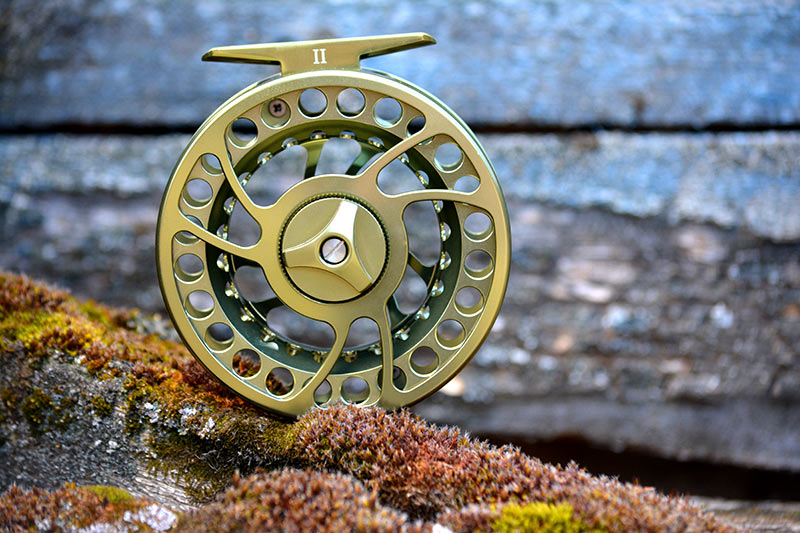
The BVK Super Large Arbor series reels offer the angler solid performance at a decent price – something TFO has been all about since day one. The arbor measures at 2.475 inches, the third largest in the shootout, (following the Loop Evotec G4 LW 5/8 and Sage Click 4/5/6). The TFO BVK also spins relatively well, making line retrieval both quick and easy. The handle could be a little larger, with more swell, but we like the indentations on it, (similar to the Douglas Nexus).
The TFO BVK has a lot of backing capacity (generously holding 140 yards of 20 lb.), which in the end caused it to weigh more than other reels when fully loaded. One thing we wish the BVK had was a wider range of drag, and we know from experience this reel isn’t nearly as durable over the years as others. Still, for the money this is a good option, and unlike the TFO large arbor reels that we love for 8-weights and two handed rod setups, the TFO BVK comes with a reel case.
The TFO BVK reels are precision machined in South Korea from bar stock aluminum. BVK reels only come in one color: Moss Green. Extra spools in size II retail for $149.95.
NOTES:
Retrieval Sound: Same plastic click sound both ways
Outgoing drag sound: Same plastic click sound both ways
Spin: Good (2-3 rev)?
Counterbalance: Good
Spool release: Easy (like Hardy LRH) can’t lose any parts, after years of use grit can get in there
Drag knob: Easy to adjust until highest setting
Drag Detents: Solid detents keep drag setting from getting knocked off
Max Drag: Very Strong – 5.5 pounds
Range of drag: Below average
Handle: Nice size, could have a little more swell
Nice large arbor – reels in quickly
Doesn’t seem as durable as some
#23 (tie) Abel SD 4/5 $595 – reel, $330 x/spool
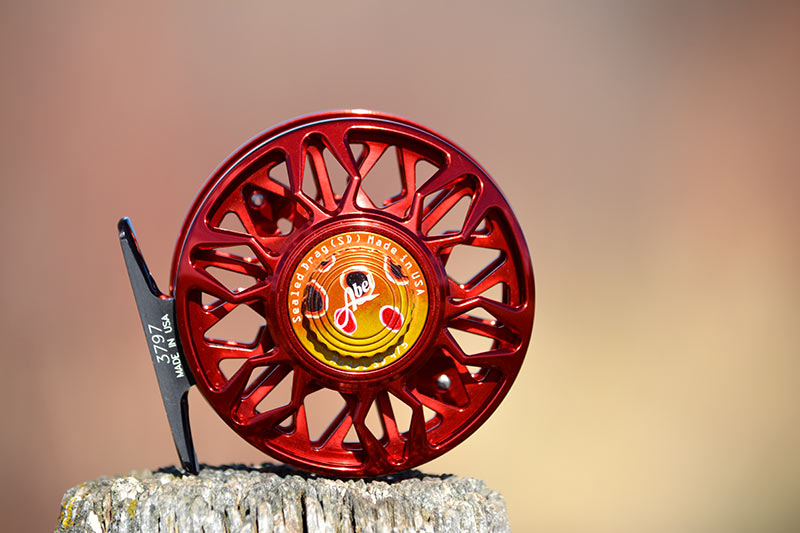
We were surprised to see the Abel SD reels place as low as they did. If anyone gave me the choice between a free Abel SD and Galvan Rush, I think I’d take the SD in a heartbeat, despite the fact that it didn’t acquire as many points. These reels are totally solid and are the epitome of what well-machined reels look like. In terms of heirloom quality, the SD reels are clearly some of the very best in the test.
Why then did they score so low? Price was certainly a factor, as was overall weight. They sound OK, but nothing compared to the Super 4N, and the sound was not nearly as loud as others. They have very little spin, so slapping the face of the spool to reel up line quickly won’t get you anywhere with an Abel SD. Plan on reeling in the traditional way. The biggest thing that hurt the Abel SD reels (especially the 4/5) was its narrow range of drag adjustment. Between .25 and 2 pounds we found the 4/5 only had half a full rotation of adjustment, where the Galvan reels and the Tibor Signature had 2.25 turns of drag adjustment. Perhaps this isn’t a huge deal since most anglers will leave the drag setting relatively low and override the drag by palming if they need to. The 4/5 only takes 65 yards of 20 pound backing, but we felt this was plenty for trout fishing, (how often do you really ever even get into your backing trout fishing)?
What did score big for the Abel SD was craftsmanship and durability. This puppy is built well and built to last! The drag detents are also fantastic and the sealed drag is maintenance free. This is a true quick-change reel, which is a major upgrade from the Super 4N style of spool removal. We also like how the arbor is ported, which will allow your backing to dry faster.
Details of Abel’s color options can be found in our write up of the Abel Super 4N earlier.
Notes:
Retrieval Sound: Almost underwater like muted sound reeling in (compared to Super Series)
Outgoing drag sound: Same unimpressive sound going out
Spin: almost none – (1 revs?)
Counterbalance: Perfect
Spool Release: Spool cap can’t come off – a bit harder to get off however than others
Drag Knob: Easy to turn
Drag Detents: Awesome detents – drag setting not easily knocked off by accident
Range of Drag: Not good (due to stopper which inhibits drag range drastically)
Max Drag: sufficiently strong – 3 pounds
Handle: Excellent shape and feel – rosewood. Could be a tiny bit longer.
Feels heavy for its size, although very durable
Excellent machining and quality feel, second to none on color
Spool is a bit too narrow
Slight gap between spool and frame
Better size for most 5-weight rods (rather than larger 5/6)
#23 (tie) Lamson Remix $159.95 – reel, $45.95 x/spool
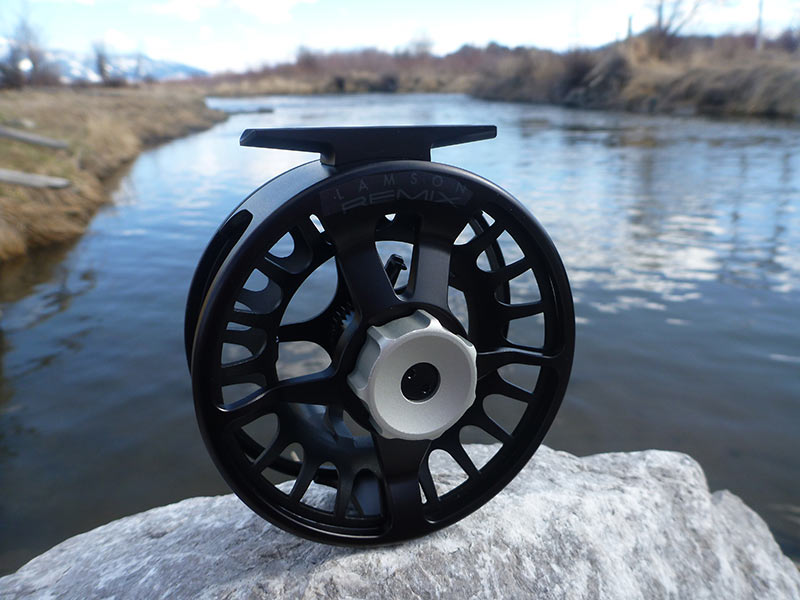
The Lamson Remix is a half machined, half cast reel with some very nice performance figures for an inexpensive reel. The spool is the exact same pressure cast spool that the Lamson Liquid uses. The upgrade with the Remix is a machined frame rather than a pressure cast frame like the Liquid. Perhaps it was just our sample, but the Lamson Remix had a lot less start up inertia compared to the Liquid. The machined frame also appears to be more scratch resistant than the spool. (From being in the box with other reels the Remix’s spool already is starting to show some scratches while the metal frame only had one scratch).
Strangely enough the range of drag adjustment on the Remix wasn’t nearly as good as the Liquid. The Remix is also slightly heavier than the Lamson Liquid.
The handles are the same, which are nice and long but could use a little more swell towards the end like their more expensive brethren. The arbors are ported near the sides, but not where the backing will rest so your backing may not dry as quickly with these reels as others.
Still, both the Remix and Liquid reels utilize a rather large arbor and will quickly retrieve your line. While they are not the lightest reels out there, they weigh under 6 ounces fully loaded and are just light enough to balance most modern lightweight 5-weights.
The Lamson Remix reels are machined/pressure cast somewhere overseas, (Lamson wouldn’t say where) and are then “assembled” in Boise, Idaho in order to make the reel more affordable. The Remix and Liquid reels only come in black, however Lamson offers three different color drag sleeves for $9.95 each: Burnt Orange, Salsa Green, or Coral Blue. Extra Liquid/remix spools in size 2 retail for $45.95.
Notes:
Retrieval Sound: Plasticky retrieval sound OK but not as nice as some
Outgoing drag sound: Slightly deeper plastic sound is louder going out
Spin: Not much (1 -2 revs)?
Counterbalance: Good – no counter weight extra material balances the spool
Spool Release: Spool pushes out (good can’t lose release cap since there isn’t one), however over time these become harder to push out
Drag knob: Nicer than the Liquid, easier to grab
Drag Detents: No detents but drag knob is stiff enough that you can’t bump it off easily
Range of drag: Good
Max Drag: Almost twice as strong as the Liquid we tested – 4.25 pounds
Handle: OK – not as good as others – good length but no flare
Spool is cast, frame is machined (overseas) and “assembled” in the USA
Cheap feel in hand but still decent performance
Drag – smells funky
#24 Abel SD 5/6 $670 – reel, $370 x/spool
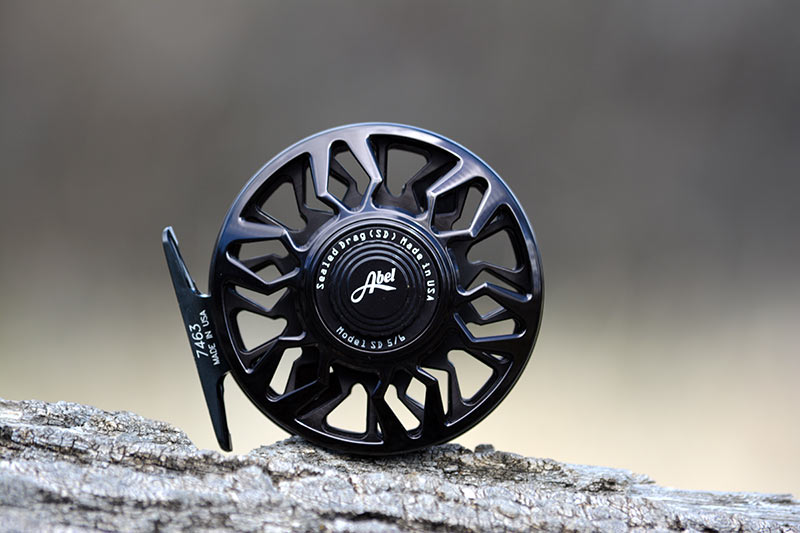
The Abel SD 5/6 is identical to the 4/5, just a little bigger with more backing capacity. Abel’s website says the 5/6 will take 199 yards of 20 pound backing, (which might be true if you don’t put any line on it). We found the SD 5/6 will take about 85 yards of backing (where as the 4/5 will take about 65). To our way of thinking you’re better off getting the smaller size, which weighs .6 ounces less for only 20 less yards of backing. Also, the 4/5 is $75 less expensive.
Check out our 4/5 write up above for more details on these heirloom quality SD reels.
Details of Abel’s color options can be found in our write up of the Abel Super 4N earlier.
Notes:
Retrieval Sound: Not bad compared to others but almost “underwater like” muted sound reeling in (compared to the killer Super Series retrieval sound)
Outgoing drag sound: Similar unimpressive sound going out
Spin: Almost no spin – 1.2 revs?
Counterbalance: Perfect
Spool Release: Spool cap can’t come off – a bit harder to get off than some but at least it’s a quick change.
Drag knob: Easy enough to grab
Drag Detents: Very solid detents (other reel companies take notes here)
Range of Drag: Better than the Abel SD 4/5 but still not very good
Max Drag: Plenty Strong – 3.5 pounds
Handle: Excellent shape and feel – rosewood. Slightly bigger (and better) than the handle on the Abel SD 4/5
Feels a tad heavy (due to heavy sealed drag)
Spool is a bit too narrow
Slight gap between spool and frame
Excellent machining and quality feel, second to none on color option
#25 (tie) Lamson Force 1 $499 – reel, $219.95 x/spool
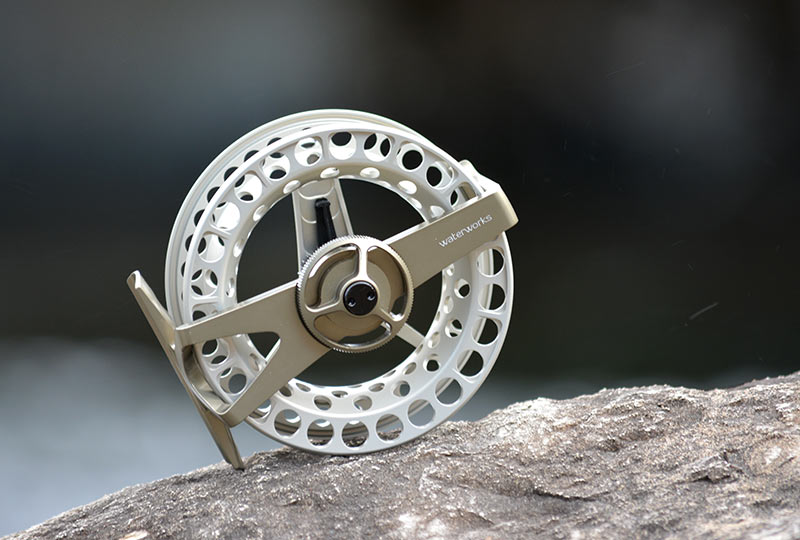
The Lamson Force isn’t for everybody. For those anglers who are good at taking care of their gear and can use exceptionally light equipment without breaking it the Force is an excellent choice. It will balance even the lightweight 3 or 4 weight outfits. If you happen to be an angler who is rough on gear however, we recommend steering clear of this reel. Even one direct hit from a fall will could ruin this reel beyond repair. We also noticed that our sample reel’s drag knobbed wobbled badly when we backed off the drag completely – something we wouldn’t expect from a $500 reel.
Aside from the durability aspect, the Force does have some high performance features – namely the weight. This reel weighs an amazing 4.3 ounces fully loaded with 115 yards of backing, a WF-5-F MPX line and a 12 foot leader. That beats nearly every other reel weighed naked! And the reel itself weighs only 2.8 ounces!
Another high performance feature is the Force’s large arbor. At 2.42” the Force is one of the best at line retrieval. While the drag is not nearly as strong as the Lightspeed, it is stronger than the Speedster and Liquid. And the range of drag adjustment at 1.4 turns is pretty solid. The Force comes with a well designed handle that is easy to grab as well.
The Force is slightly more difficult to remove the spool from than the other Lamson reels, especially when the line is overloaded (due to too much backing). Taking the spool off is easy enough but getting it back on can prove to be challenging.
The Lamson Force is machined in Boise, Idaho from the highest quality aluminum. The Force is unique in the fact that the drag is machined into the frame, unlike the other drags, which must be attached to Lamson’s frames. Extra Lamson Force spools in size 1 or 2 retail for $219.95.
Notes:
Retrieval Sound: Plasticky retrieval sounds OK but not as pleasant as some
Outgoing drag sound: Slightly deeper plastic sound (louder going out)
Spin: Not much (1.5 -2 revs)?
Counterbalance: Good
Spool Release: Spool pushes out (good can’t lose release cap since there isn’t one). This spool release is more difficult to push out than the other Lamson models, and is also more difficult to put back when the spool is fully loaded. We know that, over time, the spool gets more difficult to remove.
Drag Knob: Easy to grab however on light settings the drag knob wobbles badly and doesn’t feel very secure
Drag Detents: No detents and the drag isn’t quite stiff enough to keep the setting in place
Max Drag: Strong enough for most all trout fishing situations – 2.75 pounds
Range of drag: Good
Handle: Long and thin with flare – easy to grab, good design
Awesome looks and super light feel
Probably the least durable reel in the shootout – one bad spill and you’re done
Drag smells funky
#25 (tie) Hardy Ultralite 5000 MA $275 – reel, $149 x/spool
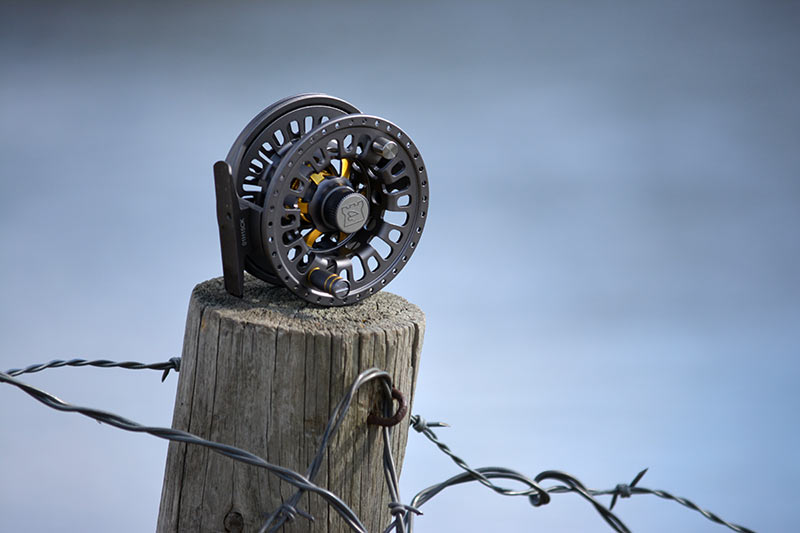
The Hardy Ultralite 5000 MA is similar in construction to the Ultralite 4000 CA DD, but with a medium-sized arbor and much wider spool. For anglers looking for more backing capacity, the 5000 is a good option as it will hold 160 yards of 20 pound backing while the 4000 will adequately hold 120 yards of 20 pound backing. The 5000 MA also has a slightly stronger drag. Its max drag is 8 pounds compared to the 4000’s max drag of 6 pounds. The range of drag adjustment is the same for reels, which we wish was a little wider so you can fine tune your drag to the exact pressure you prefer for fishing 5, 6, or 7X tippets.
In general, we like the Ultralite 4000 CA DD more since its larger arbor will help you to retrieve line faster. The 4000 also weighs .8 ounces less than the 5000 when fully loaded. There are anglers, however, who don’t like the modern “taller” reel look, and for them the 5000 MA is another solid, more traditional looking option.
The Hardy Ultralite reels are machined in South Korea from the high-grade aircraft 6061 aluminum. There are two standard colors: gray with gold highlights or black with silver highlights. Extra 4000 spools retail for $149.
NOTES:
Retrieval Sound: Plasticky but pleasant loud sound reeling in
Outgoing drag sound: Even louder out going pleasant plastic sound
Spin: Pretty good (2-2.5 revs)?
Counterbalance: Good – solid and smooth
Spool Removal: Spool cap – awesome – easy to grab and can’t come off or get lost
Drag Knob: Drag knob easy enough to turn, and easy to see what setting it’s on
Drag Detents: Drag knob not easily knocked off by accident – excellent detents
Range of Drag: Not very good
Max Drag: Really strong! – 8 pounds
Handle: Could be bigger with more swell at the end
Feels more durable than its predecessor
Reel seat has rivets instead of screws (shouldn’t loosen)?
Same basic reel as Ultralite 4000, only wider and less tall
Isn’t as ported as drastically as the 4000
#26 Redington Behemoth $109.00 – reel, $59.95 x/spool
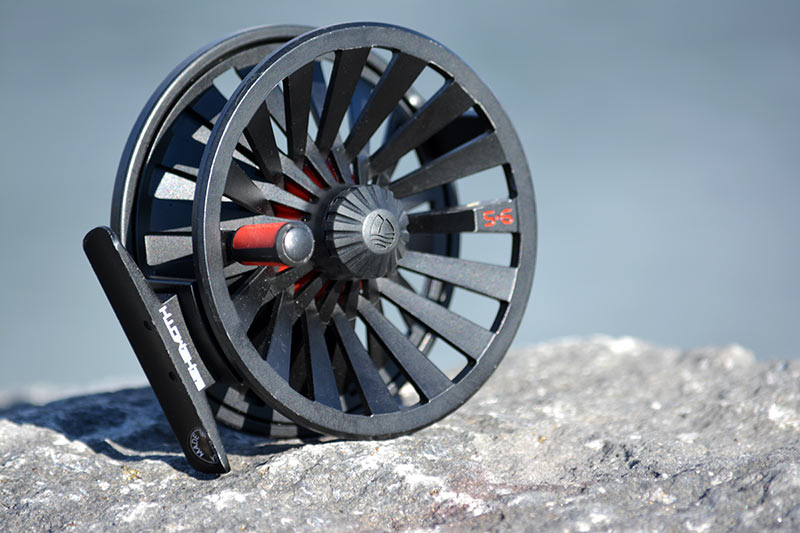
The Behemoth is Redington’s newest, coolest looking reel, boasting the most powerful drag in its class. It does have a very strong max drag, tipping the scales at 9 pounds of drag pressure… The Ross Eddy also has a max drag of 9 pounds. Our question to both Redington and Ross is WHY? People are never going to use that much drag pressure for trout fishing so while the bragging rights count, they don’t count for much.
What does count, are the unique and stylish Behemoth looks. The fact that the Behemoth is not machined and instead uses a die-cast construction has allowed Redington to dabble in some new reel designs that are impossible to machine – namely the aesthetically pleasing spoke design used on the Behemoth’s spool. Perhaps we should have rated this higher in our craftsmanship category, but all cast reels were docked compared to machined reels.
For an inexpensive reel, the Behemoth has a decent range of drag adjustment although this might be an area the Behemoth could improve most on. For $109 we aren’t going to be too nitpicky. The drag knob is large and easy to adjust. The handle isn’t quite as big as we’d like, and has no swell, but we do like the rubberized grip. Depending on how hard you pull on the spool release button it will either stay on or pull off, so be mindful not to lose it in the field. You’ll also want to be careful not to lay this reel on the rocks as it scratches quite easily compared to others.
Last but not least, the Behemoth is a little on the heavy side. At 6.9 ounces fully loaded it is going to be slighty too heavy to balance the best 5-weight rods. We suspect the Behemoth will be a great reel for two-handed rods, where more weight is preferable for balancing.
The Redington Behemoth reels are die-cast in South Korea. They come in two standard colors: Black (with red highlights) or Gunmetal. Extra 5/6 spools retail for $59.95.
Notes:
Retrieval Sound: Same plastic click sound both ways
Outgoing drag sound: Same plastic click sound both ways
Spin: Not good (.75 -1.5 rev)?
Counterbalance: Good
Spool Release: Cheap spool release cap: can come off with too much pressure
Drag knob: Easy to adjust
Drag Detents: No detents, drag could possibly get knocked off setting
Max Drag: Very strong! – 9 pounds
Range of drag: Good
Handle: Nice rubberized coating for easy grip, could be bigger and use a little more swell at the end
The price is right!
Looks cool but feels cheap
Doesn’t seem as durable in the long run?
Easily scratched
Feels heavy
#27 Bozeman Reel RS 325 $410 – reel, $195 x/spool
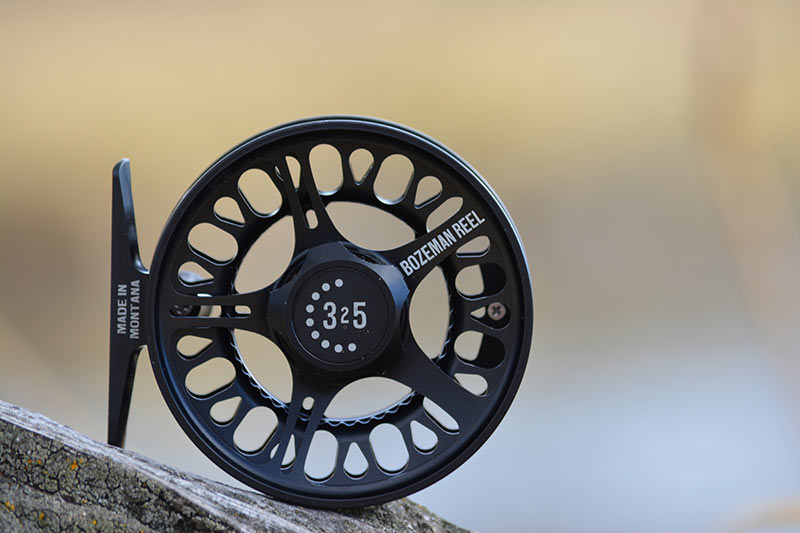
We had high hopes for the locally manufactured Bozeman RS 325. Some hopes were met, others not so much. The RS “River Series” has it its own set of pros and cons.
Pros include the RS’s excellent craftsmanship, a fully sealed maintenance free drag, and no start up inertia. We’ve fished the RS for a couple years now and we know that it is a durable reel that can take a beating without denting. The 3.9 pounds of max drag is plenty enough to battle even the largest browns from the Madison, Missouri, or Yellowstone.
Where the RS lost most of its points was in the range of drag adjustment. Between .25 and 2 pounds the RS only had .45 turns of adjustment, compared to some of the top ranking reels that had more than 2 turns of adjustment. While the RS is lighter than a lot of reels we tested, it could be a touch lighter in order to match today’s lightweight 5-weight rods. The spool release cap is easy enough to use when new, but after a couple of seasons of fishing, dirt and grit have made unscrewing it tougher. Last but not least, the price could be lower to compete with Lamson or Ross, but consider this – Bozeman doesn’t make thousands and thousands of reels each year. Although the RS may cost a little more, it’s nice to support local and small businesses with your purchase.
Bozeman Reels are machined in Bozeman Montana out of the highest quality aircraft aluminum. We have actually gone to visit the factory and the facility is very impressive. The RS series only comes in one color: black. The RS reels come standard with a neoprene reel case, however, if desired you can upgrade to one of their hand made canvas reel cases, which includes a Montana elk antler button. The canvas reel case also comes with a delightful wooden gift box. Extra 325 spools retail for $195.
Notes:
Retrieval Sound: Rubber on plastic sound in or out
Outgoing drag sound: Rubber on plastic sound in or out
Spin: Not much (1.5 -2rev)?
Counterbalance: Good
Spool release: Spool release cap is easy release new, but after a year or so of use dirt and grit can make it more difficult to get off
Drag Knob: Easy to adjust
Drag detents: No detents but stiff enough drag knob to keep it from getting knocked off
Max Drag: Strong – 3.9 pounds
Range of drag: Very short
Handle: Nice swell but could be a little longer
Feels a little heavy in hand but durable
On the expensive side but also cool to support and buy local
#28 Islander LX 3.2 $565 – reel, $282 x/spool
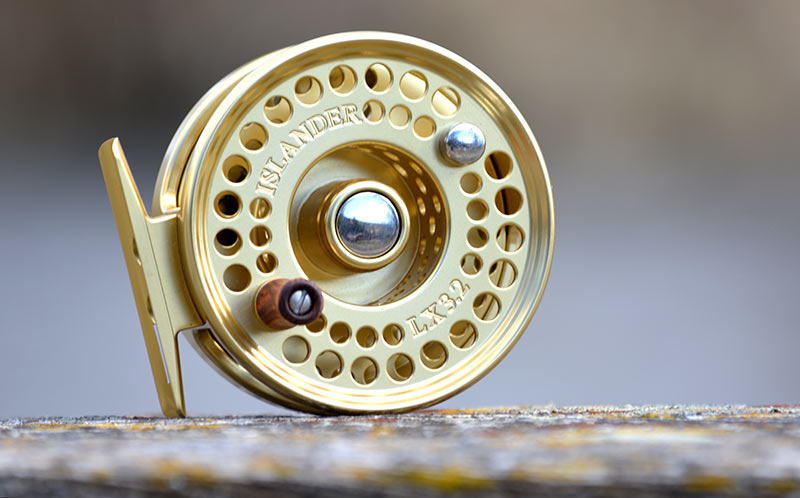
The Islander LX is an amazing reel. They are extremely durable, and the craftsmanship is second to none. Their Teflon and graphite impregnated cork drag disc is especially smooth, and the reel sounds amazing with two very distinctive incoming and outgoing sounds. The retrieval sound is very much like a Abel Super 4N. The outgoing sound is unique, loud, and pleasing to the ear – created by a noise specific metal pawl located inside the reel.
We wish the Islander had a little more range of drag between .25 and 2 pounds. And we wish it was a little lighter. The arbor could be larger for faster line retrieval but we like how it is ported to help your backing dry quickly. Although the spool isn’t the easiest to remove, it still qualifies as a “quick-change” reel, which is rare for a reel with a cork drag system. Do be careful not to lose the drag knob (which is also the spool release knob) as it has to come off in order to remove the spool.
All and all, the Islander is a top quality reel with a lot of character to it. It would certainly make for a great “pass it down” heirloom reel.
The Islander LX 3.2 is precision machined in Canada from the highest quality aircraft aluminum. The LX is available in four standard colors: Black, Clear, Gold, and Slate as well as two special order colors: Blue or Pink. Extra 3.2 spools retail for $282.
Notes:
Retrieval Sound: Excellent loud metallic retrieve
Outgoing drag sound: Excellent uniquely different metallic outgoing sound
Spin: Surprisingly good for a “loud” reel (1.5-2 revs)?
Counterbalance: Excellent
Spool Release: Spool cap is actually the drag cap – comes off (careful as it could be lost) but at least it’s a cork drag with a quick-change system.
Drag Knob: Easy to turn, but can come off
Drag Detents: No detents and drag knob isn’t stiff enough; you can knock the drag setting off accidentally
Range of Drag: Not very wide
Max Drag: Plenty strong – 4 pounds
Handle: sweet wooden handle – could be longer with a bit more swell at the end
Kind of heavy for size, but feels durable
Cool Cork Drag system, intricate parts, very well made
“Abel of the North”
#29 (tie) Aspen 350 LA $250 – reel, $120 x/spool
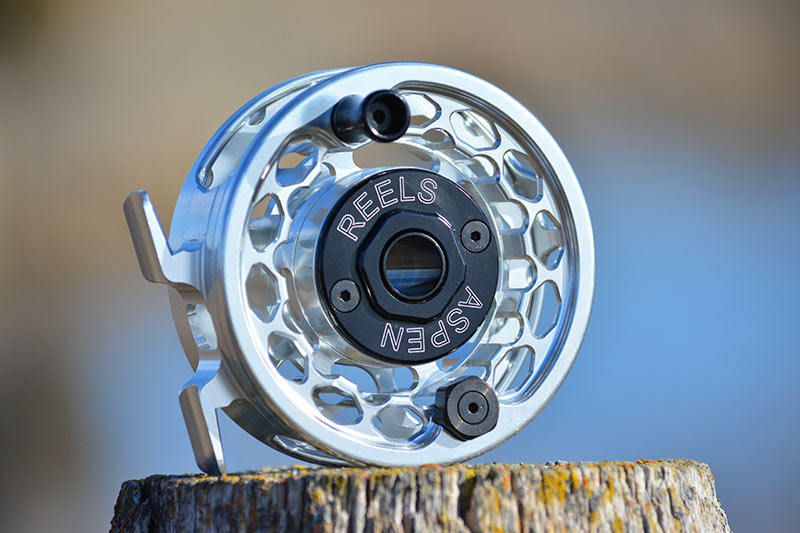
Here’s another reel that we thought would finish higher. Aspen Reels believe that a fly-fishing reel should be simple, strong, affordable, and made in the USA. Hats off to the folks at Aspen, that’s a solid check mark in each department…
One thing’s for sure – this reel is durable! Like the Tibor Signature 5/6 and Abel reels, if you accidentally take a bad fall the Aspen 350 LA is the last thing you need to worry about… it’s exceptionally tough and isn’t going to dent or bend like some of the competition. The sealed drag is maintenance free and has no noticeable start up inertia, even at higher drag settings. The max drag is plenty strong for trout fishing and we like the shape of the handle’s swell (although it could be a tiny bit bigger for a perfect handle score). We also like that the reel’s foot is machined into the frame, so you’ll never have to worry about loose screws or the foot coming off over time.
Another cool thing that Aspen Reels does that no one else is doing is to include an engraving inside the reel of the recommended amount of backing. To see this, remove the spool and look on the “under” side of the spool.
A few things held it back from a top finish. First off is the weight – it’s heavy for 5-weight reel. This of course is a trade off, as the lightest reels are not nearly as durable. Also the range of drag adjustment between .25 and 2 pounds is narrower than most. While the drag knob doesn’t have any detents it’s stiff enough that you won’t likely knock it off your desired drag setting. The arbor is ported to help backing dry more quickly, however we noticed that some of the machining here didn’t feel as finished as some reels, the ported rectangles felt slightly “rough,” although not enough to cut your backing.
The Aspen Reels 325 Large Arbor is a very solid reel for the money. If your style of fishing requires a very tough reel and you can’t afford an Abel or Tibor, the Aspen 325 LA is a great option.
Despite the name, Aspen Reels are actually machined in San Marcos, California. The 325 LA comes in two standard colors: black or clear (silver). Extra 325 LA spools retail for $120.
Notes:
Retrieval Sound: Pleasant plastic on metal incoming sound
Outgoing drag sound: Pleasant plastic on metal outgoing sound, perhaps “deeper”
Spin: Pretty good 2.5-3.5 revs?
Counterbalance: Perfect
Spool Release: Reel pushes off frame easily – (can never lose spool release cap since no cap)
Drag knob: Easy to turn, (until the very highest drag settings)
Drag Detents: No detents but not easily knocked off by accident
Range of Drag: not very wide
Max Drag: Plenty Strong – 3.75 pounds
Handle: Great shape but could be a bit longer
Machined reel seat – can never come loose, might be get dented if dropped however, which means replacing a new frame instead the reel seat.
Feels a tad heavy for its size, but VERY DURABLE at the same time
Rough manufacturing cuts where backing sits (feels unfinished – only LA, the MA was smooth)
Excellent spool to frame tolerances – some of the best in the test
#29 (tie) Lamson Liquid 2 $99.95 – reel, $45.95 x/spool
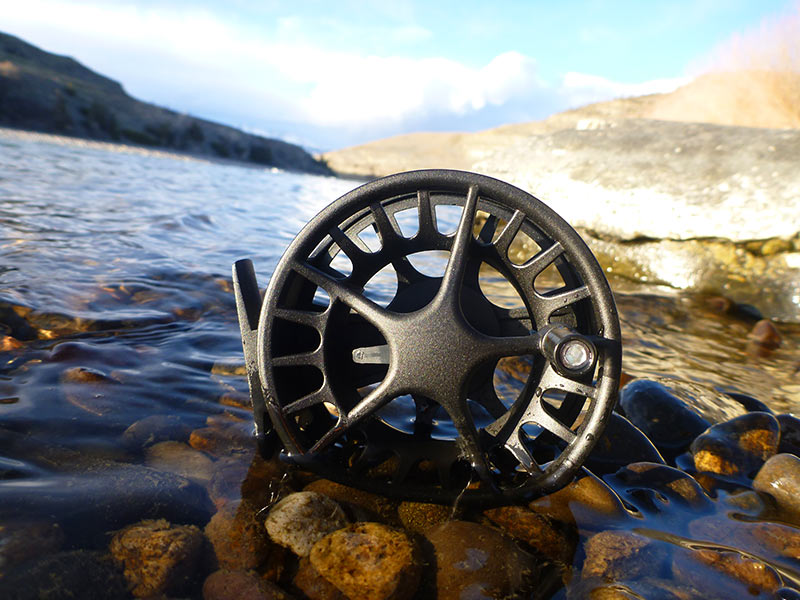
The Lamson Liquid was designed to be a high performance reel at a more affordable price. At $99.95 we think Lamson did a great job at making a reel that not only performs well, but is inexpensive. The Lamson Liquid is the reel that we picked to go with our beginner fly fishing outfit for this very reason.
Weighing 5.7 ounces (fully loaded), the Lamson Liquid is one of the very lightest reels in its price category, along with the two click style reels, the Redington Zero ($89.95 / 4.2 oz.) and Orvis Battenkill ($119 / 4.7 oz.). With a large arbor design and 2.5 pound max drag, the Lamson Liquid is well equipped to reel line in quickly and fight larger trout. The Liquid’s range of drag adjustment is good, especially for a less expensive reel and the drag is smooth to boot. The handle is easy enough to grab, although it has no swell like the Speedster, Lightspeed, and Force.
The main downside to the Liquid is that it’s not machined, rather it is cast in a high-pressure mold. This means the Liquid will scratch much more easily than Lamson’s other reels that are fully machined with a hard alox finish. They are not nearly as durable as some reels.
We found this reel was one of the few with a lot of start up inertia, especially at higher drag settings. Anglers who fish 6X or thinner tippet, might break off fish on the initial run with this reel due to the start up inertia. The drag knob is easy enough to turn, but it doesn’t have any drag detents and on the lower drag settings the knob can be accidentally
bumped, knocking off the desired drag setting. The included reel case is more like a cloth sack with little protection from drops, but for the money we’re not going to complain.
If you can afford the Guru series II reel ($209) then get it instead. If you are looking for a less expensive reel, we think the Liquid makes more sense than the Remix as it costs less and is nearly as good.
The Lamson Remix reels are machined/pressure cast somewhere overseas, (Lamson wouldn’t say where) and are then “assembled” in Boise, Idaho in order to make the reel more affordable. The Remix and Liquid reels only come in black, however Lamson offers three different color drag sleeves for $9.95 each: Burnt Orange, Salsa Green, or Coral Blue. Extra Liquid/remix spools in size 2 retail for $45.95.
Notes:
Retrieval Sound: Plasticky retrieval sound OK but not as nice as some
Outgoing drag sound: Slightly deeper plastic sound is louder going out
Spin: Not much (1 -2 revs)?
Counterbalance: Good – no counter weight extra material balances the spool
Spool Release: Spool pushes out (good can’t lose release cap since there isn’t one), however over time these become harder to push out
Drag knob: Easy enough to turn
Drag Detents: No detents but drag knob is stiff enough that you can’t bump it off easily
Max Drag: Strong enough, although you may have to palm larger fish – 2.5 pounds
Range of drag: Good
Handle: OK – not as good as others – no flare
Spool is cast, frame is cast (overseas) and “assembled” in the USA
Cheap feel in hand but still has decent performance
Reel seat is built in, no way to lose it, however if you drop it and break (or bend) it you may have to pay more for an extra frame vs an extra reel seat.
Prone to scratches compared to Guru
Drag smells funky
#30 Loop Multi 3-6 Light $265 – reel, $79 x/spool
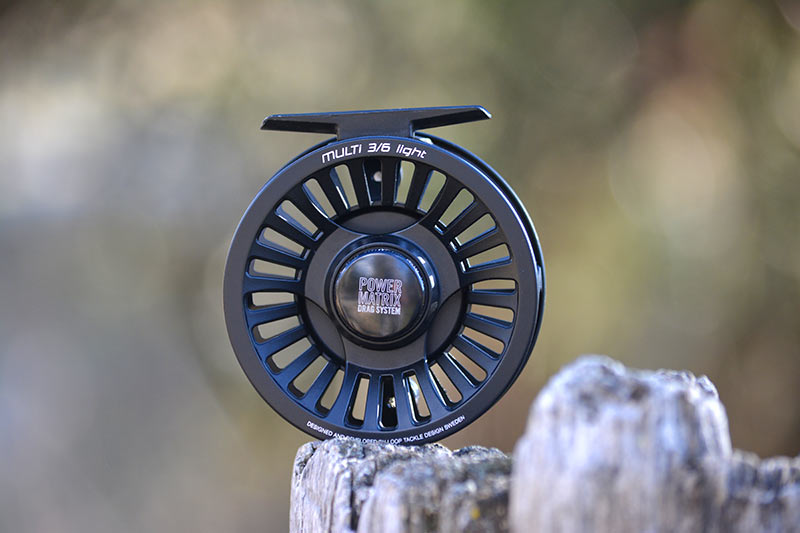
The Loop Multi series seem a little expensive for a non-machined reel die-cast in Korea. In the end the Loop Multi is a nice product, but other reels made in the US are equally nice and less expensive. We think Loop’s niche in the market is with high-end reels rather than less expensive reels, but that’s just our opinion.
Nevertheless, there are some features we like about the Loop Multi. The sealed “power matrix drag system” is maintenance free and has no start up inertia. The Loop Multi is also a full-framed reel, which helps add to its rigidity and durability. Spool to frame tolerances are very good. Loop also gives us their top-end handle, which is large and easy grip, with its sleek rubberized handle cover, even when wet. There’s a rubber O-ring on the counter weight, which serves as a tippet-storing device when you are aren’t using the reel. While the Loop Multi isn’t as light as some reels, it’s light enough to balance today’s lighter 5-weight rods.
Unfortunately the craftsmanship on the Loop Multi wasn’t as good as other die-cast reels. Our sample had two or three blemishes where extra metal remained stuck on the spool and frame. (Some of these chipped off later, leaving a little silver mark where the extra metal was once attached). The Loop Multi has a silent retrieval as well as a silent outgoing drag which we don’t like as much as reels with louder outgoing drags (the reel’s feedback gives you hints of what the fish is doing – running especially hard, or resting). The range of drag adjustment wasn’t particularly good, not to mention the max drag would only go up to 1.25 pounds. The spool cap comes off completely and can get lost.
Loop Multi reels are die-cast in South Korea and come only in black. Extra 3/6 spools retail for $79.
Notes:
Retrieval Sound: Silent sound reeling in
Outgoing drag sound: Silent sound going out – however you can hear metal hitting metal if you listen closely.
Spin: Good (2revs)? Not nearly as good as the Evotecs or the Opti reels however
Counterbalance: Very good
Spool Release: Easy but spool cap comes off and can get lost
Drag Knob: Not easy to turn, (thin knob)
Drag Detents: No detents but not easily knocked off by accident
Range of Drag: Very weak
Max Drag: Weak, larger fish will have to be palmed – 1.2 pounds
Handle: Nice rubber grip, but no swell
Feels light but cheap
Looks like Redington Behemoth spool
Could spin more for a spinner style reel
Detail with casting still has chunks and looks drippy in spots
#31 Aspen 325 MA $220 – reel, $110 x/spool
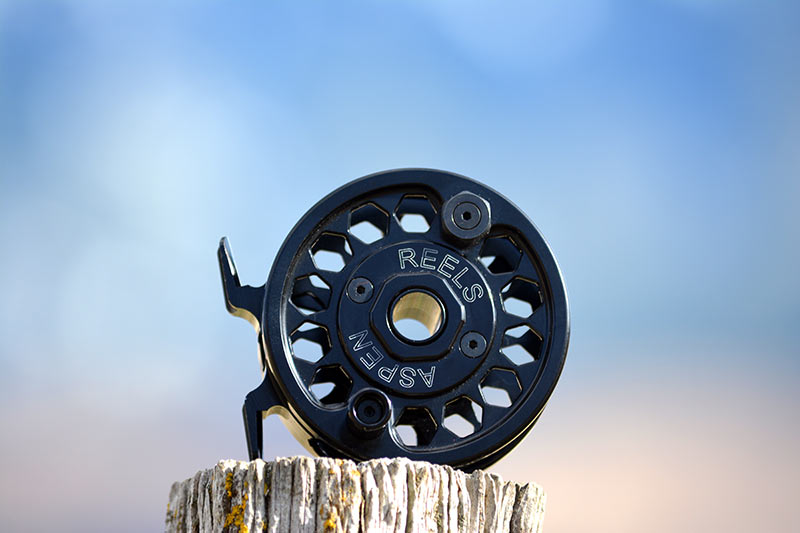
The Apsen 325 Mid Arbor is very similar to the 350 Large Arbor, just a little smaller and lighter, (although it can hold 35 yards more backing). The max drag on the 325 MA tested slightly higher than the 350 LA but was, for all practical purposes, the same. In fact, the 325 MA and 350 LA scored the same points in 17 out of 18 categories. (The 325 MA lost a couple of points since it did not have as wide a range of drag adjustment as the 350 LA).
The 350 LA also had more porting on the arbor, which will allow backing to dry faster. For not much extra weight (only .3 ounces more fully loaded) we think the 350 LA is the better performing reel as it will bring in line faster.
Either way, both the Aspen Reels are bulletproof. If your fishing style requires an especially tough reel and you can’t afford to get a Tibor or Abel – this is your reel. It will last a lifetime…
Despite the name, Aspen Reels are actually machined in San Marcos, California. The 325 MA comes in three standard colors: Black, Matte Black, or Clear (silver). Extra 325 LA spools retail for $110.
Notes:
Retrieval Sound: Pleasant plastic on metal incoming sound
Outgoing drag sound: Pleasant plastic on metal outgoing sound, perhaps “deeper”
Spin: pretty good 2.5-3.5 revs?
Counterbalance: Perfect
Spool Release: Reel pushes off frame easily – (can never lose spool release cap since no cap)
Drag knob: Easy to turn, (until the very highest drag settings)
Drag Detents: No detents but not easily knocked off by accident
Range of Drag: not very wide
Max Drag: Plenty Strong – 3.95 pounds
Handle: Great shape but could be a tad longer
Machined reel seat – can never come loose, might get dented if dropped however, which means replacing a new frame instead of reel seat.
Feels a tad heavy for its size, but very durable at the same time
Excellent spool to frame tolerances – some of the best in the test
#32 Ross Rapid 5/6 $110 – reel, $66 x/spool
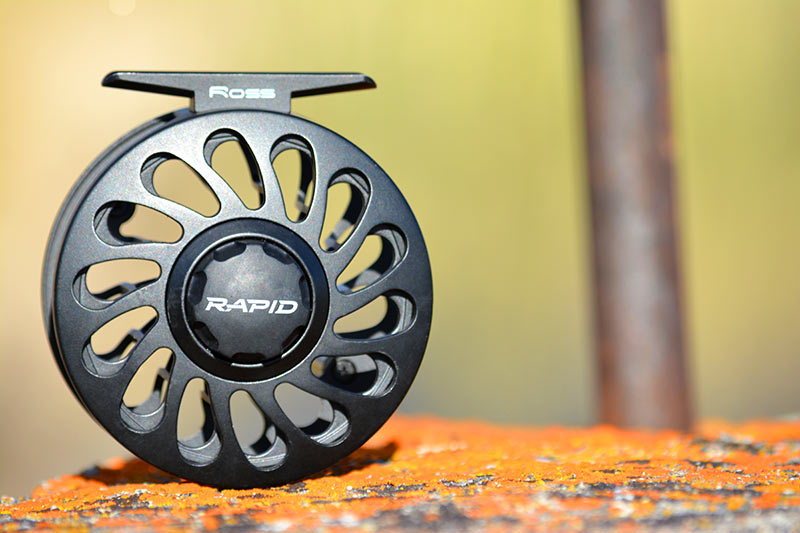
The Ross Rapid replaces the Ross Fly Rise, which was also $110 in the 5/6-weight size. While the Ross Rapid has its attributes, we think the Fly Rise (which was like an inexpensive Ross Evolution), was a much better reel.
The Ross Rapid does have a larger arbor however, which is well ported to help your backing dry faster. The Rapid’s maximum drag is also much stronger, which isn’t a big deal for us but for folks trying to use one reel for both fresh and saltwater, a drag that goes up to 8 pounds might be a plus. The Rapid spins well and has very little retrieval resistance. There is no start up inertia and the sealed drag is maintenance free. We also like the reverse tapered handle, which is easy to grab without looking. The paisley shaped cutouts look pretty cool and if the drag wasn’t so heavy this reel would be a lot lighter.
Unfortunately the Rapid is on the heavy side, weighing 7.4 ounces when fully loaded. What hurt it the most was its poor range of drag adjustment between .25 and 2 pounds. Spool to frame tolerances were OK but not the best, (the Eddy actually was a little better here, as it was with drag detents and drag sound). Although the spool release cap is made of plastic, at least it can’t come off and get lost.
We wish we could have the Fly Rise back, but crying over spilt milk won’t help any. Perhaps the problem was that Fly Rise was too good, and started to compete with Ross’ higher end reels. Or perhaps it became too expensive to make in the US. While the Rapid can’t hold a candle to the Fly Rise, it is still competitive with other reels in its price category.
The Ross Rapid is cast in South Korea and comes in two standard colors: Black and Charcoal Gray. Extra 5/6 spools retail for $66.
Like Bauer and Cheeky, Ross Reels donates 10% of each reel sold to the sport fish and wildlife restoration programs. They are also partnered with Trout Unlimited, the International Federation of Fly Fishers, the International Game Fish Association, and the Congressional Sportsmen’s Foundation. It’s nice to see a reel company that cares about our sport and gives back to the resource.
Notes:
Retrieval Sound: Silent retrieval sound
Outgoing drag sound: Muted plastic click sound going out
Spin: OK (2 – 2.5 rev)?
Counterbalance: Good
Spool Release: Spool release button – OK but tougher to undo with fat fingers
Drag Knob: Drag knob easy to adjust until you get to the higher settings
Drag Detents: OK but not as good as some
Range of drag: Good
Max Drag: Very strong! – 8 pounds
Handle: Larger and better than the Eddy, wide at the end where you need it and easy to grab
Feels more metallic than the Eddy, good price
#33 Ross Eddy 5/6 $75 – reel, $45 x/spool
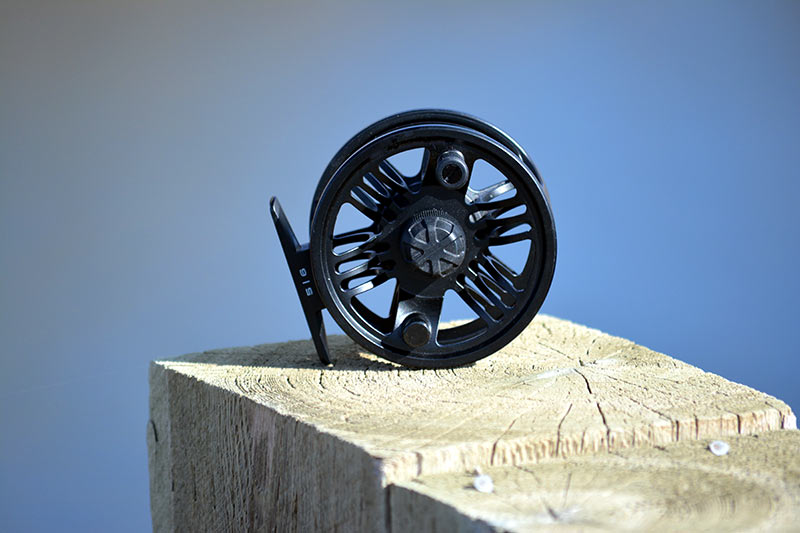
The Ross Eddy replaces the Ross Fly Start, (which was like an inexpensive CLA that retailed for $65 in the 5/6 size). In the same way we liked the Fly Rise better than the Rapid, we liked the Fly Start better than the Eddy. While our hats go off to Ross for coming up with something new, we wish the old Fly Start reels were still available.
The Eddy actually outscored the Rapid in a few categories, including spool to frame tolerance, drag detents, and drag sound. The 9-pound max drag strength was also stronger than the Rapid. If you’re looking for an inexpensive reel with an exceptionally strong drag the Redington Behemoth or the Ross Eddy are excellent choices.
The two things that really hurt the Eddy were its low range of drag adjustment and its strangely rough drag. When testing the smoothness of the Eddy, our Bouz drag checker’s needle bounced all over the place, ranging drastically as we pulled backing off the reel.
Although the spool and frame are made of aluminum, the reel looks and feels cheap. We found several nicks and scratches on the reel, just from keeping it in the same box as the other reels. The plastic spool cap can be difficult to get off, but at least it can’t come completely off and get lost.
The bottom line is that this reel only costs $75 and must be evaluated as such. When compared to other reels in its price category, (like Bass Pro, Okuma, or Cabela’s) the Eddy is clearly the way to go.
The Ross Eddy is cast in South Korea and comes in black only. Extra 5/6 spools retail for $45.
Like Bauer and Cheeky, Ross Reels donates 10% of each reel sold to sport fish and wildlife restoration programs. They are also partnered with Trout Unlimited, the International Federation of Fly Fishers, the International Game Fish Association, and the Congressional Sportsmen’s Foundation. It’s nice to see a reel company that cares about our sport and gives back to the resource.
Notes:
Retrieval Sound: Same loud plastic sound in or out
Outgoing drag sound: Same loud plastic sound in or out
Spin: Decent (1.5 -2 rev)?
Counterbalance: Good
Spool Release: Spool release button – can be very difficult to get off, cap can actually come off with too much force
Drag knob: easy to adjust until you get to the higher settings
Drag Detents: Click detents, drag is stiff enough that it won’t get knocked off easily
Range of drag: Not very good between .25 – 2 lbs.
Max Drag: Very strong! – 9 pounds
Handle: Nice and wide at the end where you need it, easy to grab
Lease expensive reel in the test
Feels heavy for the size but for $75 this is still a great value
Drag is not nearly as smooth as others
CLICK REELS
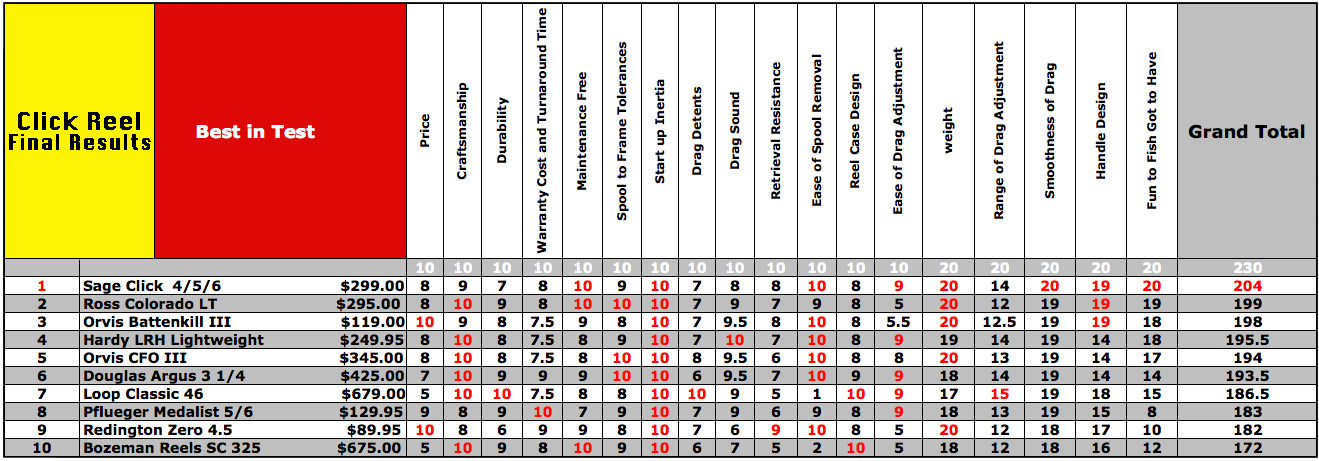
Since the classic click style reels performed very differently from the more modern reels, we decided to level the playing field and compare them against each other in their own “click reel” category. By nature, the click reels have a very weak maximum drag setting and have a very narrow range of drag adjustment. Some of these reels, like the Ross Colorado LT, Orvis Battenkill III, Redington Zero, and Bozeman Reels SC have no drag adjustment at all, meaning the angler is going to have to apply his or her own stopping pressure by palming or finger palming the reel. This is something every angler should learn to do anyway, regardless of what type of reel you end up purchasing.
When scoring the click style reels, we tried to keep things apples to apples by comparing them only against each other and not with the rest of the reels. In some categories (like ease of drag adjustment or handle design), 9 was the highest score because we felt there was room for improvement.
What these reels may lack in drag range and maximum drag performance they make up for with tradition and character. These timeless reels are built simply, with only a few moving parts, which means there are fewer parts to break. Some of the click reels are “click and pawl” styles which sound terrific and are the most classic. Others are more modern click style reels, weighing even less with larger arbors for quick line retrieval.
If you are looking for an attractive reel with great sound to match your bamboo fly rod, fiberglass rod, or fancy graphite rod, you’ll want to consider one of these reels.
#1 Sage Click 4/5/6 $299.00 – reel, $170 x/spool
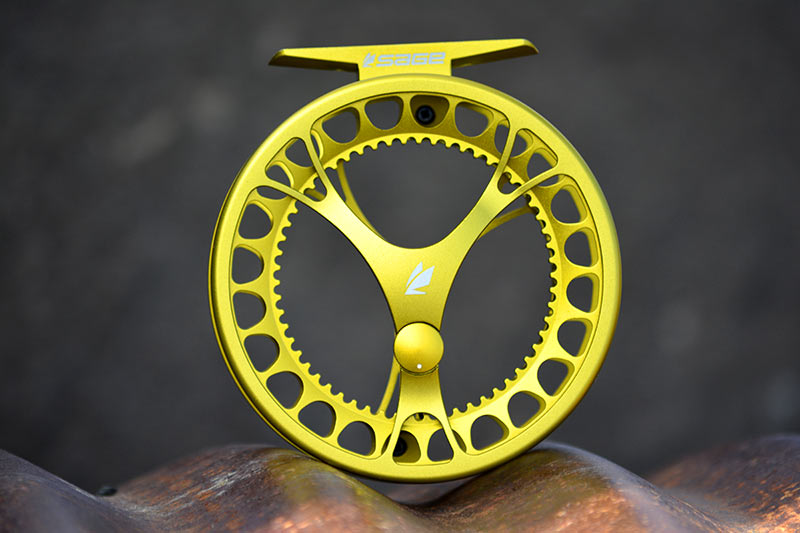
The Sage Clickis the newest addition to Sage’s reel family. At first glance the Click doesn’t appear to be worth $300, there’s really not much to it – but after thoroughly evaluating the Click, not having much to it is actually what makes it worth $300!
This reel is amazingly light for the size of the arbor! Weighing 4.1 ounces fully loaded, the Sage Click is clearly one of the very lightest reels in the shootout, second only to the Ross Colorado LT.
At 2.785 inches, the Sage Click also has one of the largest arbors in the shootout, second only to the massive Loop Evotec G4 LW 5/8. Although the Sage Click doesn’t spin quite like a Cheeky Boost or 3-Tand, it can retrieve line rapidly, helping you to get your slack line onto the reel quickly so you can fight the fish from the reel.
When you do get the line on the reel, you’ll want to palm the reel rather than relying on the Click’s drag strength. With a max drag of .2 pounds, the Click’s main job is to keep the line from free spooling, and the angler is going to be responsible for adding extra pressure during the fight. For experienced anglers this is not only easy, but half the fun. For inexperienced anglers this could be an issue until they learn how to palm the reel smoothly.
The drag is adjustable but it doesn’t really change the drag pressure much. We’re curious about the longevity of the plastic clicker, but if it does wear out at least it would be a cheap replacement. The drag proved to be very smooth, and the reel is maintenance free.
Overall, we were very impressed with the Sage Click 4/5/6. Its combination of lightness with a very large arbor will appeal to many anglers. We only wish it were a little less expensive. The Click must be a very profitable reel for Sage, since we know Ross can make and sell a similar reel here in the US for $295.
Notes:
Retrieval Sound: Plastic sound on both retrieval and outgoing
Outgoing drag sound: Slightly louder click sound going out, depending on drag setting
Spin: Not much but pretty good for a click style reel (1-1.5 rev)?
Counterbalance: A very slight wobble but hardly noticeable
Drag Knob: Drag knob easy to adjust
Drag Detents: None, but relatively stiff drag to twist keeps in place
Range of Drag: Extremely short but OK for a click style
Max Drag: Almost nothing, have to palm it for sure – .20 pounds
Handle: Nice size, could have a little more swell
Huge Large Arbor – reels line in fast
Feels extremely light in hand!
#2 Ross Colorado LT $295.00 – reel, $177 x/spool
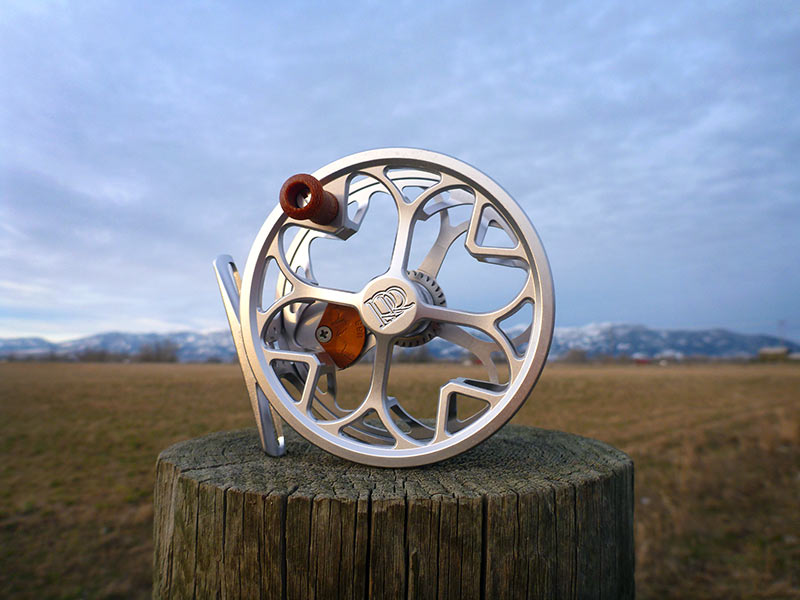
Despite the Colorado LT’s second place finish, it is the unanimous shop staff favorite for all the click style reels we sell. It looks great, feels light as a feather, has a large arbor design, sounds great, and feels durable to boot.
The Ross Colorado LT weighs the same as the Sage Click naked, but once it is fully loaded with 40 yards of backing, it weighed .1 oz less. While 40 yards is starting to push the limits on how little backing we feel comfortable with, we figured with click reels 40 yards is acceptable. Note that when spun up with a 406 DT-5-F line we were only able to get 10 yards of backing on this reel!
The Ross Colorado LT received 5 perfect scores, including craftsmanship, maintenance, spool to frame tolerance, start up inertia, and weight. It also tied the Sage Click and Orvis Battenkill III for the best handle designs. The Ross CO LT’s handle is a great shape and is made of a material that is supposed to be “grippy” even when wet. Had the handle been a tad larger it would have gotten a perfect 20 here as well.
One thing that amazes us is how Ross was able to get this reel so light, yet still feel so secure and durable. No doubt part of this is due to the highly detailed porting, which eliminates a ton of metal from the reel without compromising the strength (or thickness) of the remaining metal that makes up the spool and frame. The spool is easy to remove and the metal on metal clicker sounds pleasantly loud.
One thing that held the Colorado LT back is that there is no range of drag adjustment – period. But several of the click style reels were like this, including the Orvis Battenkill, Redington Zero, and Bozeman SC 325. Like most all of the click style reels, the Colorado LT has a very light maximum drag – you’ll have to be happy palming the rim of the spool to apply extra drag pressure when needed.
The Ross Colorado LT is fully machined from 14 different parts in Montrose, Colorado. It comes in three standard colors: Black, Platinum, and Light Olive. Extra 4/5 spools retail for $177.
NOTES:
Retrieval Sound: Metallic sound on both retrieval and outgoing
Outgoing drag sound: Slightly louder metallic sound going out
Spin: Not much but pretty good for a click style reel (1 rev)?
Counterbalance: A very slight wobble but hardly noticeable
Drag Knob: None
Drag Detents: None
Range of Drag: None – must palm it
Max Drag: Almost nothing, have to palm it – .25 pounds
Handle: Nice shape with swell at the end, could be a tiny bit longer. Handle supposed to be “grippy” when wet, we didn’t notice either way
#3 Orvis Battenkill III $119 – reel, $59 x/spool
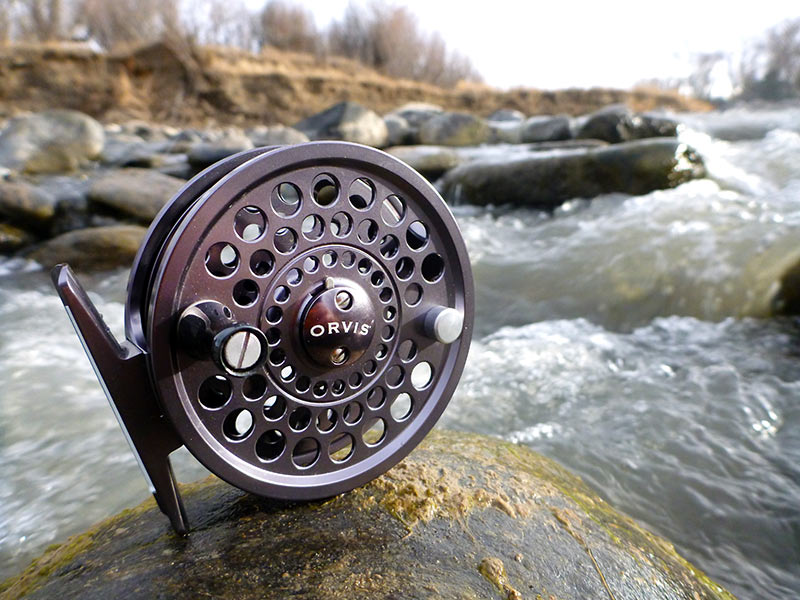
The Orvis Battenkill III rightfully takes the third tier of our podium finishers. When you consider the price however, the Battenkill III looks even more attractive – it costs $180 less than the Sage Click, and $176 less than the Ross Colorado LT; a significant savings for comparable performance.
The Orvis Battenkill III received perfect scores in 4 categories; price, start up inertia, ease of spool removal, and weight. It also did very well in craftsmanship, maintenance free, drag sound, smoothness of drag, and tied the Click and Colorado LT for the best handle design. As you can see, there is a lot of value built into the Battenkill III at a very affordable price.
Like most all of the click style reels, the Battenkill III has a very weak maximum drag, (.25 pounds), so it’s another reel you’ll have to palm should you hook up with a hot fish. Since the arbor isn’t very large, the Battenkill fits a lot more backing – 90 yards of 20# with an SA MPX WF-5-F or 80 yards of 20# with a 406 DT-5-F line.
Both ease of drag adjustment and range of drag adjustment suffered significantly. Although there is a way to make the drag stronger or weaker by turning the rectangular piece inside the reel, the drag resistance doesn’t change much. Like many of the click reels, the main purpose of the Battenkill’s drag is to keep it from free spooling.
The Orvis Battenkill III is machined in China out heavy- duty bar-stock aluminum. Solely in gray.
Notes:
Retrieval Sound: Nice loud metallic click and pawl sound on retrieve
Outgoing drag sound: Similar loud metallic yet deeper sound going out
Spin: Decent for a click and pawl (2 revs)?
Counterbalance: Not quite as good as others
Spool Release: Spool release is quick and easy like the Hardy LRH – can’t lose but over time dirt can get stuck in the space making it difficult to release properly – Still it can’t get lost unless screws come off.
Drag Knob: None
Drag Detents: None – have to palm
Max Drag: Very weak, have to palm – .25 pounds
Handle: Nice length and swell
Good reel for bamboo or fiberglass
Narrow arbor good for Double Taper lines
Looks and sounds like a true classic
Reel could be bigger, and for a spinner could spin more
Feels a bit heavy (due to heavy drag mechanism)
Handle – nice shape and size (good swell)
A lighter reel with slightly less drag would be better for a 5 weight
Still a great all around reel
#4 Hardy Lightweight LRH $249.95 – reel, $99 x/spool
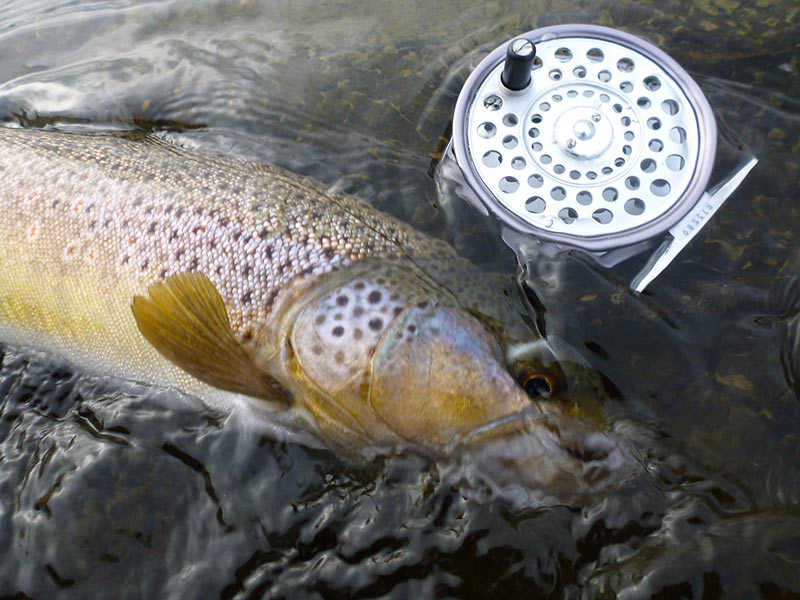
Here’s another classic reel that has caught a lot of fish over the years. Historically it is one of the most coveted reels we know. It remains one of the best click and pawl style reels available. It looks fantastic when matched with classy graphite, fiberglass, and bamboo rods.
At 5.1 ounces (fully loaded) Hardy LRH Lightweight isn’t as light some of the lightest click style reels, but it is still exceptionally light and balances well with today’s 5-weight rods. Craftsmanship is a 10, as is start up inertia and ease of spool removal. The drag is easy enough to adjust (although there is very little difference between full choke and wide open). We awarded the LRH Lightweight the only perfect score on drag sound. Simply put, the outgoing sound on this reel is music to the ears, especially when a fish takes off quickly in a blazing pull. We also like how the full frame design offers the LRH more rigidity and durability if dropped. The fact that the spool is now machined instead of cast also adds to the LRH’s strength and integrity.
As a click and pawl retrieval resistance isn’t great, so don’t plan on much spin out of her. As expected, the range of drag adjustment isn’t great either. If you hook a big fish you’ll have to palm the reel – however since it is a full frame design, you’ll have to “finger palm” it, which is easy enough to get the hang of it. The one thing we really don’t care for on the LRH is the tiny, straight handle. Presumably a more modern handle would make it more functional but also make it look less traditional.
Currently the Hardy LRH Lightweight is fully machined in South Korea from high-grade aircraft aluminum. We hear rumors that all the classic style reels will be made in England again, starting in 2017. The LRH only comes in one standard color: Silver / Grey. Extra LRH spools retail for $99.
NOTES:
Retrieval Sound: Similar metallic sound in or out
Outgoing drag sound: Slightly louder sound going out
Spin: Not much (.75-1.25 revs)?
Counterbalance: Decent – despite no counter weight
Spool release: Quick and easy and the latch can’t get lost, (unless entire fixture comes off. Over time dirt and grit can fill in the latch hole, making it difficult to move the latch).
Drag Knob: Easy to turn
Drag Detents: None
Range of Drag: Very weak – have to “finger” palm bigger fish
Max Drag: Weak – have to “finger palm” this reel – .35 pounds
Handle: Too small, could have some swell, over time these can loosen up
Line guard must be switched if reel direction is switched
Classic look and feel – great for bamboo, fiberglass, classic fly rods
#5 Douglas Argus 3 ¼ $425 – reel, $175 x/spool
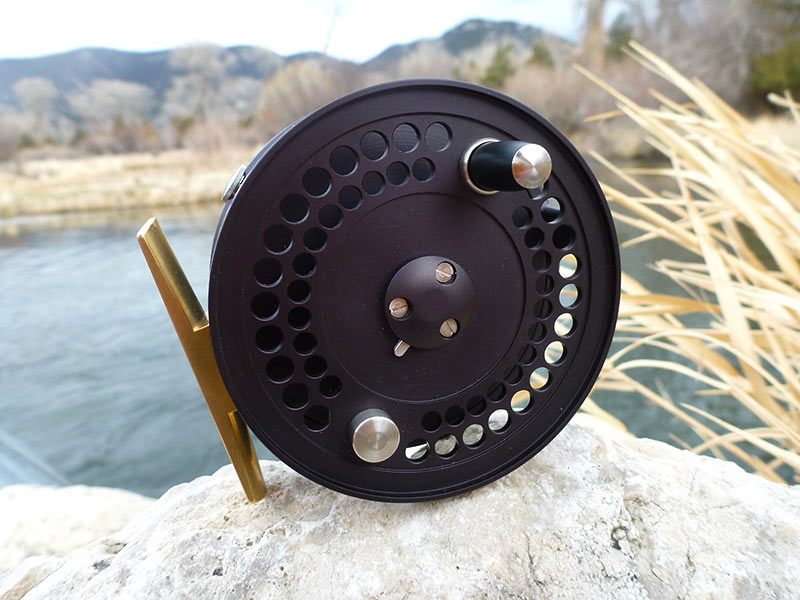
The Douglas Argus is a finely machined reel made in upstate New York. It is elegant both in looks and sound, however Douglas makes you pay for it.
The Argus scored a perfect 10 in craftsmanship, spool to frame tolerances, start up inertia, and ease of spool removal. It also scored very high in durability, warranty, maintenance free, smoothness of drag, and drag sound, which really can be considered a 10 as well. The sound just echoes off the solid back of the frame and is sure to please nearly everyone who fishes one. The Marine Brass foot gives the reel a little extra pop and pizzazz.
There are no detents, however, the range of drag adjustment isn’t much, and the max drag is only .35 pounds. The Argus comes with a laser textured palming rim. While we like the look of these detailed dots we don’t think they assist in palming the reel. The handle is longer than the CFO and the LRH, but it tapers down instead of swelling out. Although the Argus’ standard smaller arbor allows for more backing (150 yards of 20#), once fully loaded this actually makes the reel heavier than it needs to be for matching the lightest graphite rods. Still, this may be a good thing for balancing heavier, longer fiberglass and bamboo rods.
One thing we noticed with the Argus is that the finish scratches easily. From just sitting in the box with the other reels the Argus was scuffed up pretty badly, so be mindful not to put it down on the rocks.
The Douglas Argus is fully machined in Phoenix, NY from heavy-duty aircraft grade aluminum. The Argus comes only in Charcoal Gray. Recently Douglas has added a “classic” spool which is not ported, for a more traditional look at no extra price. Extra 3 ¼ spools retail for $175.
Notes:
Retrieval Sound: Excellent metallic sound reeling in
Outgoing drag sound: Even louder metallic out going sound
Spin: almost none (1-1.2 revs)?
Counterbalance: Excellent
Spool Release: Spool release is quick and easy like the Hardy LRH – can’t lose but over time dirt can get stuck in the space making it difficult to release properly – Still it can’t get lost unless screws come off.
Drag knob: Easy to turn, even if it does get knocked off it won’t change much
Drag Detents: None
Range of Drag: Very weak – have to palm it
Max Drag: Very weak – have to palm it – .35 pounds
Handle: Could flare out more, could be longer
Nice, but purely cosmetic spot details on the rim of spool
Very small arbor – slow reeling in but plenty of room for Double Tapered lines
#6 Orvis C.F.O. III $345 – reel, (extra spools not yet available)
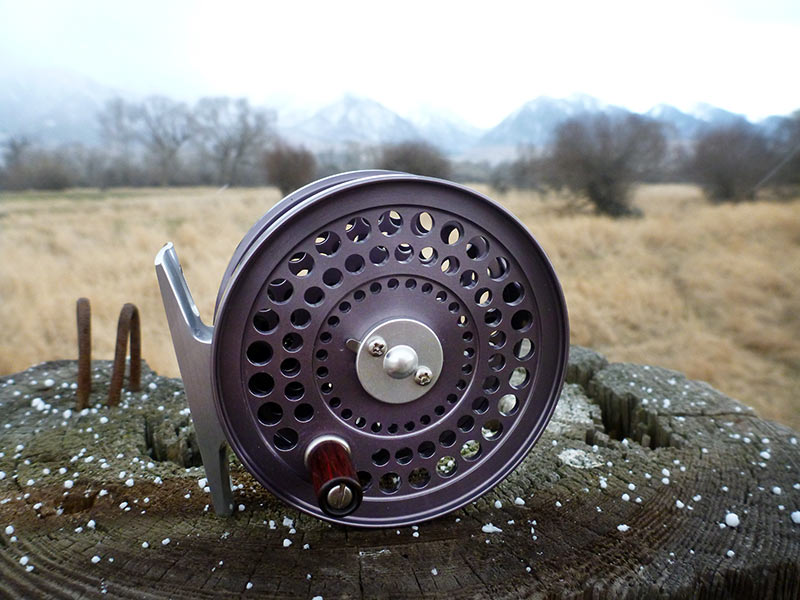
(Now precision machined by Abel)
The C.F.O is a great reel that brings 140 years of tradition to the table. It also brings a solid amount of performance, scoring a perfect score in five categories: Craftsmanship, Spool to Frame Tolerances, Start Up Inertia, Ease of Spool Removal, and Weight. In addition to that, the C.F.O. has a very smooth drag and a fantastic metallic sound.
As a click and pawl reel, the C.F.O. doesn’t have a very strong drag, and the range of drag adjustment is also relatively narrow. Its retrieval resistance is quite high; it is nearly the opposite of a spinner type reel. Although the rosewood handle is beautiful, we wish it were larger and had more swell like the Abel handles.
The C.F.O. is a classic and sharp looking reel. Everything about it speaks of heirloom quality. This would be a great match for any classy graphite, fiberglass, or bamboo rod.
At one point the C.F.O was made in England by Hardy. Today it is fully machined by Abel in Camarillo, California from the highest quality bar-stock aluminum. The C.F.O. only comes in Slate Gray. At this point extra spools are not available but Orvis claims they will become available by 7/1/2016.
NOTES:
Retrieval Sound: Nice metallic click and pawl sound on retrieve
Outgoing drag sound: Similar metallic but deeper sound going out
Spin: Almost none (.5 – .85 revs)? Depending on drag setting
Counterbalance: OK, despite no counter balance weight
Spool Release: Quick and easy and the latch can’t get lost, (unless entire fixture comes off). Over a period of time dirt and grit can fill in the latch hole, making it difficult to move the latch.
Drag Knob: Good, easy to turn
Drag Detents: No detents but the drag knob is stiff so it won’t get knocked off its setting easily
Range of Drag: Good for a click and pawl reel, but weak compared to others
Max Drag: Very weak – .4 pounds
Handle: Too short and no swell, although rosewood looks nice
Narrow arbor good for Double Taper lines
Looks and sounds like a true classic
Abel grease smell and quality machining
#7 Loop Classic 46 $679 – reel, (extra spools not available)
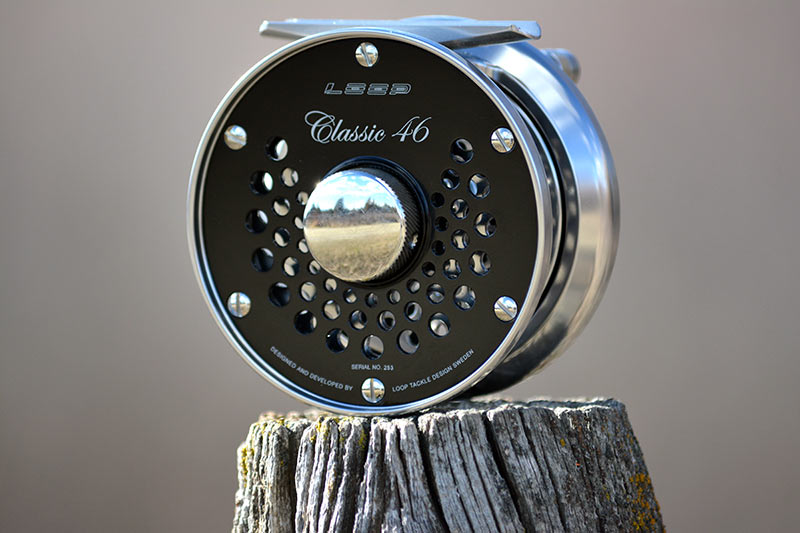
The Loop Classic reels are visually stunning. If you planned a trip to England to fish their famous chalk streams wearing tweeds, this would be the reel with which to accessorize. Everything about it looks refined and dignified, from the classic “S” handle to the beautifully contrasting jet black plates.
The Loop Classic has a number of great features. It has the strongest maximum drag of all the click reels at 1.25 pounds, (everything else was under .5 pounds). Strangely, when you crank up the drag setting, the retrieval resistance is mirrored, making it much harder to reel in. We suggest keeping the drag on a relatively light setting, and finger palming the reel if you need more stopping power.
Craftsmanship, durability, start up inertia, drag detents, and reel case design (a fancy and expensive looking leather case) were all solid 10’s. The Loop Classic 46 also had a loud metallic outgoing drag sound, and had a very smooth drag. The arbor is also one of the few ported arbors, (along with the Click and Colorado LT), allowing your backing to dry faster.
Perhaps the biggest downside to the Classic 46 is the weight. Fully loaded, it was the heaviest click style reel at 7.9 ounces. The two things that hurt the Loop Classic 46 the most were the price and the difficulty in removing the spool. Loop uses Loc-Tite on all their reels, making it a major undertaking to remove the 6 flathead screws in the shop much less on the stream. Even if you are able to turn the screws, it’s going to be especially difficult not to scratch the beautiful black plate.
The Loop Classic 46 is fully machined in South Korea from the highest quality aircraft aluminum. The Classic comes in one standard color: A black and silver combination. Due to the difficulty of spool removal no extra spools are offered.
Notes:
Retrieval Sound: Deeper metallic sound reeling in than other click reels
Outgoing drag sound: Same deeper metallic sound going out
Spin: Depending on drag setting nearly none to one ( .1- 1 rev)?
Counterbalance: Perfect
Spool Release: No Spool cap, No quick change – 6 screws to get the spool off, (all of which seem like they are Loctited into the reel) – a major project in the shop, much less out on the stream
Drag Knob: Groovy and easy to turn
Drag Detents: Excellent detents keep the drag setting from getting bumped off
Range of Drag: Best out of all the click style reels, but still weak compared to other reels
Max Drag: Best of all the click style reels but still weak compared to others
Handle: Good size, metal grooves for grip, but no swell
Awesome classic look, fantastic for photos
Looks great on classy graphite rods, bamboo rods, and fiberglass
Heavy but feels durable
When you turn up the drag, you feel the same resistance reeling in
Can’t palm the reel – have to finger palm it
#8 Pflueger Medalist 5/6 $129.95 – reel, (extra spools not available)
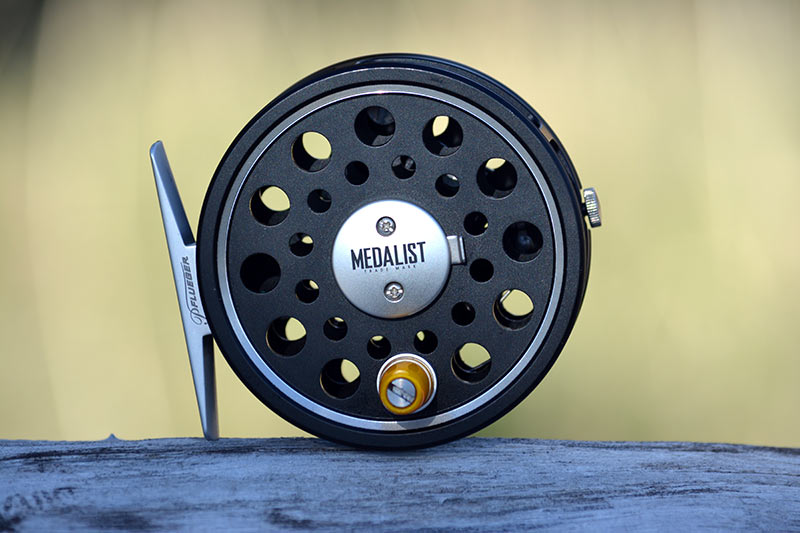
Here’s another reel that has landed countless trout over the years. After a rather long hiatus, the Pflueger Medalist is back in action. We think a lot of people will appreciate the old school look of this reel, perhaps the reel is even reminiscent of their childhood.
The Pflueger Medalist had a very smooth drag and no detectable start up inertia. The spool to frame tolerances are very good and the spool is easy to remove. The Medalist’s full frame design adds rigidity and durability to the reel. The drag sounds great and the price is right.
The range of drag adjustment isn’t very good (although at least it is adjustable). Max drag is only .5 pounds, so for larger fish you’ll have to palm the reel, which you can do along the rim of the spool instead of finger palming it. The Medalist has the capacity for a huge amount of backing, (175 yards of 20#!), which unfortunately makes the reel much heavier than it needs to be when fully loaded. The handle is pretty big and easy to grab, however the taper gets smaller towards the end rather than swells bigger.
The Pflueger Medalist is fully machined in South Korea from heavy-duty aluminum. The Medalist comes in one color: Black with silver hardware and a yellow handle.
Notes:
Retrieval Sound: Loud metallic sound reeling in
Outgoing drag sound: Similar loud metallic sound going out
Spin: Very little (1 rev)?
Counterbalance: No counterbalance weight – more wobble than others
Spool release: Easy to take off, although full frame makes it slightly tougher than non full framed reels. Can’t lose latch.
Drag Knob: Easy to adjust
Drag Detents: No detents but stiffer than others, minimizing it getting knocked off by accident
Range of Drag: Very weak, despite many turns
MAX DRAG: Weak – .5 pounds
Handle: Attractive and distinctive yellow handle, good size however flare gets smaller towards the end instead of larger (like the Argus)
Classic look and feel – tons of room for backing or a DT line
Reel feels much heavier when fully loaded
Visually a great match for glass rods
#9 Redington ZERO $89.00 – reel, $49.95 x/spool
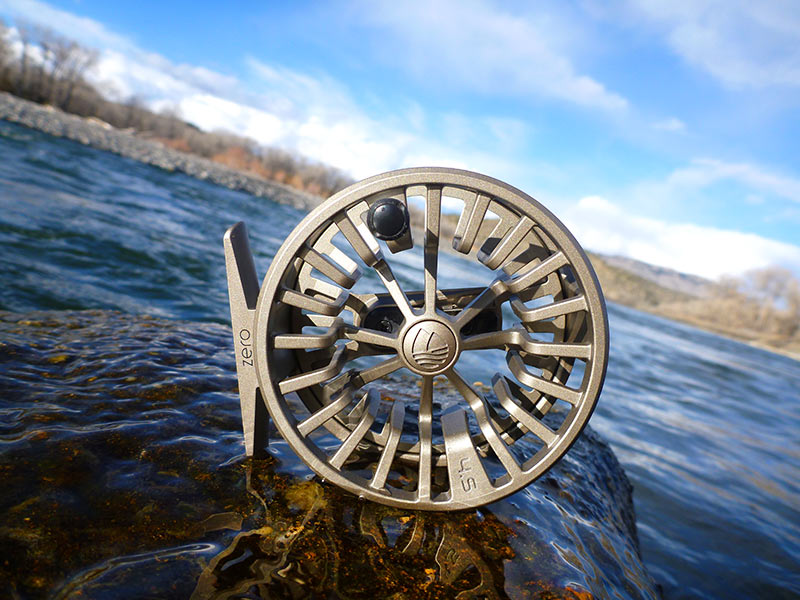
A lot can be said for the Redington Zero. Who else is making a 5-weight reel that weighs 3 ounces and costs only $89.00? Sure, it might sound like you’re cranking up your boat at the boat ramp, or whirling around a New Year’s eve noise maker but who cares? For the money, the Redington Zero is a great reel, as long as you don’t mind palming it to add extra resistance for fighting larger fish.
The Redington Zero’s claim to fame is certainly its weight to price ratio, but it also has a few other good features, like zero start up inertia and one of the best spool removal designs. It’s maintenance free and the warranty is very good should there be an accident. Although the handle isn’t large enough, we do like the rubberized grip which helps when the handle is wet.
Perhaps the biggest downside to the Zero is that it isn’t going to be as durable as fully machined reels. The Zero also lost points under drag adjustment and range of drag (since there is no adjustment). At least the clicker keeps the reel from free spooling, the rest of the drag is going to be left up to the angler.
If you are looking for an inexpensive reel there are two obvious choices: the Ross Eddy, (which is heavy but has a very strong drag), or the Redington Zero (which is insanely light but has almost no drag). The other option is to upgrade to the Lamson Liquid that is a compromise between the Eddy and Zero.
The Redington Zero is die-cast in South Korea. It comes in two standard colors: Black and Sand. Extra 4/5 spools retail for $49.95.
Notes:
Retrieval Sound: Same metallic sound in or out, sounds like a boat crank or a tin noise maker at a New Year’s eve party
Outgoing drag sound: Same metallic sound in or out, sounds like a boat crank or a tin noise maker at a New Year’s eve party
Spin: Best of all the click style reels – (1.5-2 revs)
Counterbalance: Not good
Spool Release: Spool release cap depresses like Ross Evolution – can’t lose – very quick and easy
Drag Knob: None
Max Drag: Very weak – (the weakest of all click style reels) – have to palm it
Handle: nice rubberized coating for easy grip, could be bigger, use a little swell at the end
Reel seat is cast in – possibly good since you can’t lose it but if you drop it and it bends or breaks you’ll have to replace the frame instead of just a reel seat
Makes noise when casting hard, double hauling
Feels and sounds cheap
#10 Bozeman Reel SC 325 $675 – reel, (extra spools not available)
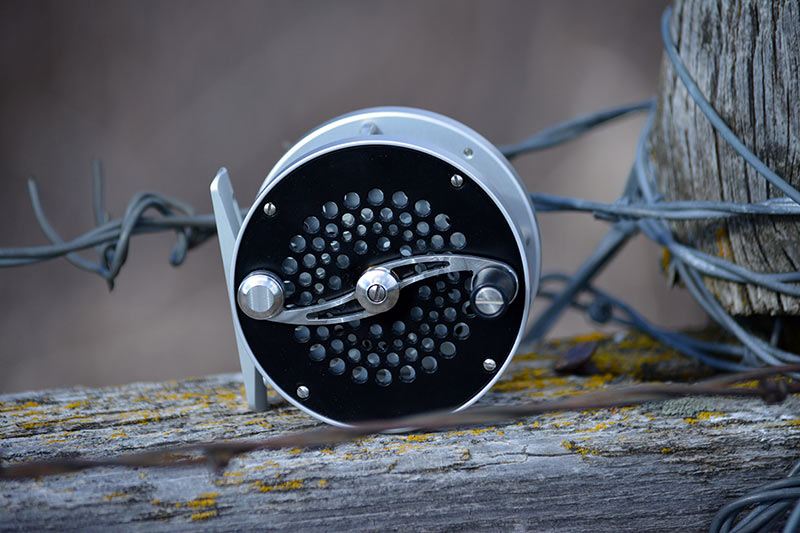
We were all surprised to see the Bozeman Reel SC 325 at the bottom, especially since we sell quite of few of these and like them a lot. But when we added the figures up, it simply didn’t do as well as the other click style reels. Sometimes a reel is made for visual appreciation rather than strictly for its performance.
The SC (Stream Creek) is just that, and is a reel that only certain anglers will appreciate. The SC 325 is a very classy reel. In fact we see these reels on Tom Morgan rods more than any other reel (many are even have the Tom Morgan logo laser engraved on the back).
The Bozeman Reel SC 325 received 4 perfect scores; craftsmanship, maintenance free, zero start up inertia, and reel case design (a classy and colorful canvas case with a Montana elk antler button). The SC 325 also has a smooth drag, and spool to frame tolerances were excellent.
A couple of things held the SL 325 back. Number one is the price. Number two is how difficult the spool is to change. In order to get the spool out of this classic reel you have to remove 4 tiny flathead screws, followed by the black side plate. It’s hard enough not to lose these screws in the shop much less on the river, so the SC lost points accordingly. The retrieval resistance is quite significant with the SC, it is the opposite of a spinner, which makes picking line up quickly more difficult. The SC 325’s arbor is also quite small, which also makes for slower line retrieval. Ease of drag adjustment and range of drag adjustment suffered because there is no drag adjustment – what you see is what you get. Like the LRH and C.F.O. III, the handle is too small and not as easy to grab as larger handles. The rubber drag clicker is relatively quiet although much more pleasant than the Redington Zero’s drag sound.
Overall the Bozeman SC 325 isn’t a high scoring (or performing) reel, but it does look amazing and a lot of attention to detail is evident. Opting for this reel depends on what you are looking for in a reel; for many having a classic looking reel on a classy rod just “looks the part” even if it doesn’t wind line in at 8.5” per rotation or weigh under 3 ounces.
The Bozeman SC 325 is precision machined at their impressive facility in Bozeman, Montana from the highest quality aircraft aluminum. The SC series only comes in one color: black and silver, (although custom full black reels are available through Tom Morgan Rodsmiths). The SC reels come standard with a colorful hand made canvas reel case, which includes a Montana elk antler button and a wooden gift box. At this point extra spools are not currently offered.
Notes:
Retrieval Sound: Muted rubber on metal sound
Outgoing drag sound: Sounds a tiny bit louder going out
Spin: Almost none (.5 revs)?
Counterbalance: Good
Spool Release: No Spool cap, No quick change – 4 tiny screws to get the spool off, a major project in the shop, much less out on the stream
Drag Knob: None
Drag Detents: None
Range of Drag: None
Max Drag: Very Weak – .5 pounds
Handle: Very short with no swell
Small arbor – good for DT lines
Reel seat is machined in (good can’t lose), but if you drop it and bend it you’ll have to replace the whole frame instead of just a reel seat.
Same resistance when reeling in or going out – not adjustable so you’ll have to “finger palm” it
Drag may not be light enough for 7-8X users

We appreciate your support!
We hope that you have enjoyed our 2016 5/6-weight Reel Shootout. With your support, we can continue to give you more shootouts and comparisons on tackle and equipment in the future. But this takes a lot of time, so if you’re in the market for a new rod or outfit, or other flies and tackle, we would love to have your business! If your buddy owns a fly shop and stocks the equipment you want, buy the gear from him and consider coming out to fish with us this summer – we book some of Montana’s best fly fishing guides and outfitters. In general, the best time to come is July – August.
Be sure to e-mail us your comments and any questions you have about the exact tackle you need for the fishing you are doing. We’re happy to help.
– George and James Anderson